Home » User Guides
Customise Dashboard
Users can plot custom graphs based on the data provided. The page shows two fields:
1. Saved Graphs
2. New Graphs
To create a new graph, click on the new graph.
Select the entity.
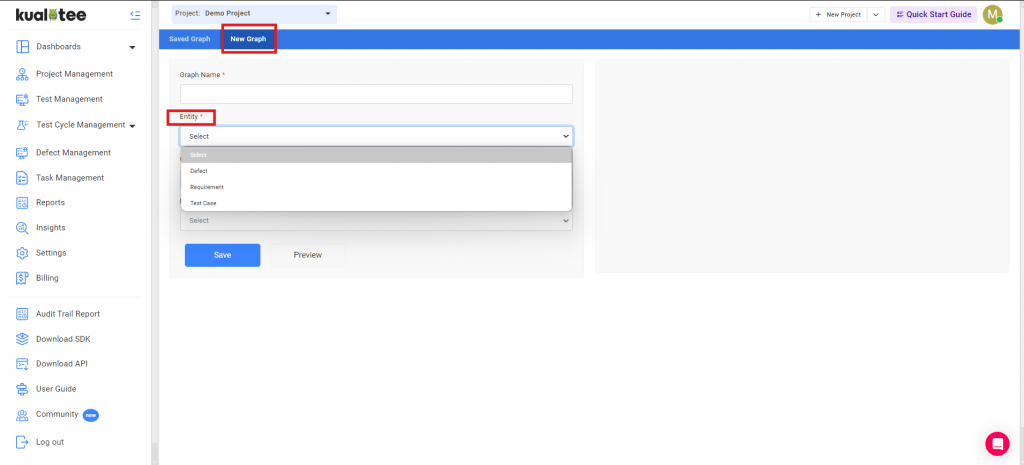
After selecting the entity you can select the graph type as per your requirement.
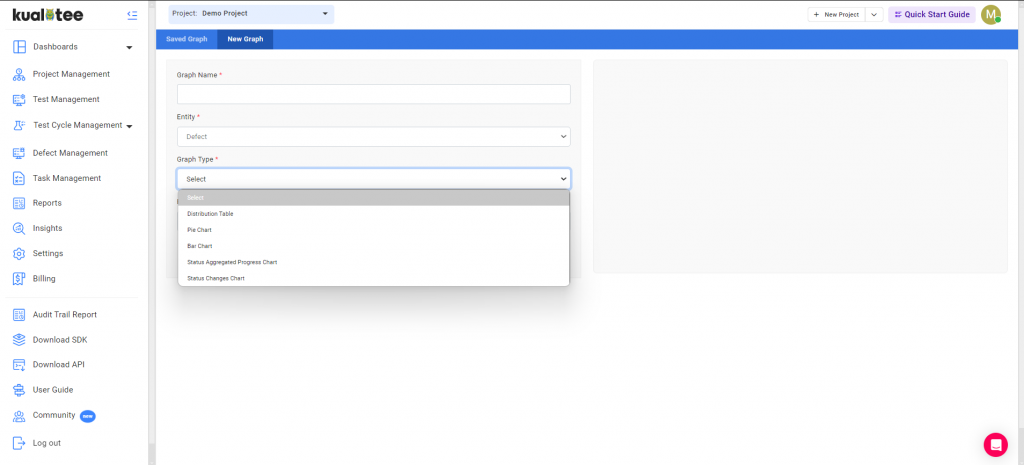
Then select the category to mention on the axis.
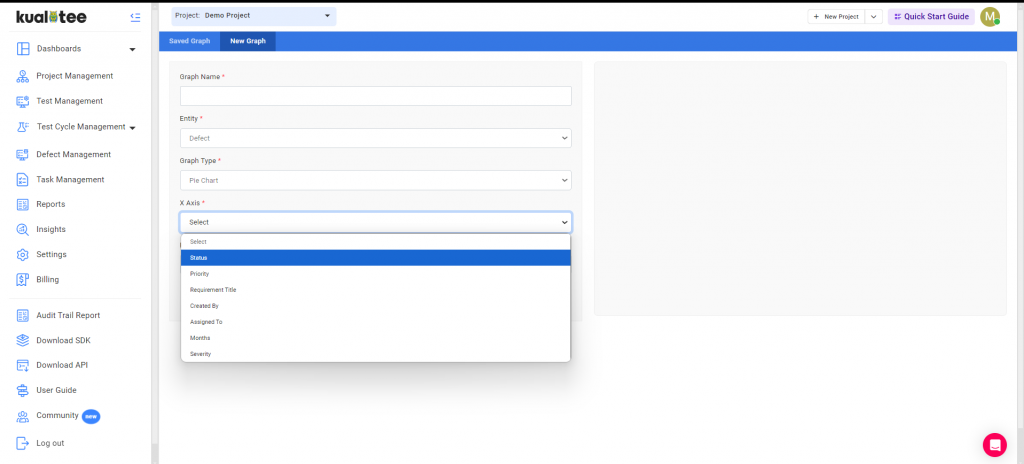
Then add the filter you require.
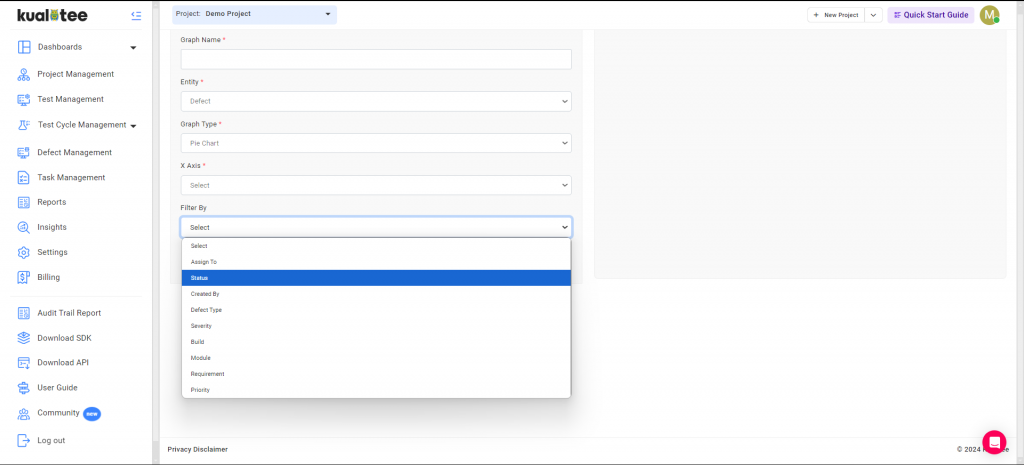
Then proceed to save the graph. You can view your graph in ‘saved graphs’.
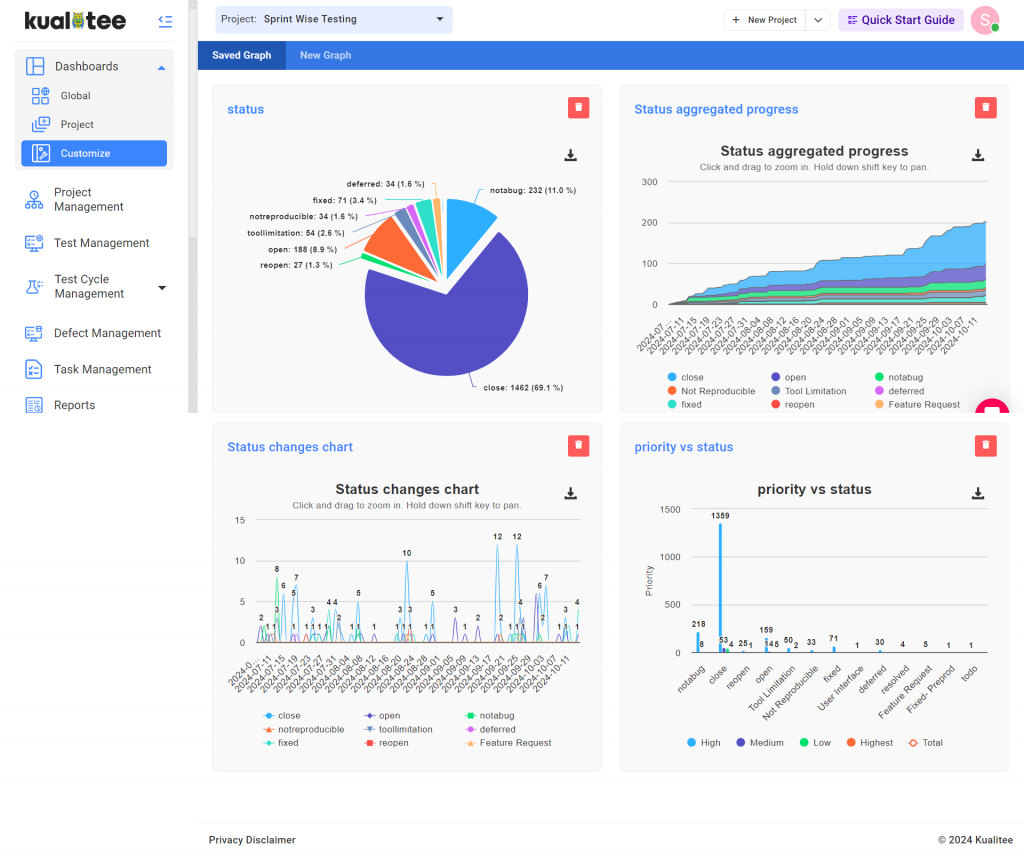
Project Dashboard
Kualitee can be used in both darker and lighter themes. To change the theme, at the top right corner click on the profile button and then you can change the theme with the help of toggle.
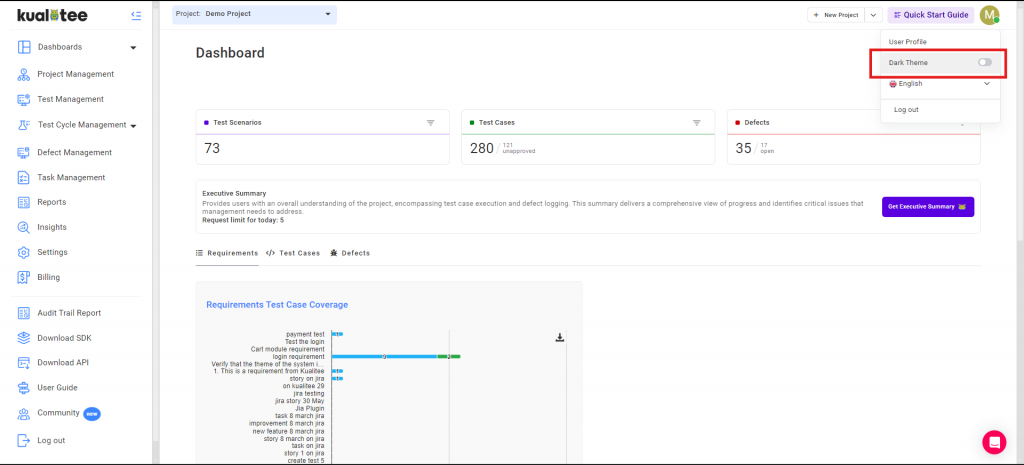
Three activities are shown here on the top of the dashboard, as follows:
Test scenarios: Stating number of Test Scenarios against project.
Test case: Stating number of Test Cases against project.
Defects: Stating number of Defects against project.
The following graphs are displayed.
- Defects by Severity: Refers to the severity of the defect being logged with filter.
- Defects by Status: Refers to status of the defect logged with filter.
- Test Cases Status: Refers to the current status of the test case with filter.
- Executed Test Cases: Refers to the test cases which have been executed with filter.
- Pie Charts: Can be accessed by clicking on any bar graph to analyze the number of defects considered, which led to a particular result.
- Test Case Progress: Shows number of test cases executed at specific intervals of time.
- Defect Closure Efficiency: Shows number of total defects and resolved defects.
- Active Defects: Shows number of unresolved defects against specific intervals of time.
- Defects Reopened: Shows percentage of defects reopened against specific intervals of time.
- Test Cases Fail: Shows percentage of failed test cases.
- Bug Fix Duration Days: Shows the number of days it took to fix a particular bug.
- Requirements Test Case Coverage: Shows coverage of requirements against cases.
- Bugs Statistics: Shows status of bugs – reported, fixed, open and others.
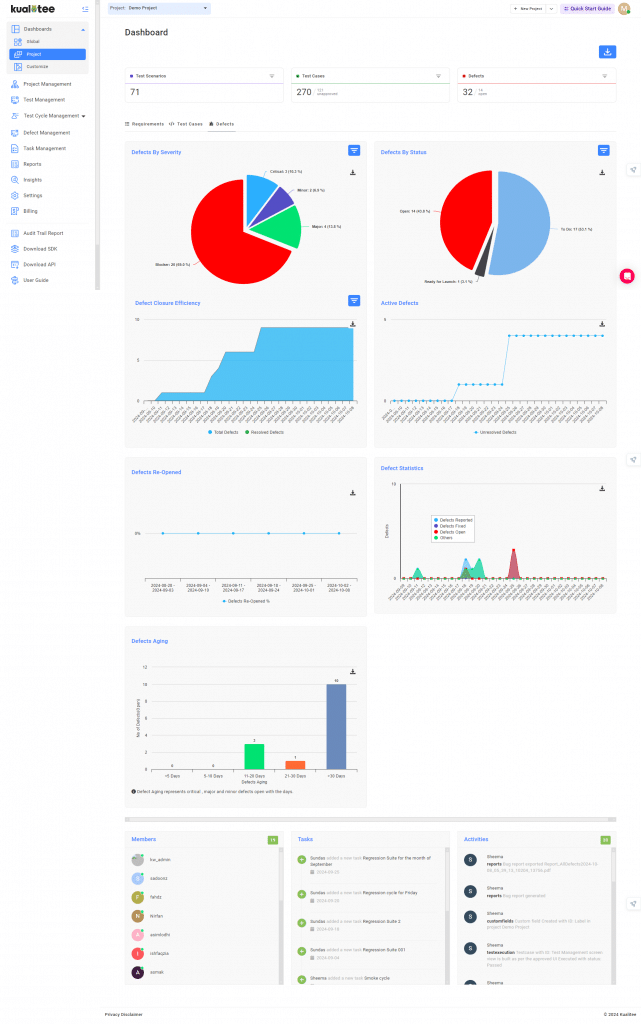
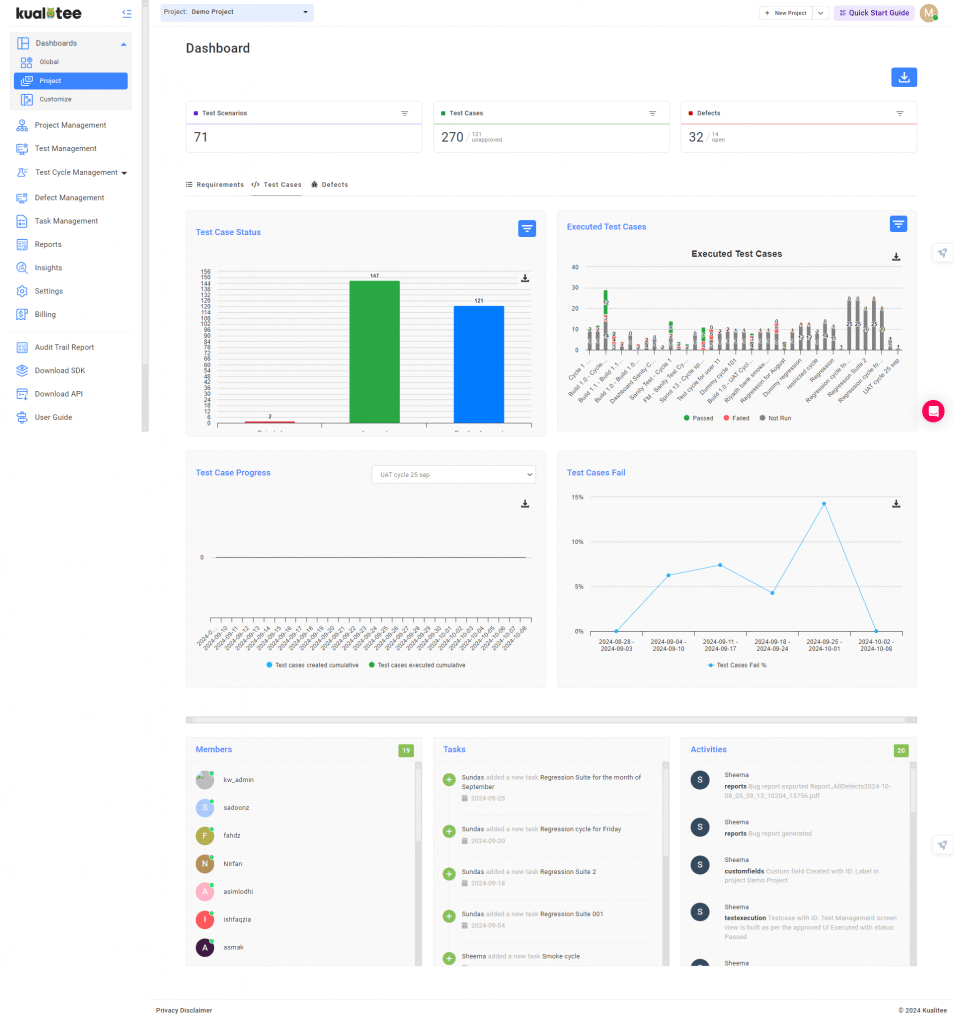
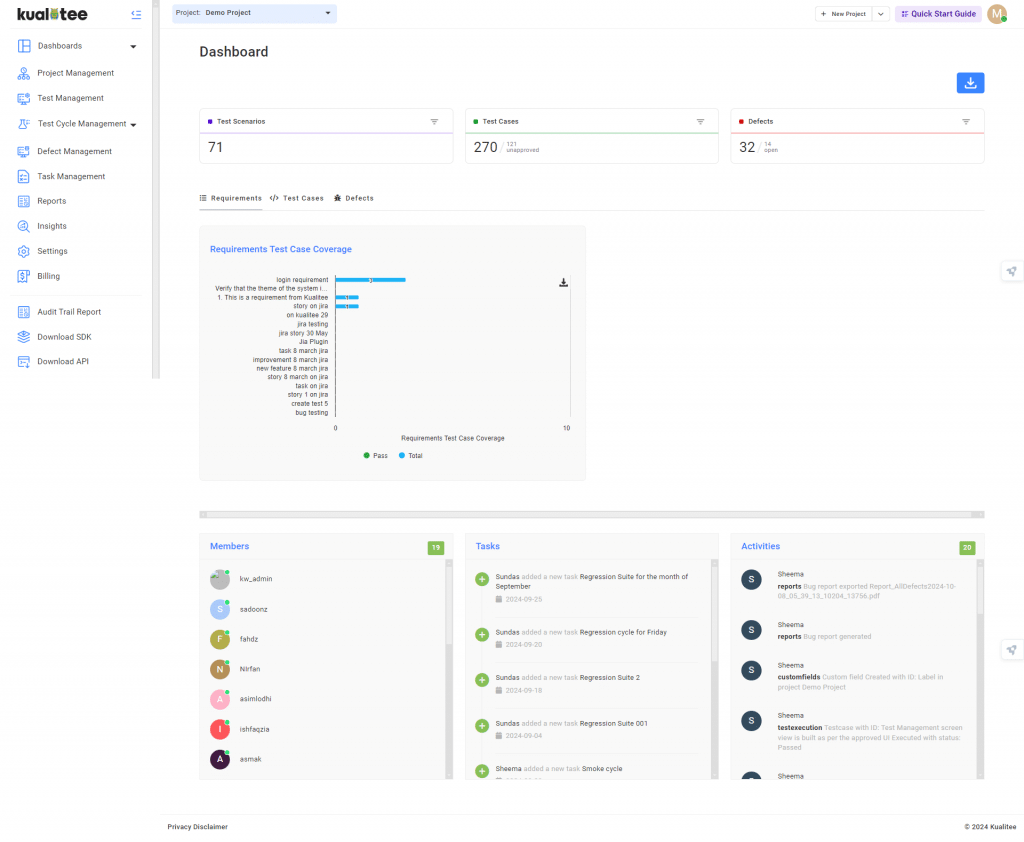
Global Dashboard
Along with our comprehensive Dashboard that is organized project-wise, now you will also be able to see a Global Dashboard comprising data related to Defects for all the projects you are a part of, in one place.
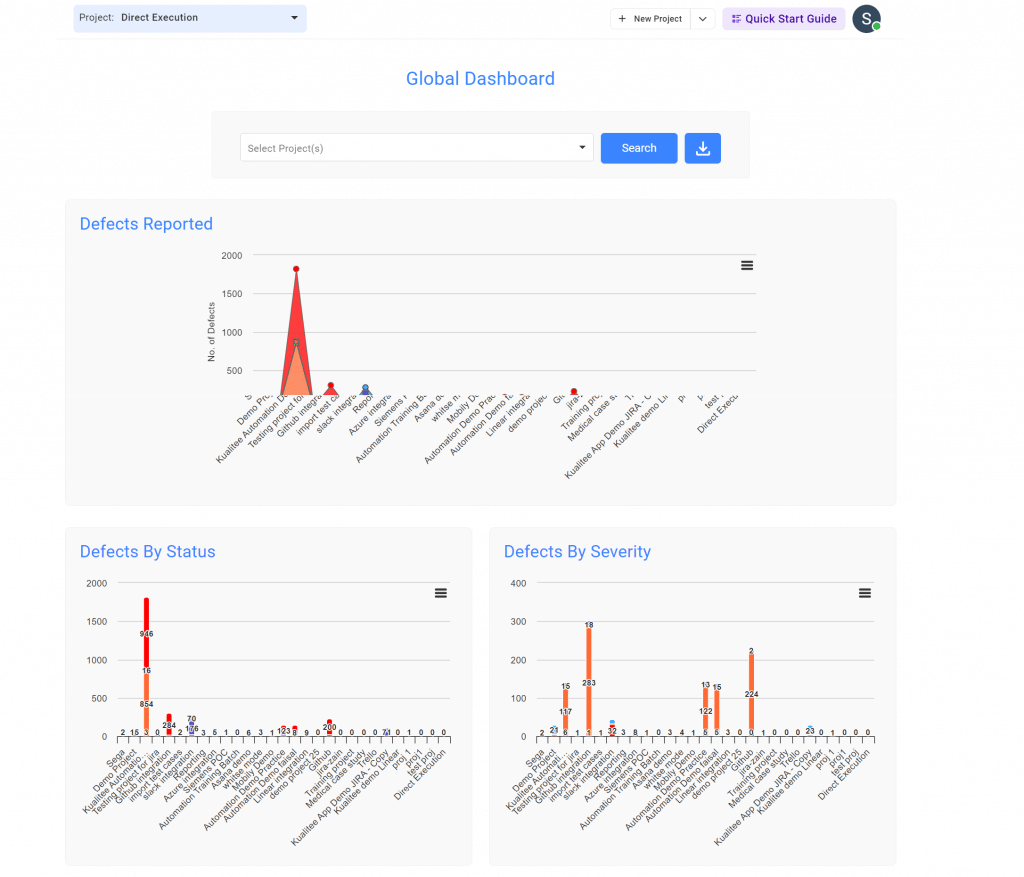
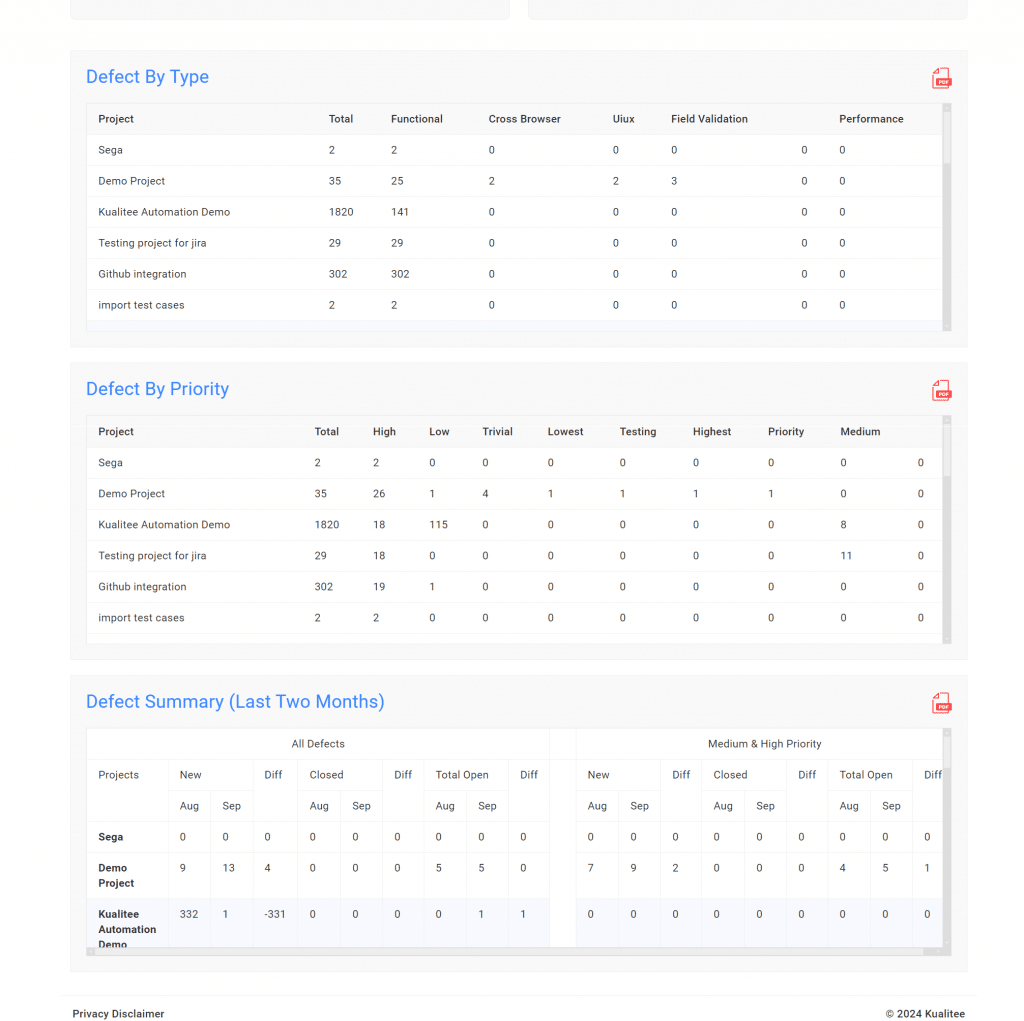
How this feature will help you:
If you need to see the data for all the projects, you can check the Global Dashboard and have a quick overview of all the stats of defects according to their type, priority, severity, etc.
Follow these steps to see the Global Dashboard:
1. Go to the ‘Dashboard’, click on the Project selection bar in the middle of the screen, and scroll to the top.
2. Click on ‘Global Dashboard’.
3. Your Global Dashboard will be displayed and if you want to navigate to your regular dashboard, click on the ‘Back To Dashboard’ button.
Projects
The project screen contains your active and archived projects.
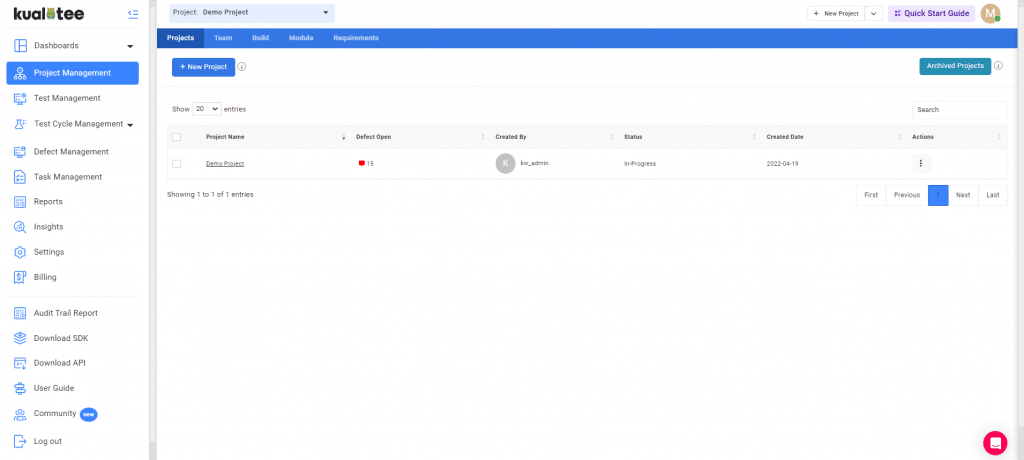
Create Project
To create your project, you simply click on the ‘New Project’ button.
Not all testing projects are the same so you have the option to choose your project type and even customize the project type if required.
User can select the relvent browser, OS & devices in the additional details section.

Fill out the following text fields to create your project.
Creating a New Project
When creating a new project, only the Project Name field is mandatory. The other fields are optional but can be filled out for more detailed project information.
- Project Name: Enter the name of your project. (This is the only required field.)
- Project Type: Choose the appropriate project type from the drop-down list.
- Operating System: Select the operating system from the provided drop-down menu or type the name to create your own.
- Devices: Select the device from the provided drop-down menu or type the name to create your own.
- Browser: Select the browser from the provided drop-down menu or type in the name to create your own.
- Operating System Field: This field will now be enabled. You can write down any specific operating system if needed.
- Project Description: Provide a brief description of your project to offer more context.
- Cancel Option: If you click on the “Cancel” link, the project will not be created, and you will be redirected to the “Create New Project” page.
Once all the necessary details are entered, click on Create to save your project. A success message will confirm that your project has been saved successfully.
Action Button
To take action, click on the action button and you can take the following actions.
Edit and Archive Projects
To edit or archive your project, click on the action menu.
Copy Project
When you click on the ‘Copy Project’ option, it will create a replica of the project you have selected. This will include all the data from your existing project and save it as a newly created project. This data includes the build, modules, requirements, test scenarios, test cases, defects, and tasks, with all their associations.
How this feature will help you:
If you need the same data for another project, you can simply copy this project and save yourself the hassle of creating all the data again in a new place. All you have to do is copy the project, thus saving time and effort!
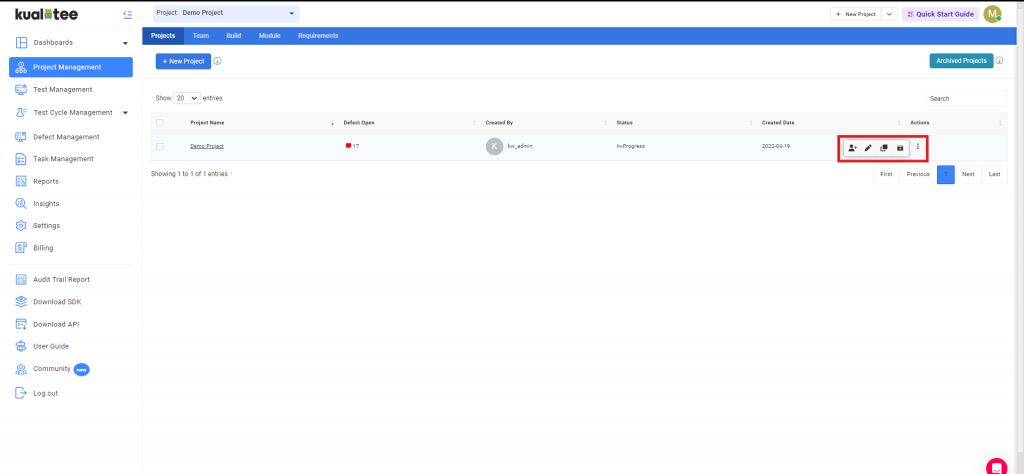
Follow these steps to Copy your existing project:
1. Go to the ‘Project Management’ tab. You will land on the ‘Projects’ page.
2. Click on the Actions button and then click on ‘Copy’ option.
3. Your project will be copied and will be available in the projects list.
‘Add Users’
In the Actions menu, click on the first icon (i.e. ‘Add Users’).
When you click on it, you will be navigated to the teams screen where the list of users available in the domain. You can select the users of your choice and add them in your project.
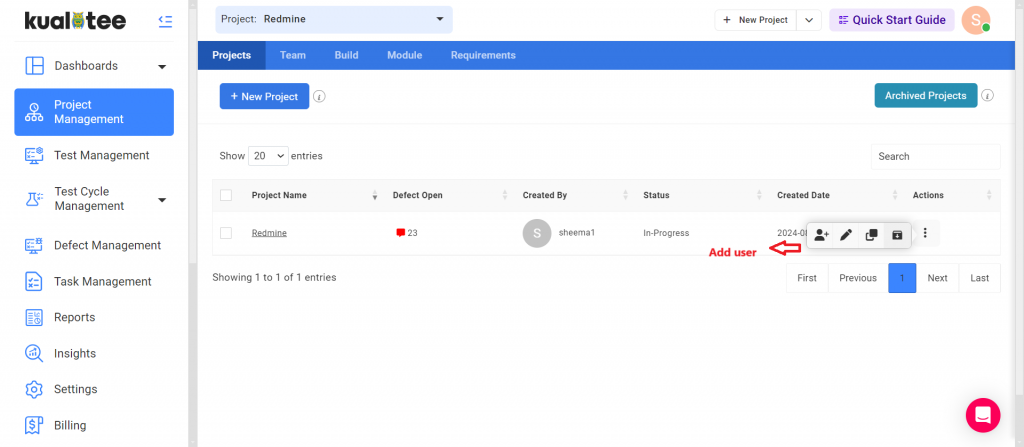
Archived Projects
When you click on ‘Archived Projects’, you will be able to view all your archived projects. You can either restore or permanently delete them.
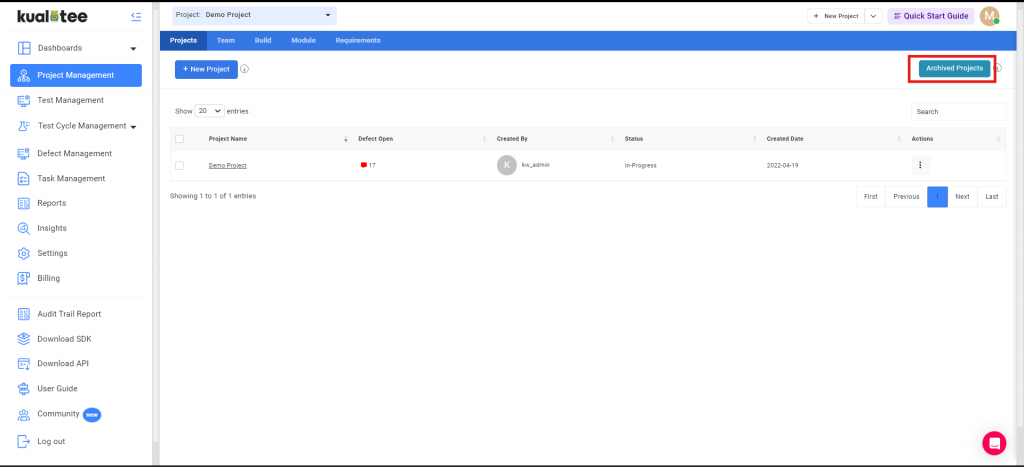
Team
Team Management on the project level can be done through the team page in project management.
Users on Kualitee domain can be assigned to different projects. In case, a new user needs to be added you can click on add new user to start with adding a user to the domain first.
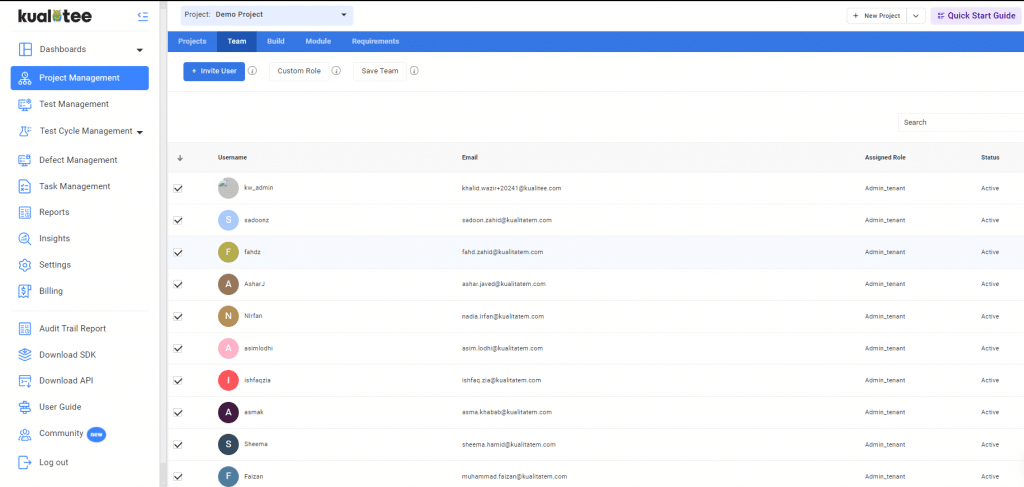
In User, you simply provide First Name, Last Name, Email, and the role that you would like to assign to this user within the project you want the user to be added.
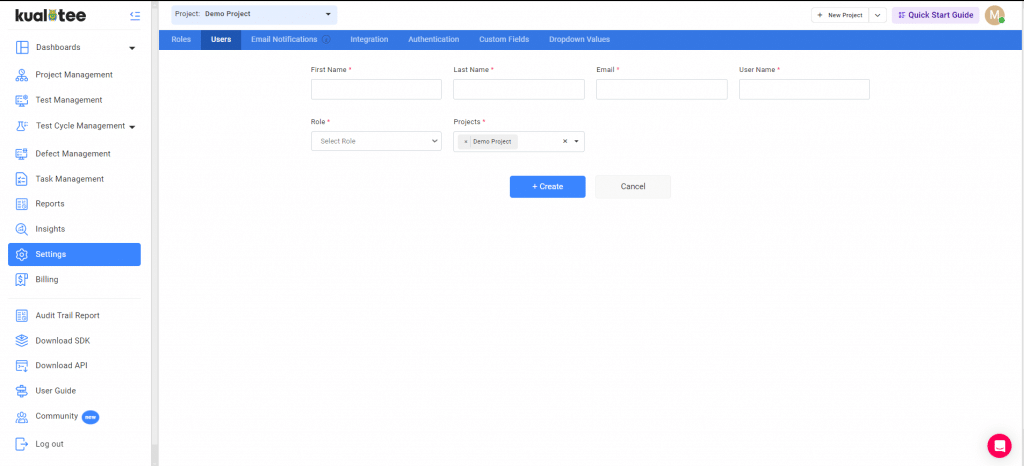
Builds
The build is the process of naming and providing the details of the software build/iteration/sprint that you would be testing as part of your project. Each project can have multiple builds.
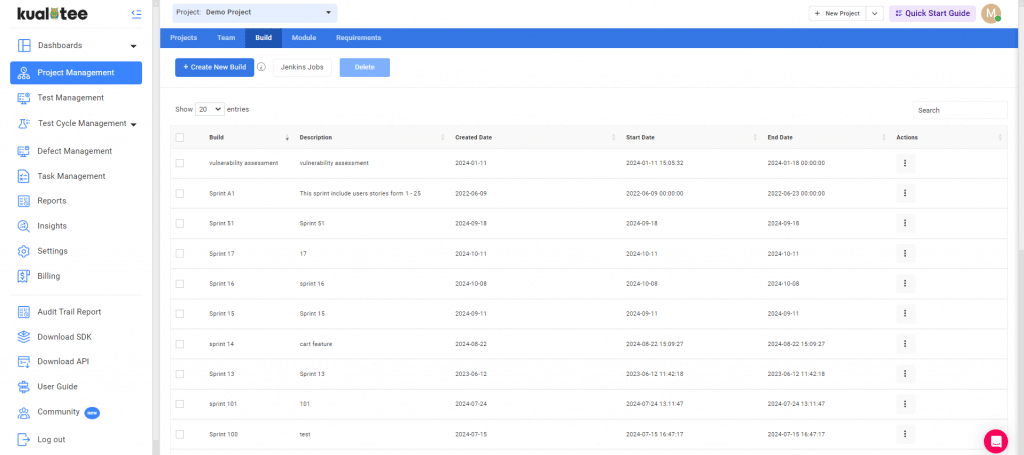
Creating a new build
- Ensure that a Project has been selected from the ‘Select Project’ drop-down within the left menu
- Select the ‘Build’ tab within the Project Management Tab to create a new build
- User will be redirected to ‘Create New Build’ page.
- Click on ‘Create Build’ Button
Fill the following fields:
- Build ID
- Start date
- End date
- Users
- Description
Click on “Create Build” button
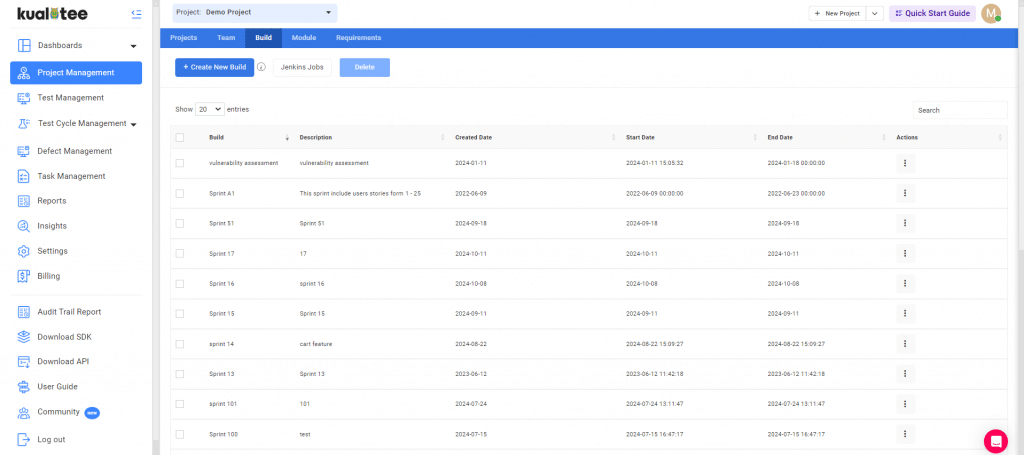
To edit and delete the build hover the mouse to the list.

Module
The next step after build creation is of modules.
Each build within a project can contain multiple modules. The Module Management screen will display a list of all modules within a specific build.
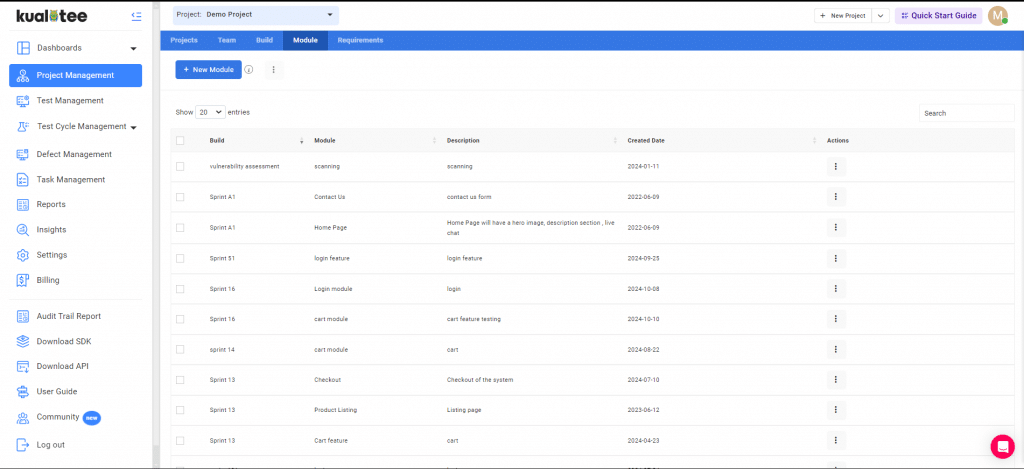
Creating a Module
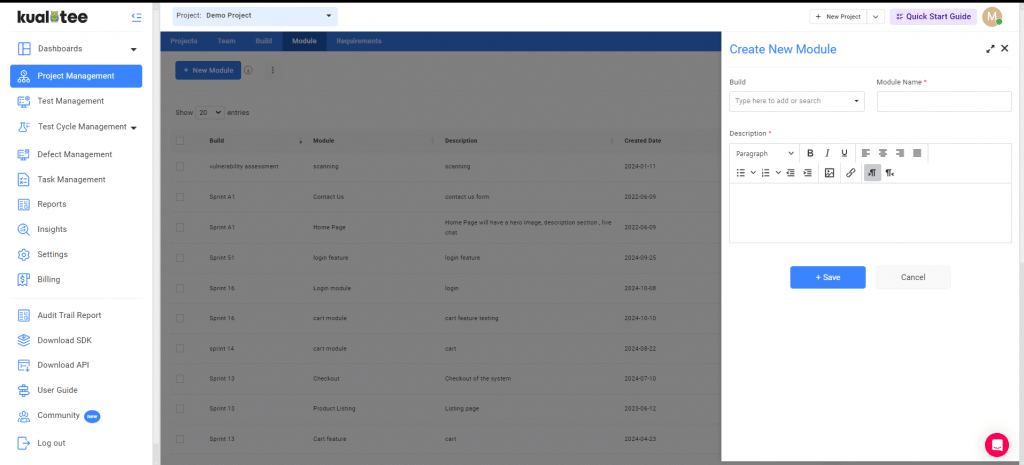
The Module Management screen will display a list of all modules within a specific build.
- Ensure that a Project has been selected from the ‘Select Project’ drop-down within the left menu
- Ensure that the build has been created before module creation
- Select the ‘Module’ tab within the Project Management Tab to create a new module
- Fill the following required fields:
- Select a build
- Module name (Module Name must be at least 3 characters long.)
- Description
- Click on “Create Module” or on “Save and Create Module” button
Editing or Deleting a Module
You can edit or delete a module by hovering the mouse on the listing.

Requirements
You can use requirements planning to associate your existing test scenarios and test cases with parent and sub-requirement.
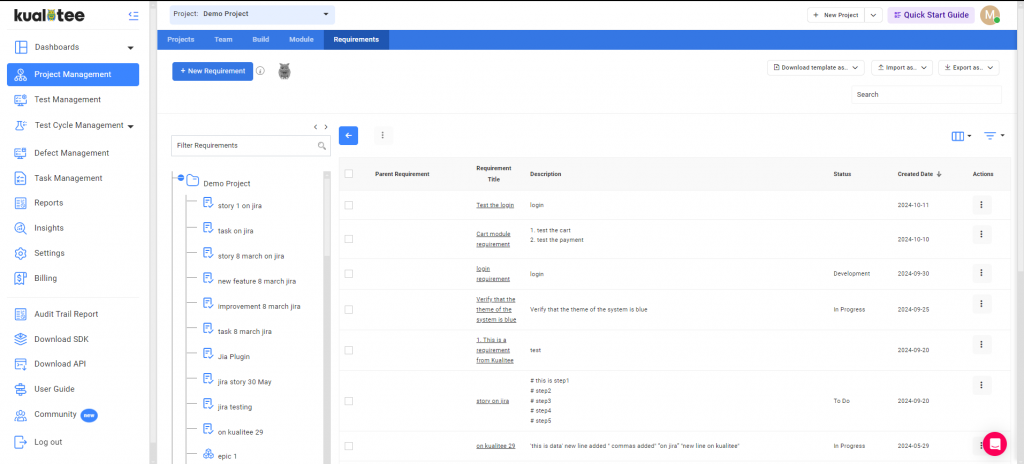
Creating Requirements & Sub-Requirements
To create requirements, you simply go to project management, select requirements, and click on create a requirement. Your first requirement is your parent requirement and you can assign sub-requirements by selecting the parent requirement from the drop-down. A parent requirement can have multiple sub-requirements and the user can also associate test scenarios and test cases with these sub-requirements.
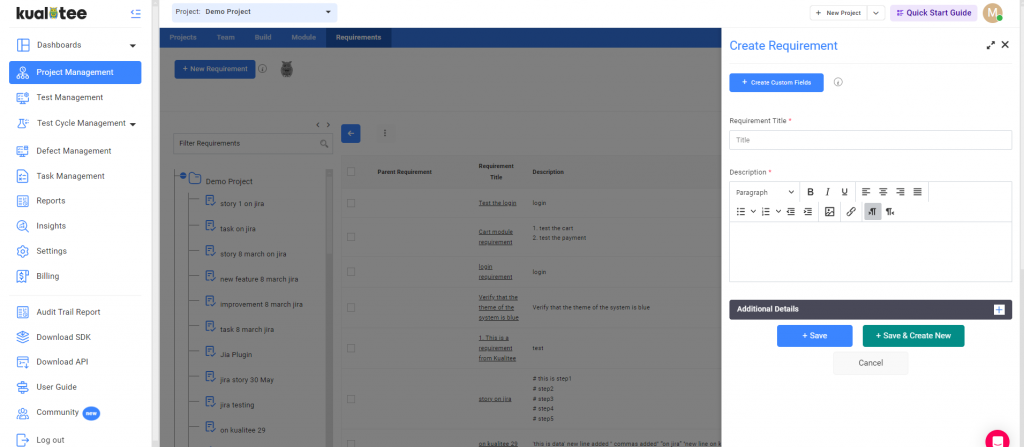
Associating Test Scenarios and Test Cases
If you already have test scenarios and test cases in your project, you can associate them with your requirements, or you can edit your test cases in Test management and select the requirement from the drop-down field.

Import & Export Requirements
To import your already created requirements you can simply download the CSV template and enter all the relevant information including your test scenario and test cases if you want them to be associated with your requirements. This will automatically create all the entries and populate the information.
Note: Kindly make sure that all the fields are mapped properly to avoid any issues.

Action Buttons
Clicking on ‘Action’ will give you the options to ‘delete’ or ‘copy’ your requirement.
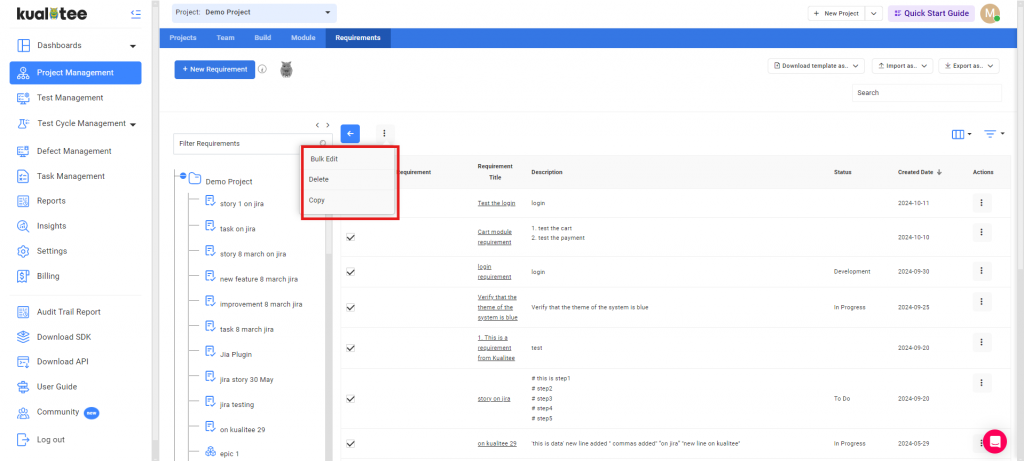
Bulk Edit
You can edit your requirements in bulk. When you tick the checkbox against your requirement, you will be able to see the “Bulk Edit” option. Click on it and a pop-up will appear. You will then be able to update the associations of your requirements in bulk also you can edit your custom created fields too from the “Bulk Edit” option.
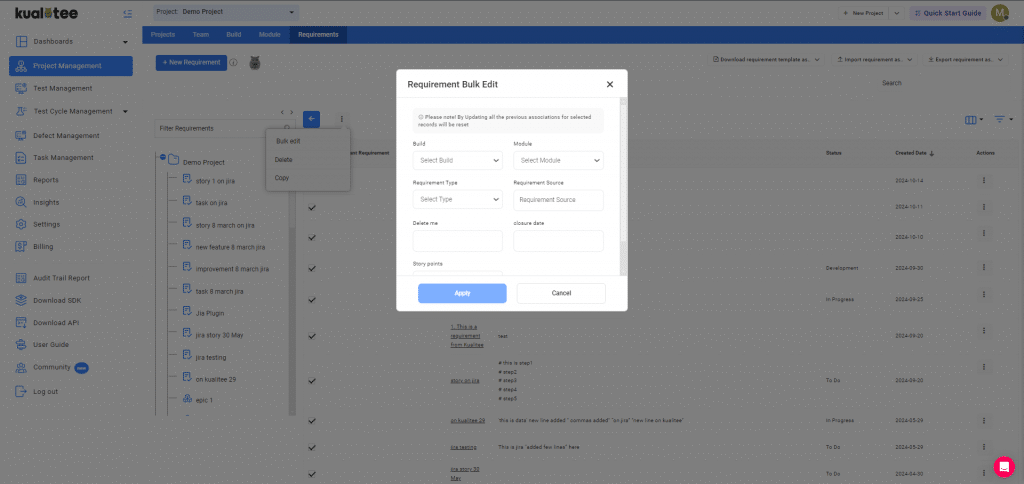
Filters
You can filter your requirements by the below-mentioned filters. You can also save your filters by ticking the ‘Save my Setting’ checkbox.
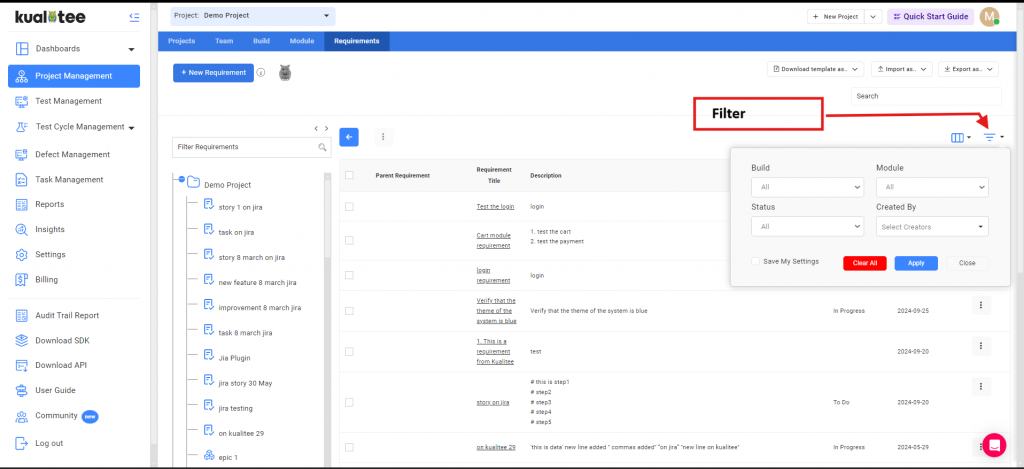
Customize Listing:
You can now view your custom fields in your listing pages from the custom listing option.
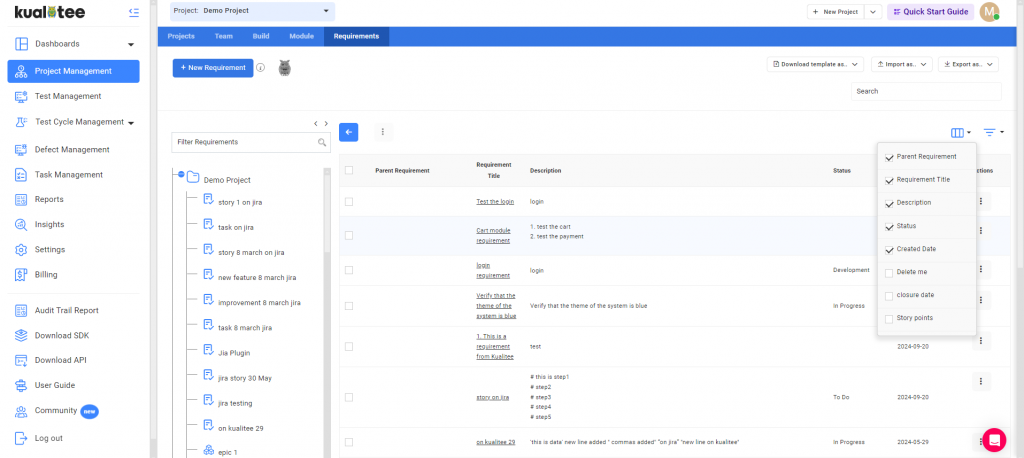
To add customize your listing pages, follow the steps below:
- Click on the “Custom Listing” option.
- Select the fields you want to view in your listing pages, and they will be displayed.
Overlay View
The Overlay view can be accessed when you review the specifics of your Requirements. As you move your cursor over the action items in the corresponding column, a quick view icon will appear. Clicking on it will reveal the Overlay view, opening up to your saved details, attachments, and comments. You can also make edits directly from this section.
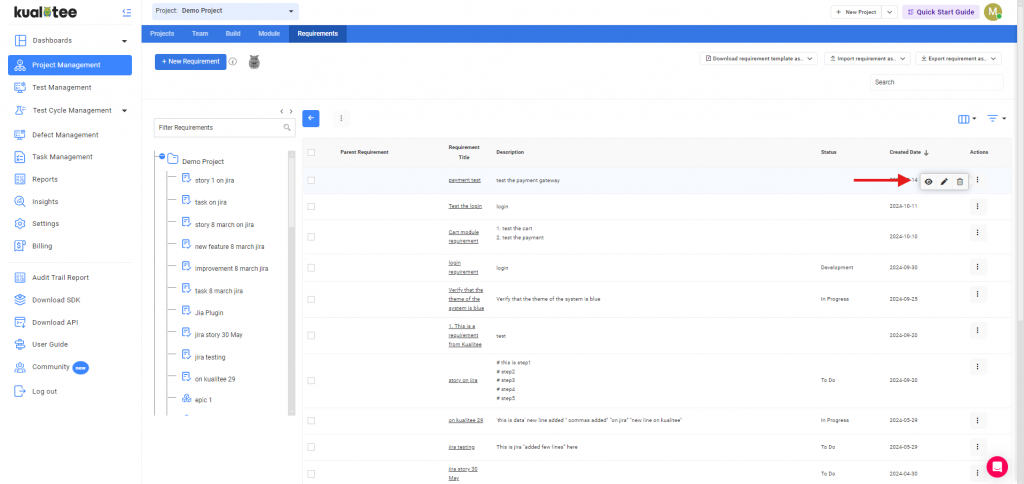
Central Repository
The Central Repository is designed to streamline test case management across multiple projects, providing a centralized hub for creating, managing, and utilizing test cases.
How to Enable the Test Case Repository:
1. Log in as a Domain Admin.
2. Navigate to the Global Configuration tab under Settings.
3. Toggle the Test Case Repository feature ON/OFF as required.
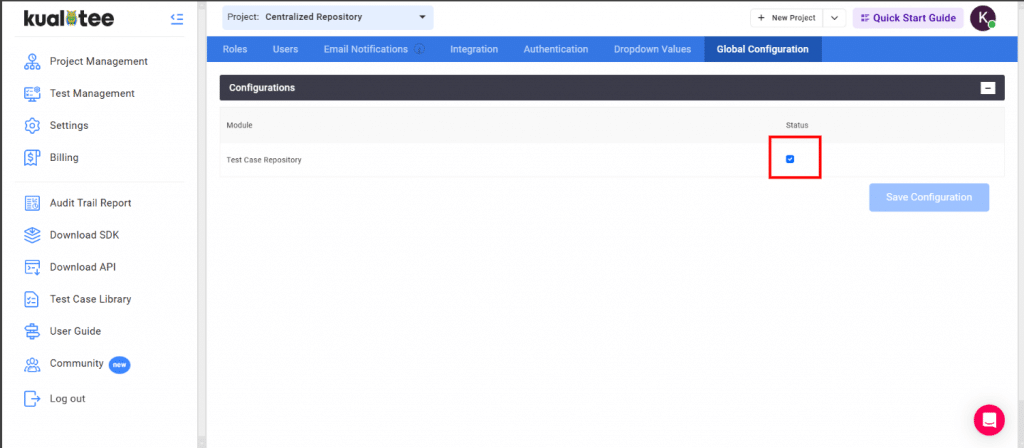
Using the Central Repository:
1. Access the Central Repository:
- – Click on the Central Repository Project from the project dropdown.
- – You will be redirected to the centralized workspace where only selected modules are available.
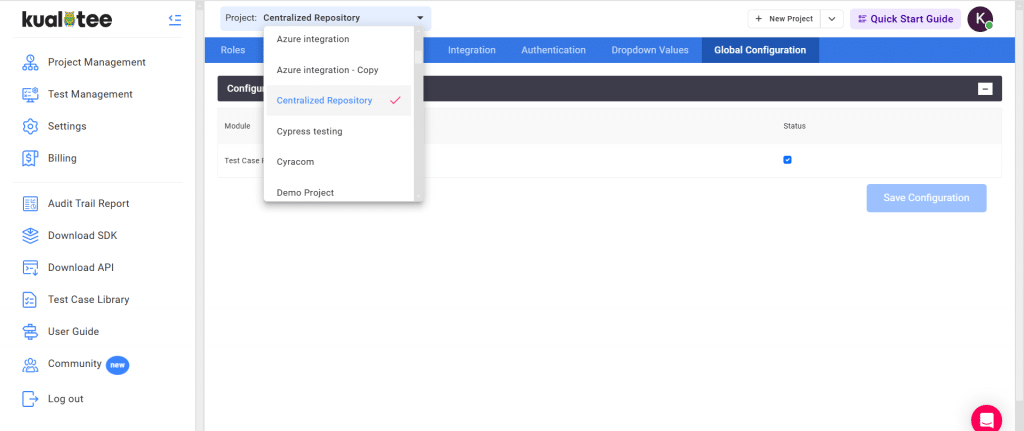
2. Adding Test Cases to Central Repository:
- – Navigate to Test cases screen
- – You can import or create test cases in central repository OR you can generate test cases through AI in central repository
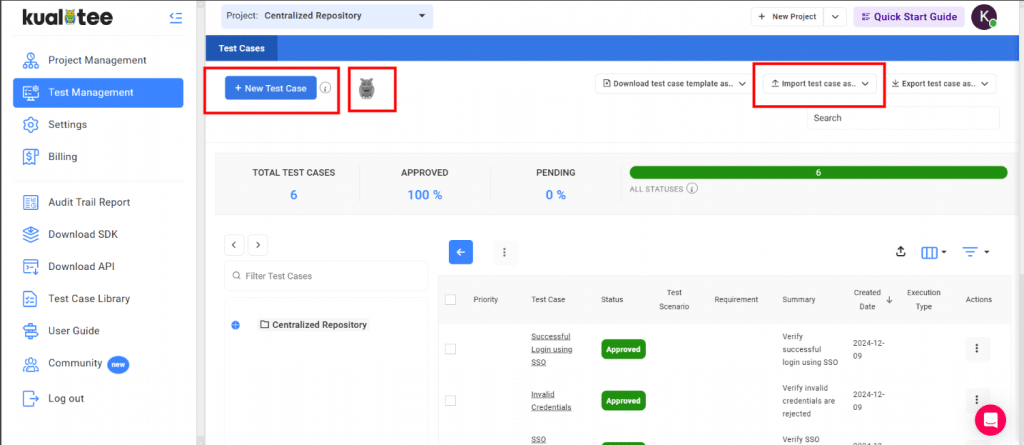
3. Adding Test Cases to Central Repository from local project:
- – Navigate to the local project’s test case list.
- – Select the test cases you want to add.
- – Click the Add to Repository option.
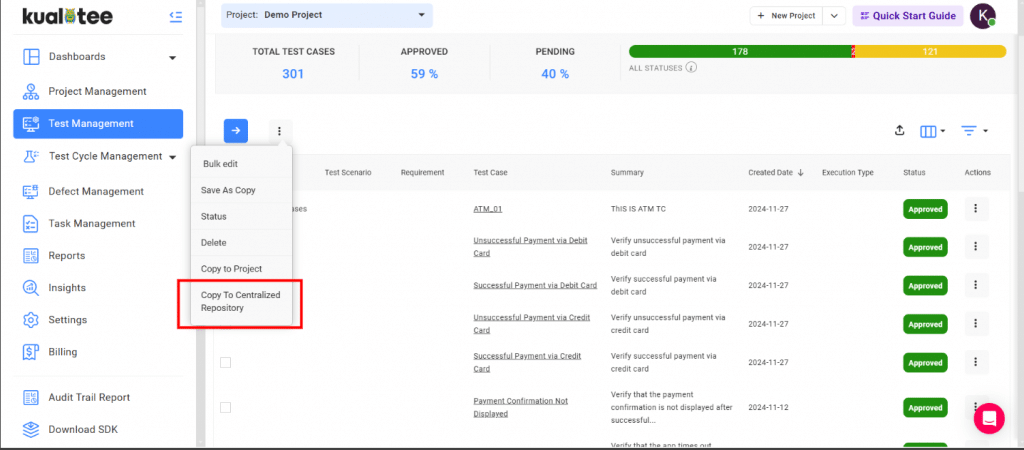
- You can add test cases while creation by clicking on the checkbox available on test creation screen
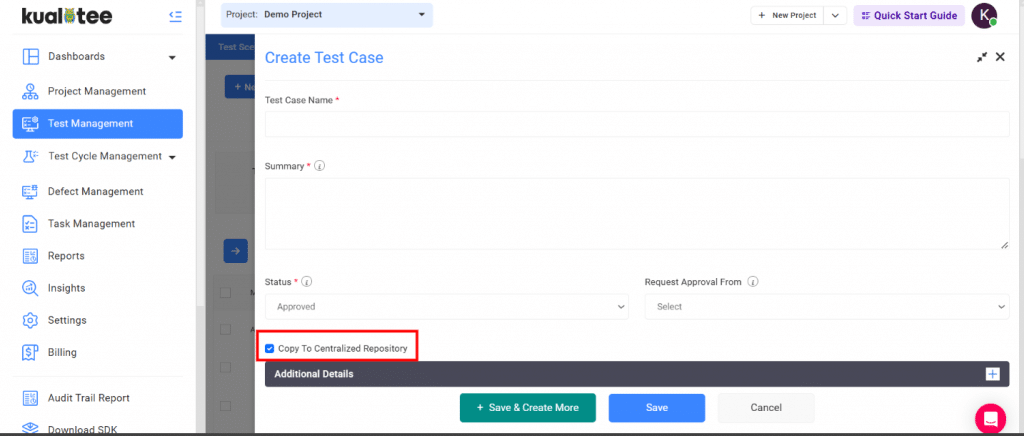
4. Copying Test Cases from the Repository to a Local Project:
- – Go to the Test Cases section of the central repository.
- – Select the desired test cases and click Copy to Project.
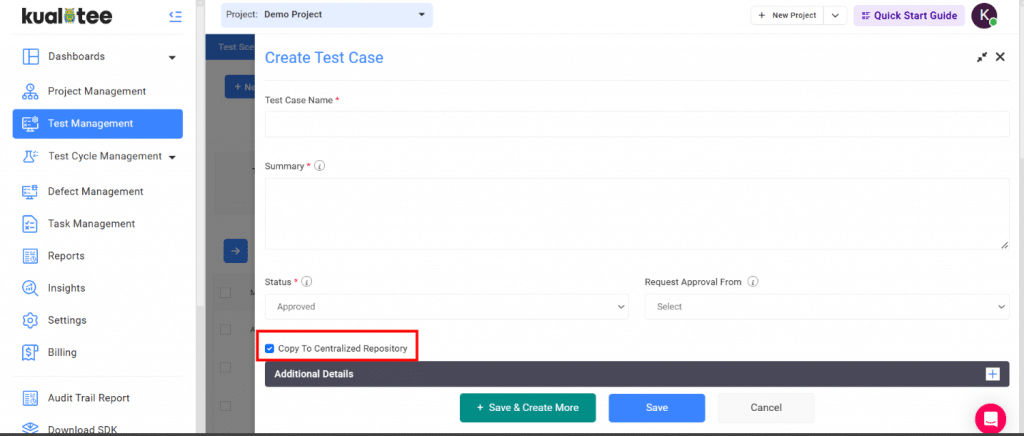
5. Managing Approved Test Cases:
- – Test cases from the repository will appear in the Manage Test Cases tree. Just switch the toggle and all the test cases from the repo will be displayed and can be added in cycle
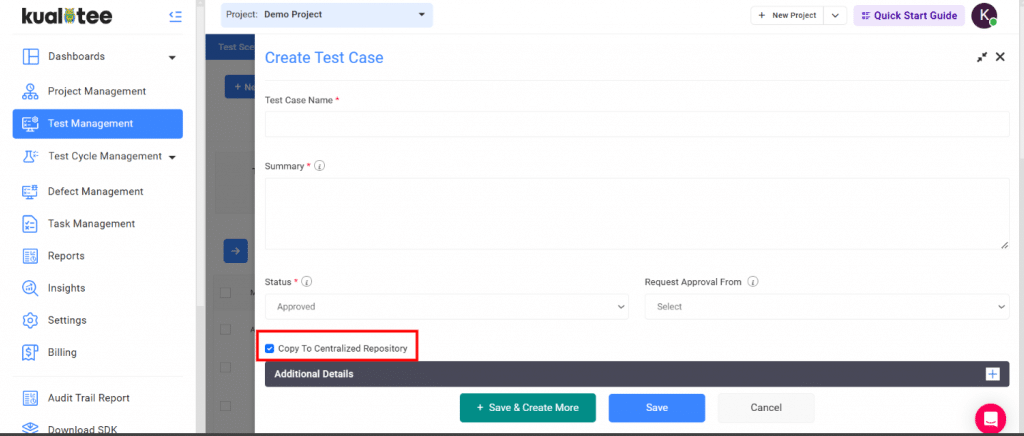
6. Executing Test Cases:
- – Test cases added in cycle can be executed as part of the test cycle.
7. Reflecting Changes in Test Cases:
- – Any updates made to a test case in the Central Repository will automatically propagate to all local projects where the test case is used.
Test Cases
The test case contains a summary, test steps, precondition, postcondition developed for a specific test scenario to verify any requirement. Multiple test cases can be associated with test scenarios and requirements for any build and module.
Creating a test case
- Ensure that a Project has been selected from the ‘Select Project’ drop-down on top bar
- To create a new Test Case select the ‘Test Case’ tab from within the Test Management tab
- Click on the “Create Test Case” button
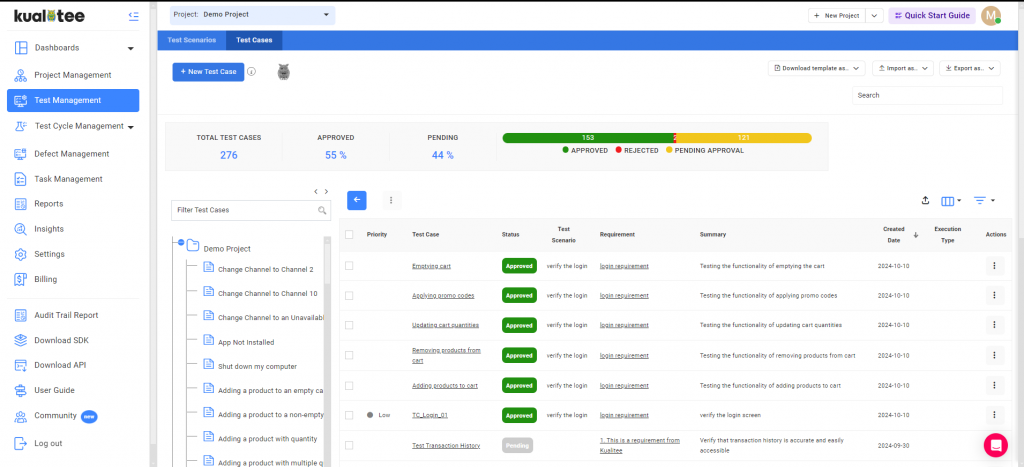
While creating a test case, Test case ID and Summary are compulsory fields. While others are optional fields.
Kualitee by default has different roles with a specific set of permission. If you are a tester creating test cases, you will need to get them approved before moving them forward for execution. By default, your domain admin, test manager has the permission to approve test cases. You can ask for approval with each created test case or in bulk when importing them.
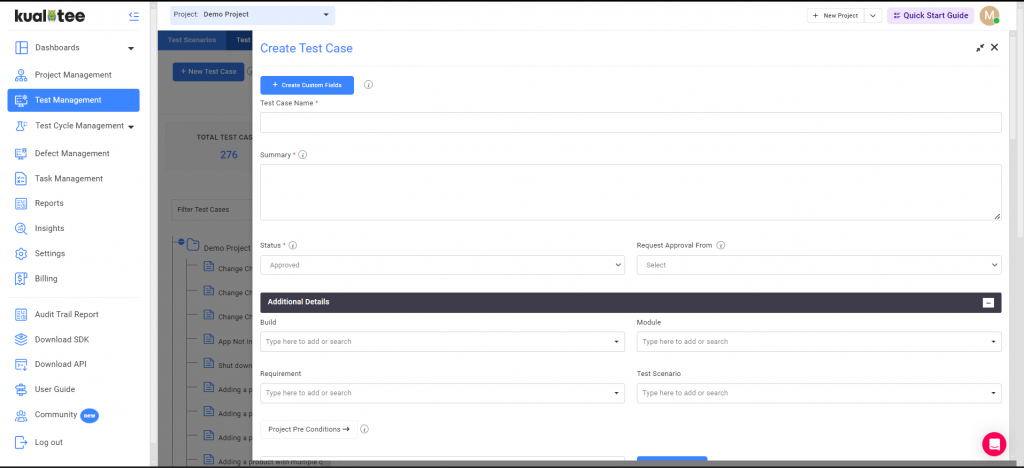
Project Pre-conditions
User can define generic preconditions that can be reused while creating/editing a test case. User will not have to rewrite preconditions each time for each test case, if this is generically same for all the test cases.
Steps to create generic pre-conditions:
Go to test case create/edit screen.
Click on the additional detail section.
Click on the project pre-condition button.
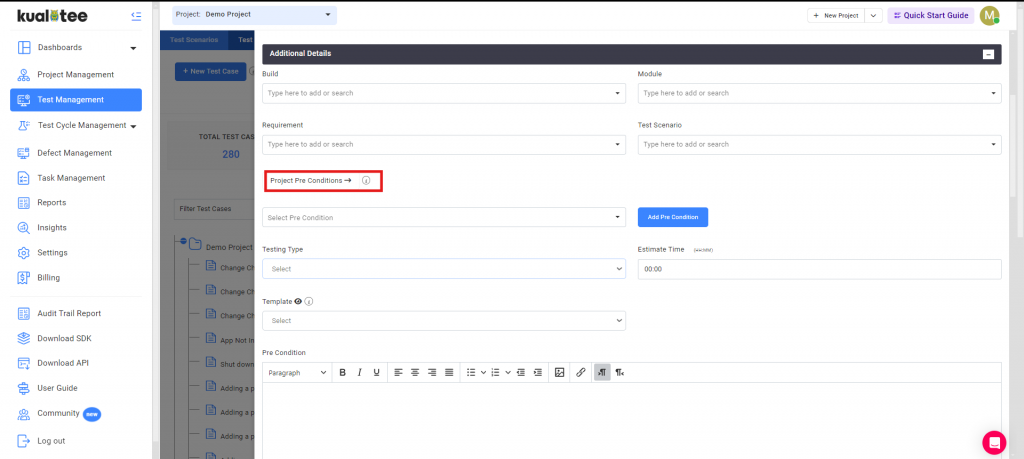
Test case steps
Now make your test cases more granular by breaking down detailed steps into smaller yet precise actions with well-defined expected results and attachments.
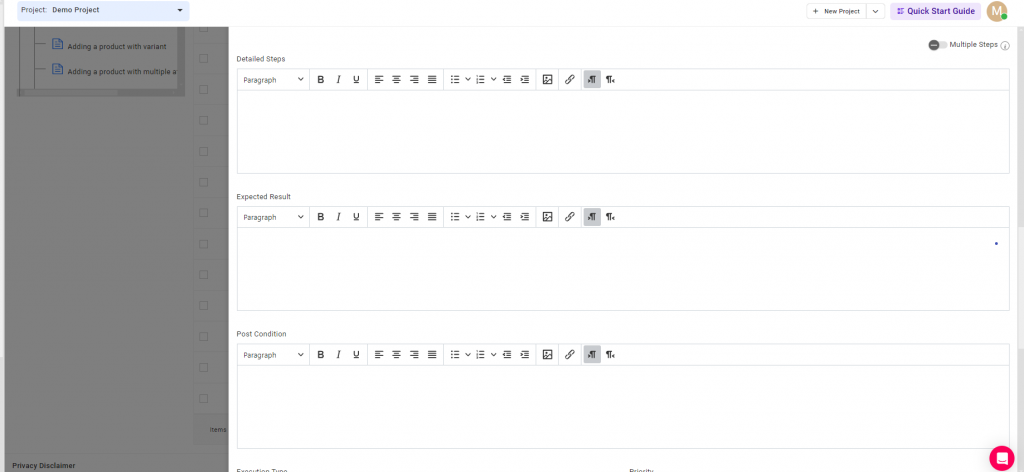
Add more test case steps while updating test cases
You can add more steps while updating the test case, according to the steps below.
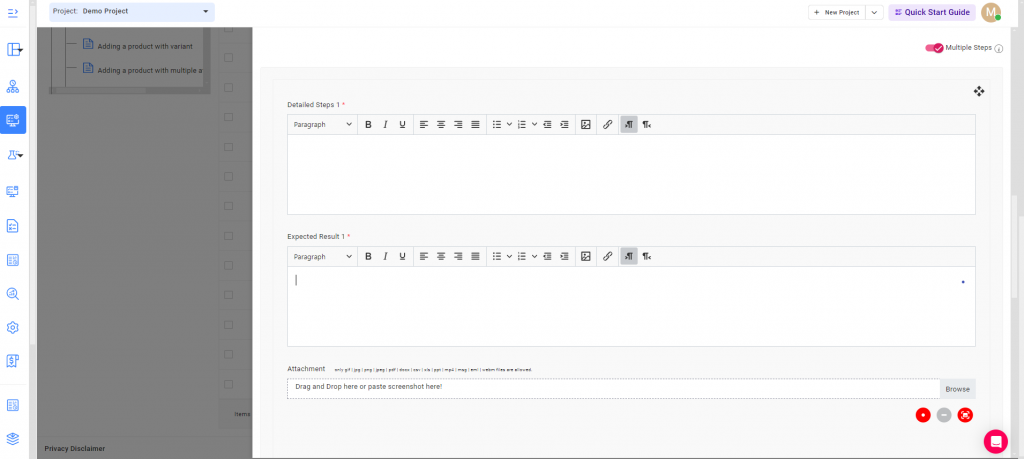
Step 1: Click on Add Step
Step 2: Add the Steps Detail and Expected Result
Step 3: Click on Create Button for Adding More Steps
You can also sort out your test cases steps.
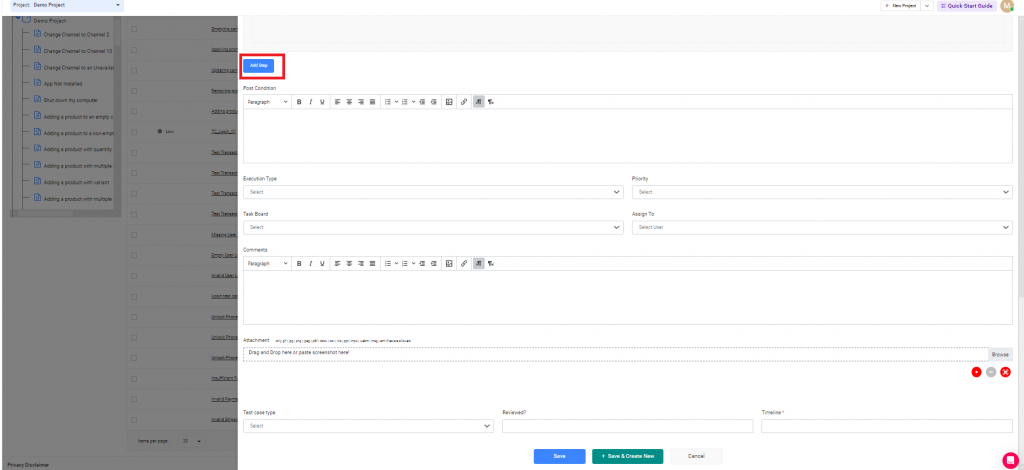
Add Step details
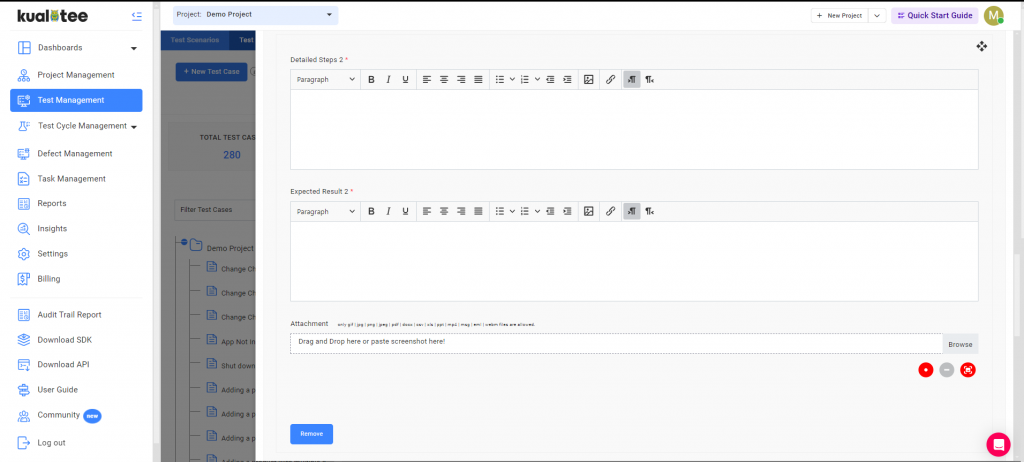
Import and Export of Test Case
Additionally, you can also import your already created test cases, you can either upload your own copy and map the fields according to Kualitee fields using the in-app mapping wizard or you can download the template and use that to upload your list of test cases.

You can export your data in three different formats CSV, Excel, and Word. Click on any of the icons will get your file ready for export and prompt you when it’s ready for download.
Bulk Action
- Save as copy: You can save a copy of your selected test cases, in the same project.
- Save as template: You can save a test case template, so you don’t have to create a new one when making the same kind of test case again.
- Status: You can assign a status to your selected test cases as Approved/Rejected.
- Delete: You can delete your selected test cases in bulk.
- Copy to project: You can copy your test cases to another project as well. (Note: No associations will be copied, only the test cases will be copied).
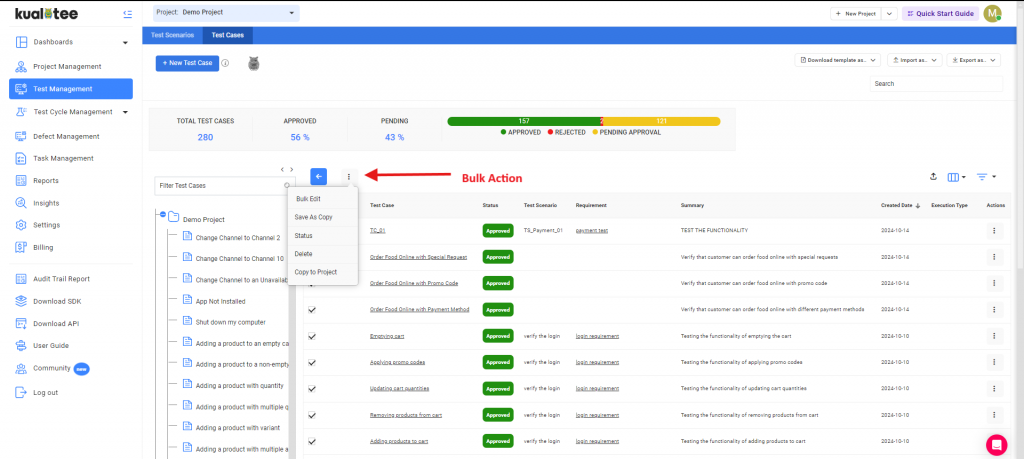
Bulk Edit
You can use the bulk edit option to change associations between data e.g build, module, requirements and test scenarios associated with your test cases can be changed using the bulk edit option for selected or otherwise all of the items in the listing. Also, you can edit your custom created fields too from the “Bulk Edit” option.
Note: Associations once changed cannot be reverted back to an earlier state.
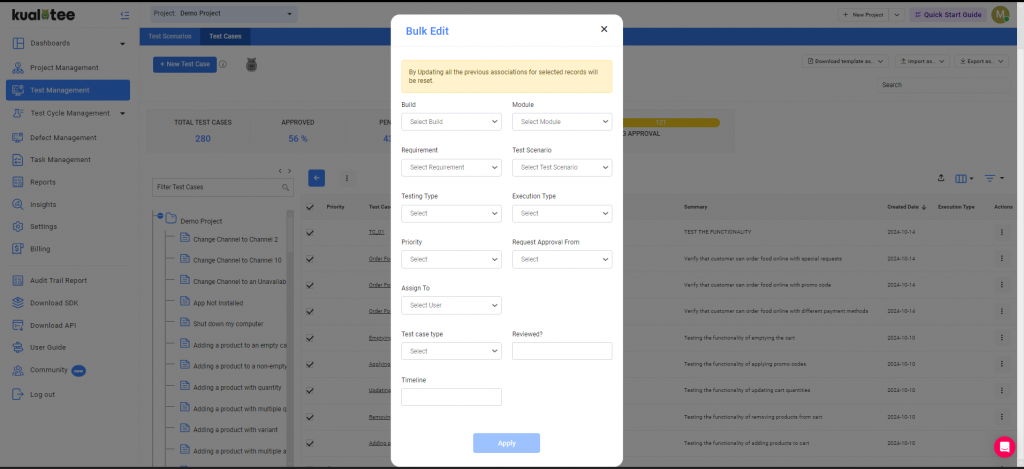
Filters
Multiple filter options are available in the Test Cases tab to filter the test cases according to your requirements.
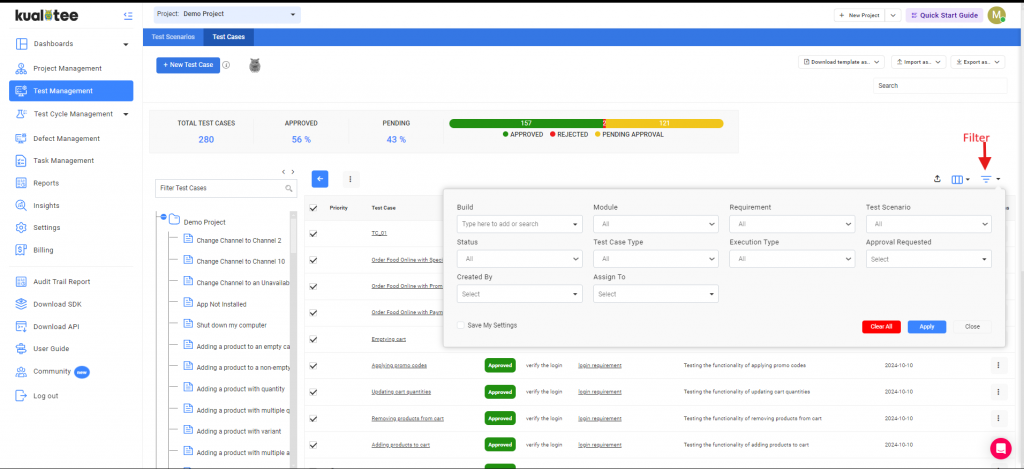
Customize Listing
You can now view your custom fields on your listing page from the custom listing option.
To add custom fields to your listing pages, follow the steps below:
- Click on the “Custom Listing” option.
- Select the fields you want to view on your listing page, and they will be displayed.
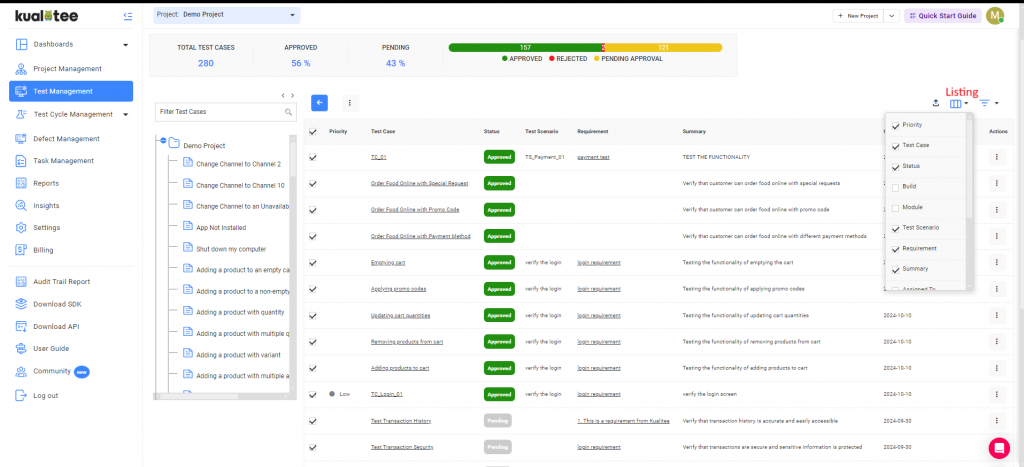
‘Save as Template’ option
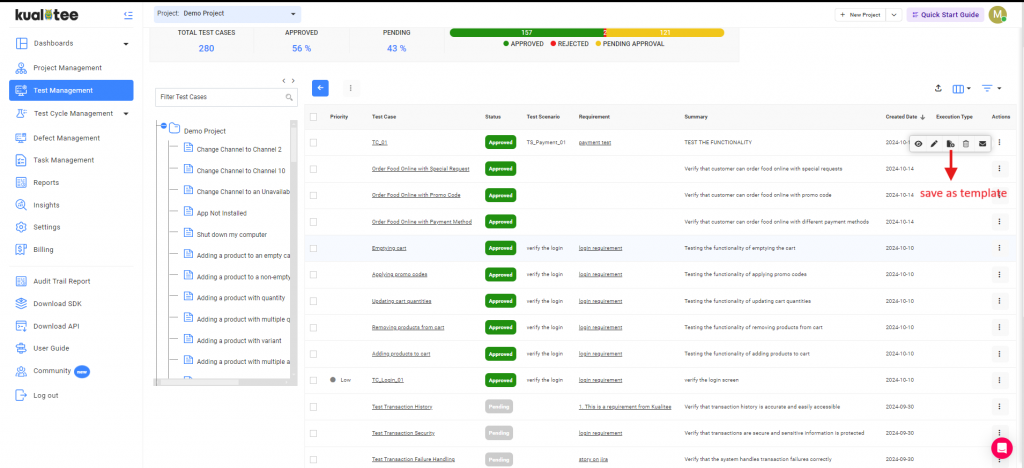
Once you’ve created your test case, you will also have the option to save it as template. You will be able to reuse the template for your future test cases.
Overlay View
The Overlay view can be accessed when you review the specifics of your Test Cases. As you move your cursor over the action items in the corresponding column, a quick view icon will appear. Clicking on it will reveal the Overlay view, opening up to your saved details, attachments, and comments. You can also make edits directly from this section.
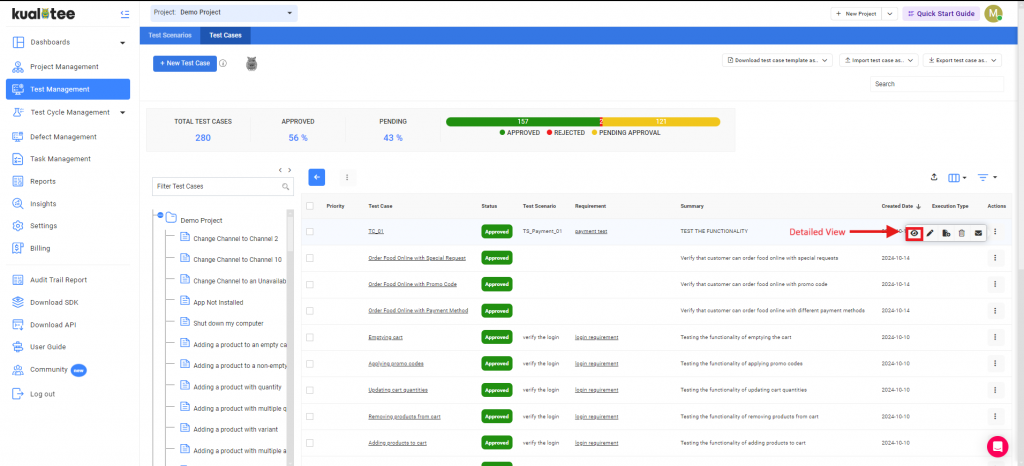
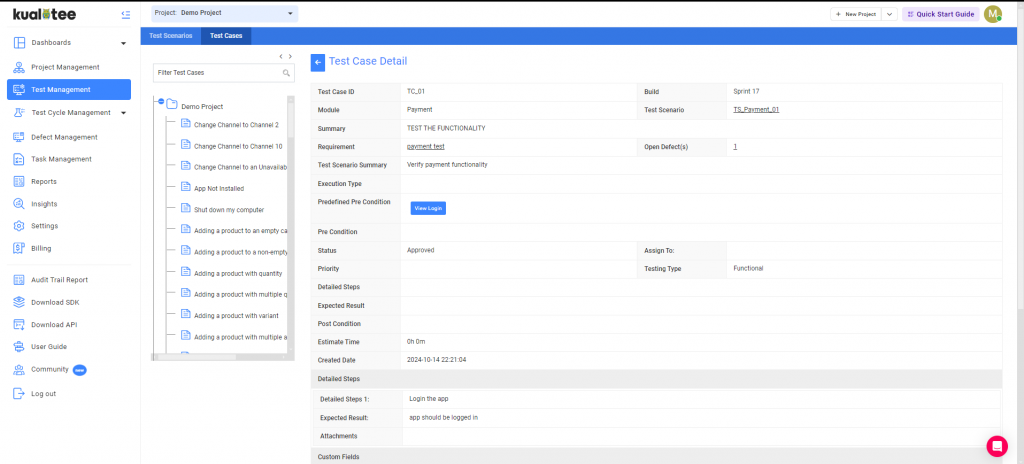
Test Scenarios
Test scenarios are tied with builds and requirements. Test cases can be grouped according to scenarios to provide further coverage for testing. The listing shows associations that each test scenario has with build, module, and requirements. Test Scenarios can also be created independent of the mentioned associated.
Creating a test scenario
To start with creating your test case, follow the steps below
- Ensure a project is selected from the top bar
- Click on test management tab in the left pane
- Choose test scenario from the orange pane
- Click on create test scenario button
- Enter all the required information
- Click save
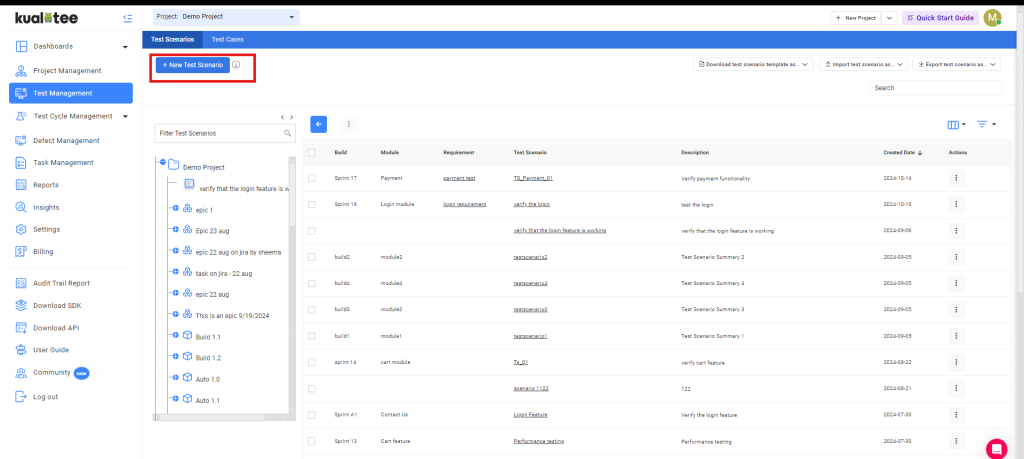
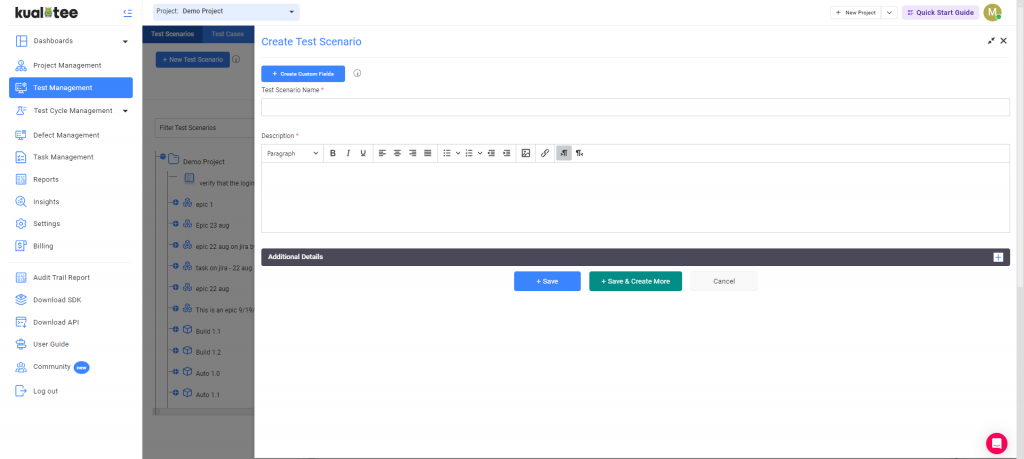
Import and Export of Test Scenarios
Additionally, you can also import your already created test scenario and test cases, you can either upload your own copy and map the fields according to Kualitee fields using the in-app mapping wizard or you can download the template and use that to upload the your list of test scenarios.
You can export your data in three different formats CSV, Excel and Word. Click on any of the icons will get your file ready for export and promp you when its ready for download.

Action Button
- Delete: You can delete your selected test scenarios in bulk.
- Copy: You can save a copy of your selected test scenarios in the same project.
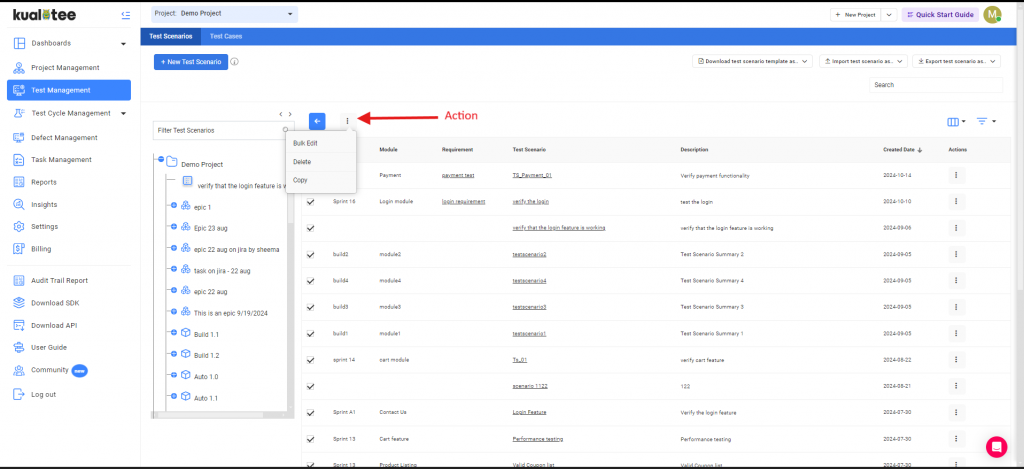
Bulk Edit
You can use the bulk edit option to change associations between data e.g build, module, or requirements associated with your test scenarios can be changed using the bulk edit option for selected or otherwise all of the items in the listing. Also, you can edit your custom-created fields too from the “Bulk Edit” option.
Note: Associations once changed cannot be reverted back to an earlier state.
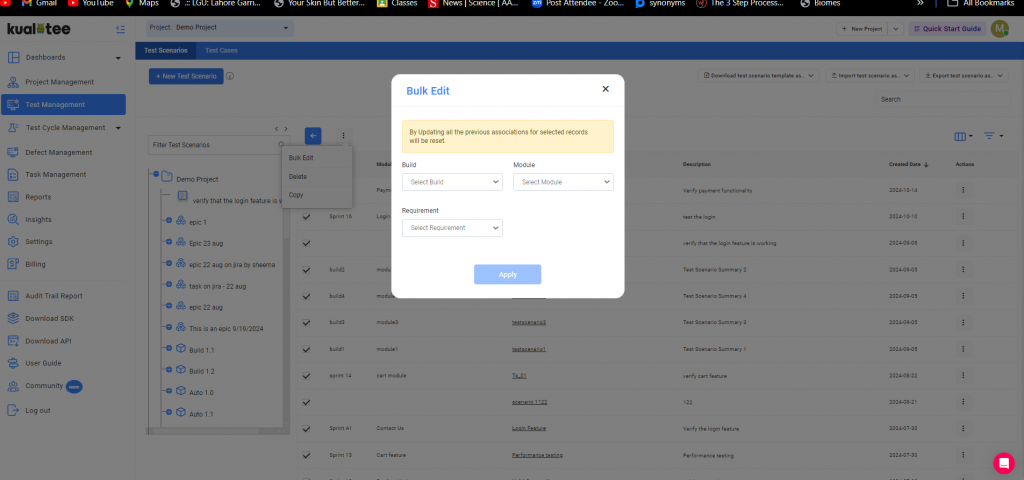
Filters
Multiple filter options are available in the Test Scenarios tab to filter the test scenarios according to your requirements.
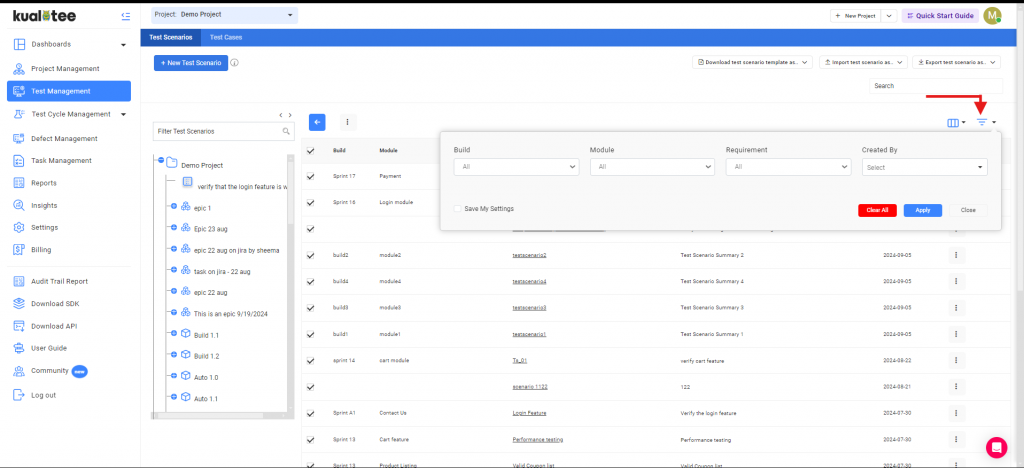
Customize Listing:
You can now view your custom fields on your listing page from the custom listing option.
To add custom fields to your listing pages, follow the steps below:
- Click on the “Custom Listing” option.
- Select the fields you want to view on your listing page, and they will be displayed.
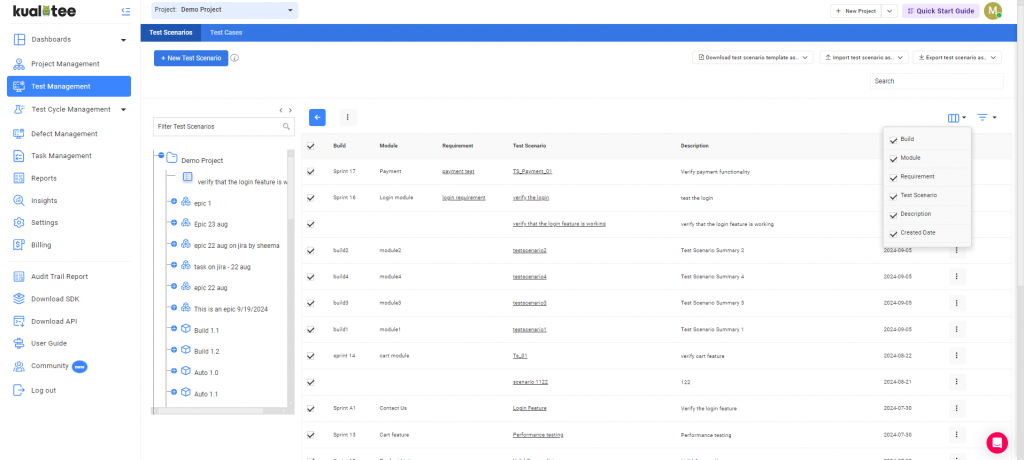
Overlay Feature
The Overlay view can be accessed when you review the specifics of your Test Scenarios. As you move your cursor over the action items in the corresponding column, a quick view icon will appear. Clicking on it will reveal the Overlay view, opening up to your saved details. You can also make edits directly from this section.
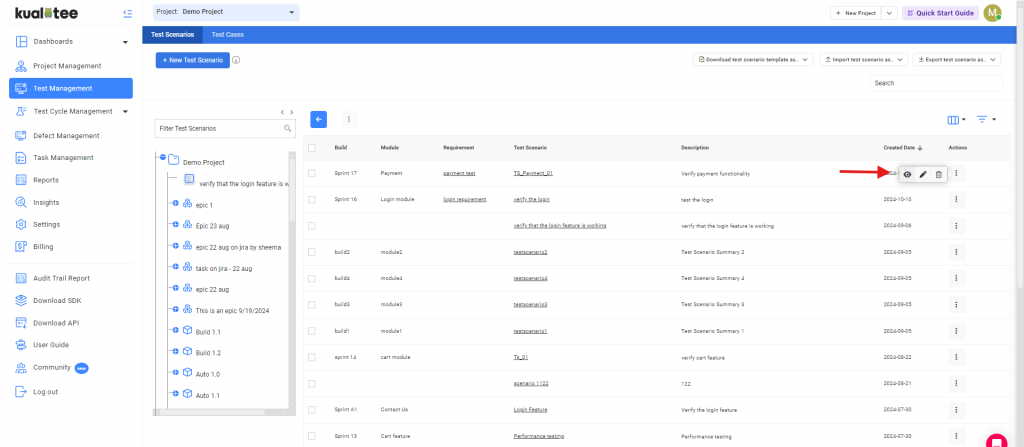
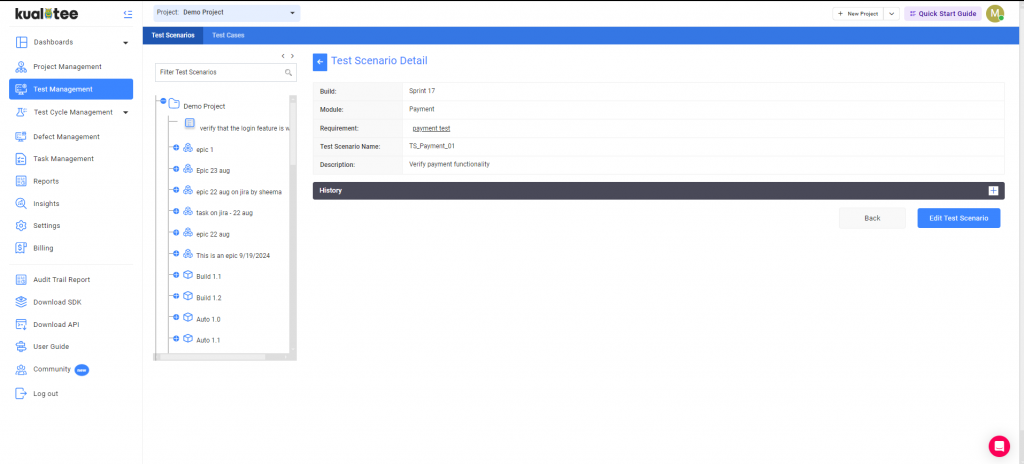
AI Test Management
Hootie, Kualitee’s revolutionary AI test case generation tool, automates and simplifies the creation of test cases for seamless software testing. Stop wasting time on manual test case creation—Hootie handles it for you. At Kualitee, we prioritize speed and efficiency, especially for complex tasks like testing.
With Kualitee’s AI Feature, you input your requirements and test scenarios in both textual, image or UI , and it instantly generates detailed test cases in Gherkin and textual form.
Creating Test Cases with Requirements
Here’s how it works:
1- Provide your requirements and test scenarios. All you have to do is input your requirement, select the test case generation type or import your requirement sheet and click on Generate button.
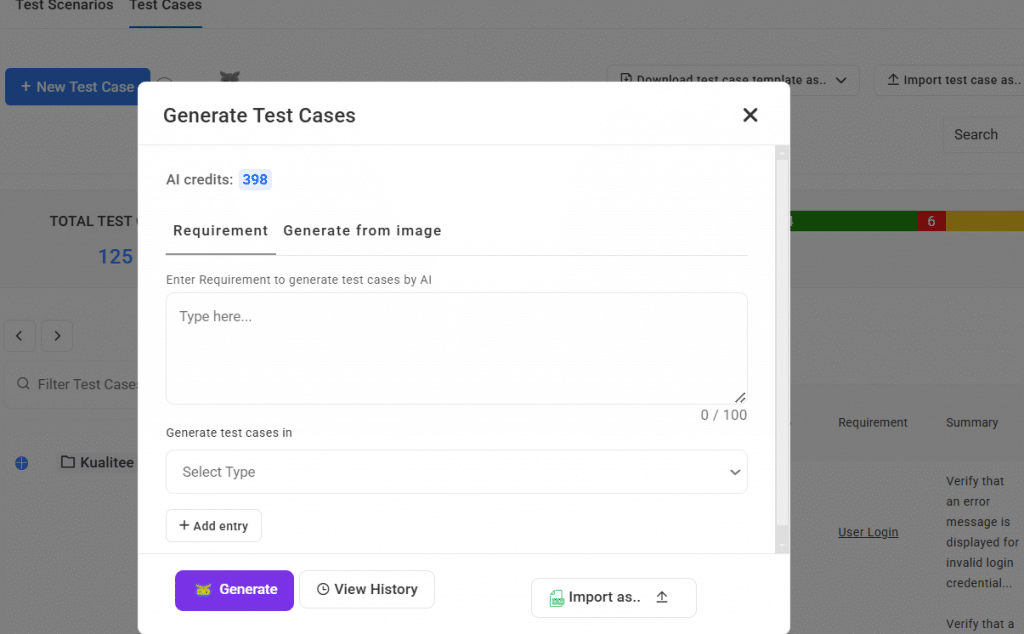
2 – Let AI do the work! The AI engine analyzes your input and generates a set of test cases.
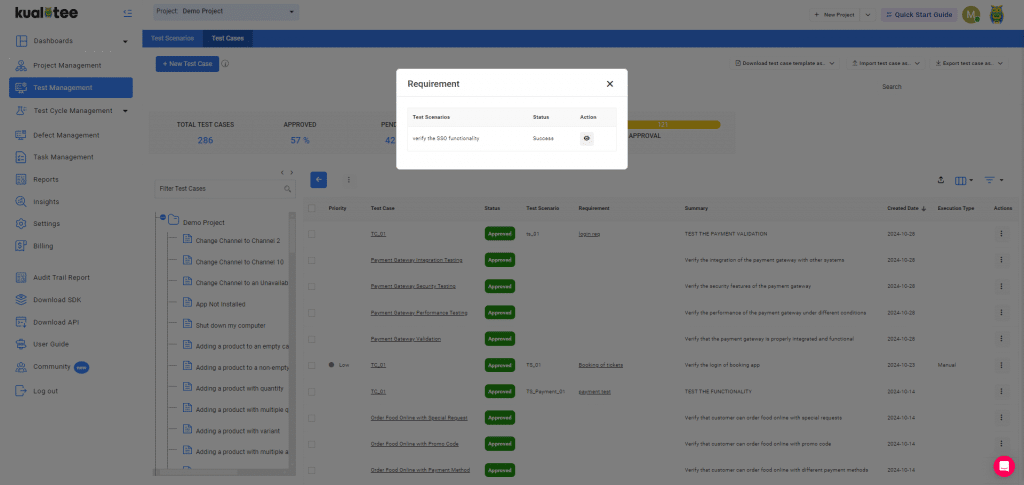
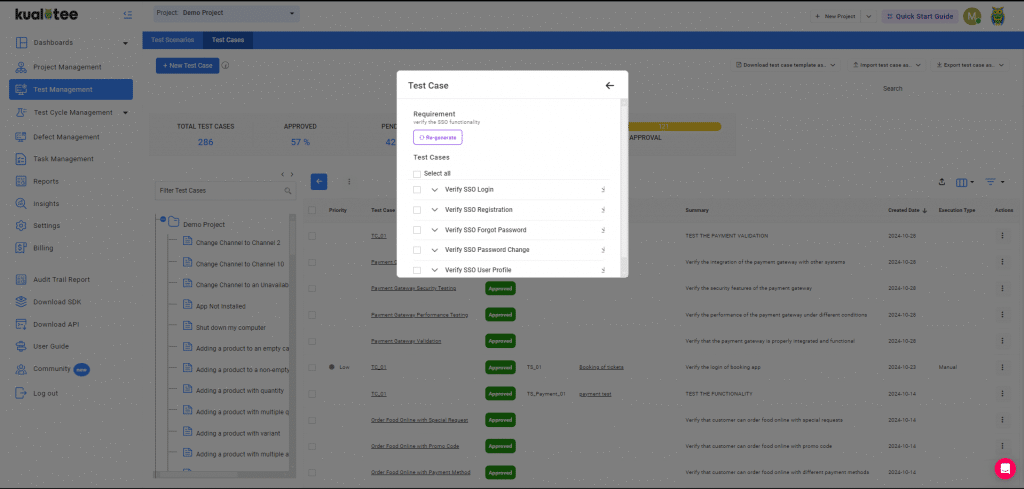
3 – Review the generated test cases, make any adjustments needed, and import them directly into your project.
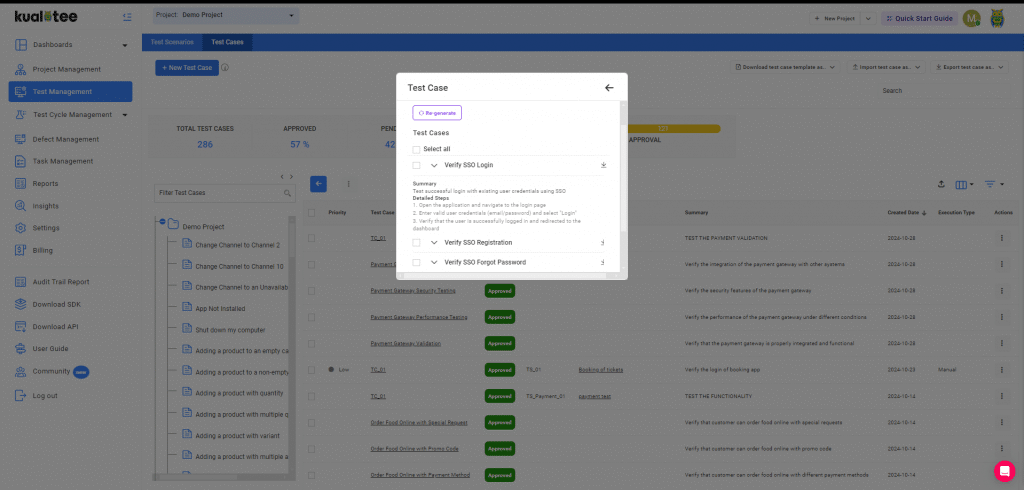
Creating Test Cases Using Image/UI
How it works:
1. Select the option “generate from image”.
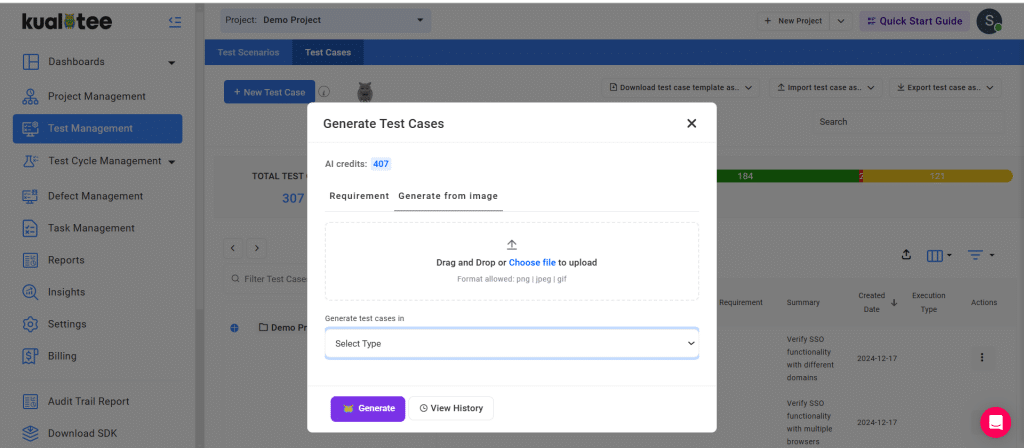
2. After uploading the image, select the type you want gherkins or textual.

3. Click on the “generate” button and your test cases will start generating.
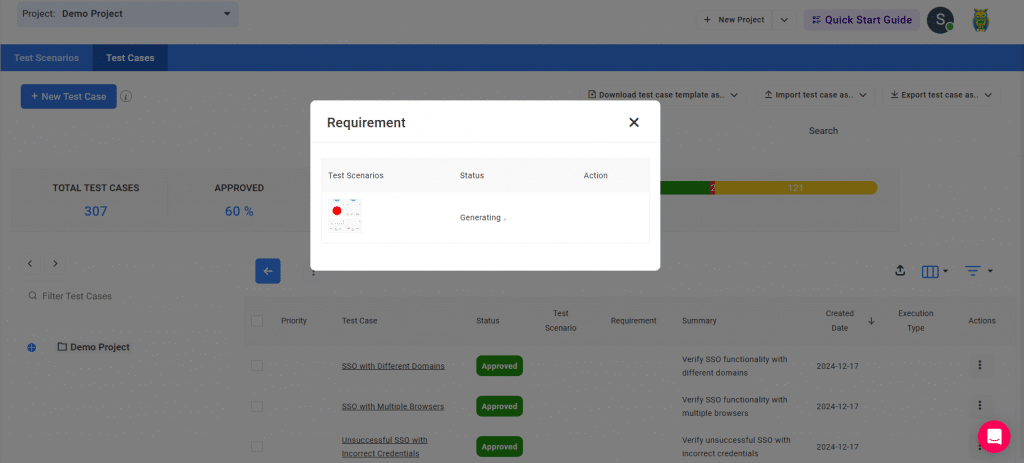
3. Test cases have been generated, review the test cases adjust accordingly.
4. Import the test cases directly into your project.
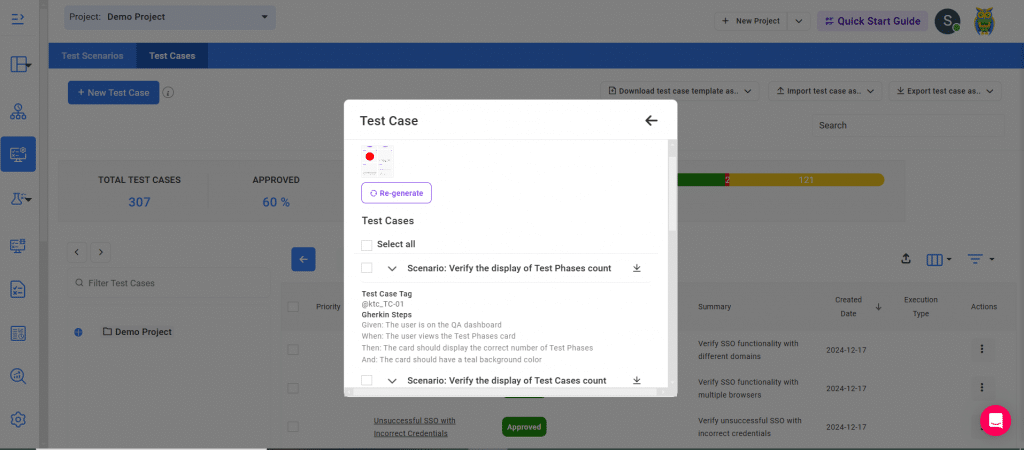
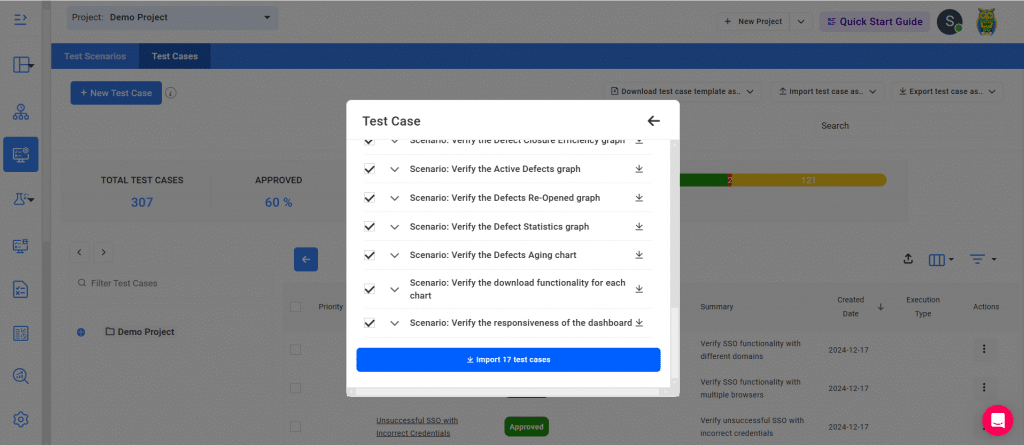
Benefits of AI-powered test case generation:
- Say goodbye to tedious manual tasks and give your attention to high-level testing strategies.
- AI reduces the risk of human error, ensuring thorough test coverage.
- Test cases will be generated promptly, speeding up your testing process.
- Spend less time writing and more time testing, maximizing your team’s output and being more productive.
Test Plan
Our Test Plan feature brings a new level of systemization and clarity to your testing process. With this feature, you can effectively structure your testing efforts and monitor progress through multiple test cycles. Each cycle contains a set of test cases, providing an easy way to track your overall test plan status. This ensures a thorough view of your testing process, improving collaboration and decision-making.
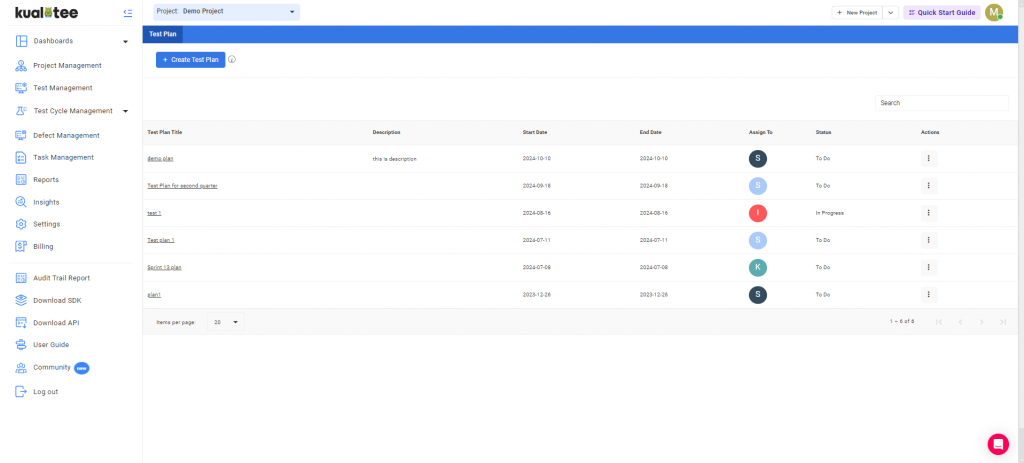
You get a comprehensive view of your test plan details in the Test Plan Detail section.
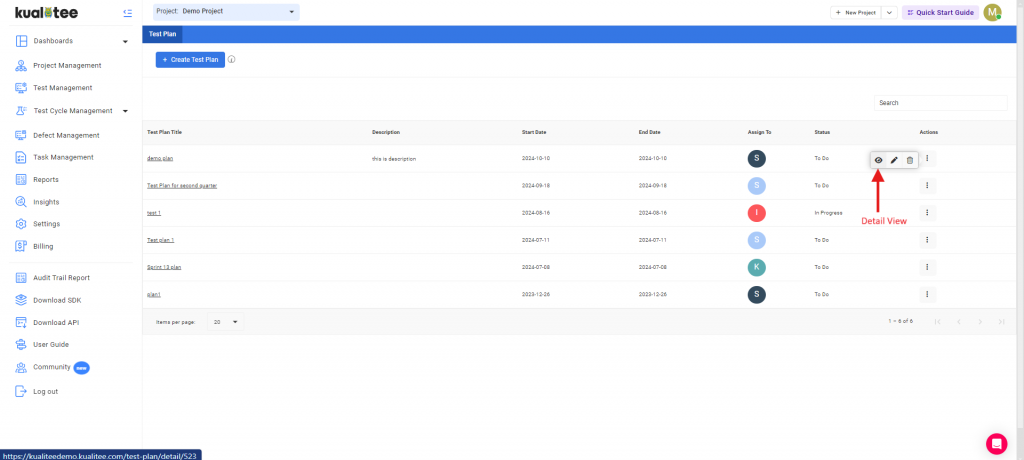
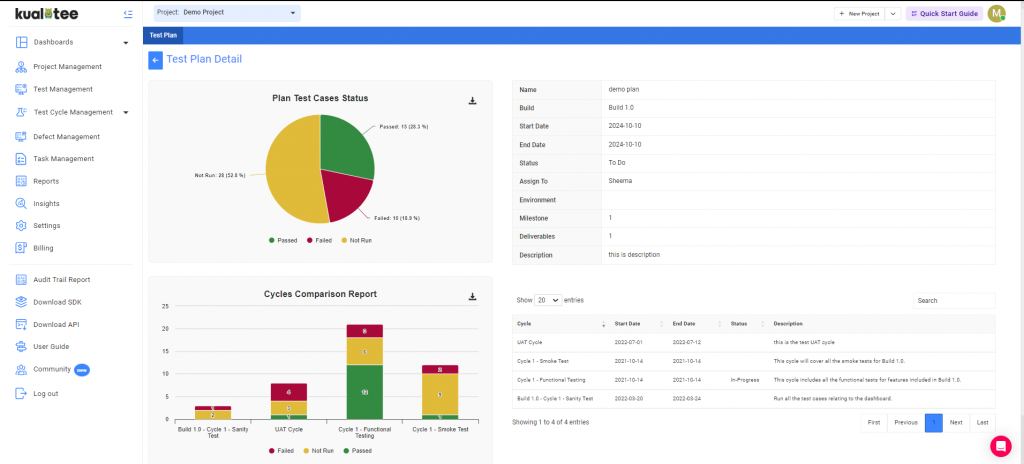
Within Kualitee, users can include one cycle in a test plan at a time. If you need to add the same cycle to another plan, you will need to create a copy of that cycle.
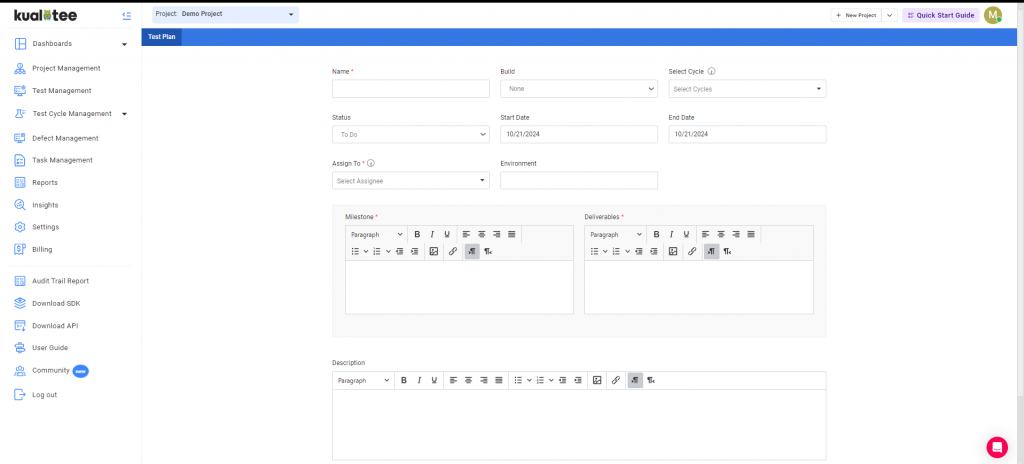
If a cycle is associated with a test plan, deleting it requires disassociation. Once a test plan reaches a status milestone, you can no longer delete it. This ensures the integrity of your testing processes and keeps important data intact within Kualitee.
Test Cycle
Kualitee offers a smooth testing experience with our Test Lab feature. Easily switch between Test Plans and Test Cycles to manage your testing tasks effortlessly. This will simplify your testing process and help your team stay organized with these user-friendly options.
1. Test Lab is expandable. It will have two main sections:
a. Test Plan
b. Test Cycle
Clicking on the Test Cycle leads to the Test Cycle listing as shown in the screenshot below:
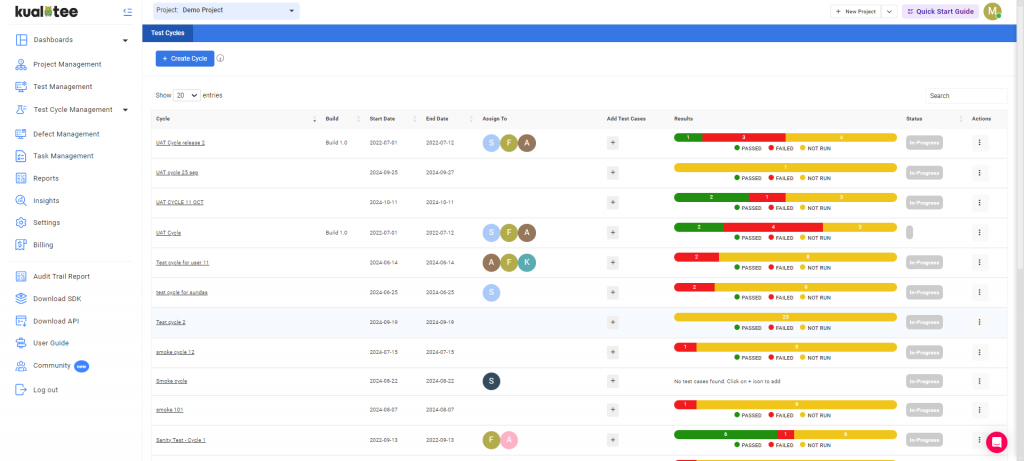
2. Create Cycle:
Once you click on Create Cycle, you will be redirected to the Create Cycle form where you can create the cycle:
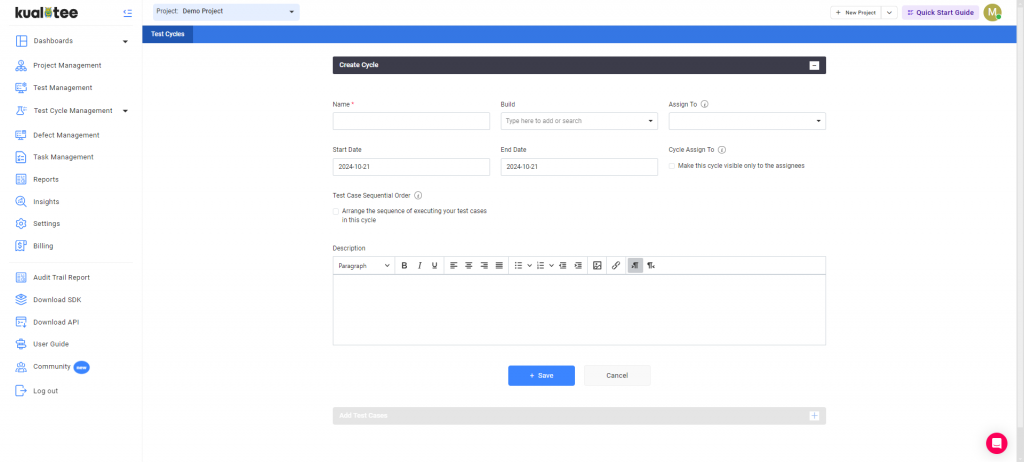
Adding Test Cases to Cycle:
After you go through the cycle creation process, the next step is to add test cases to the cycle:
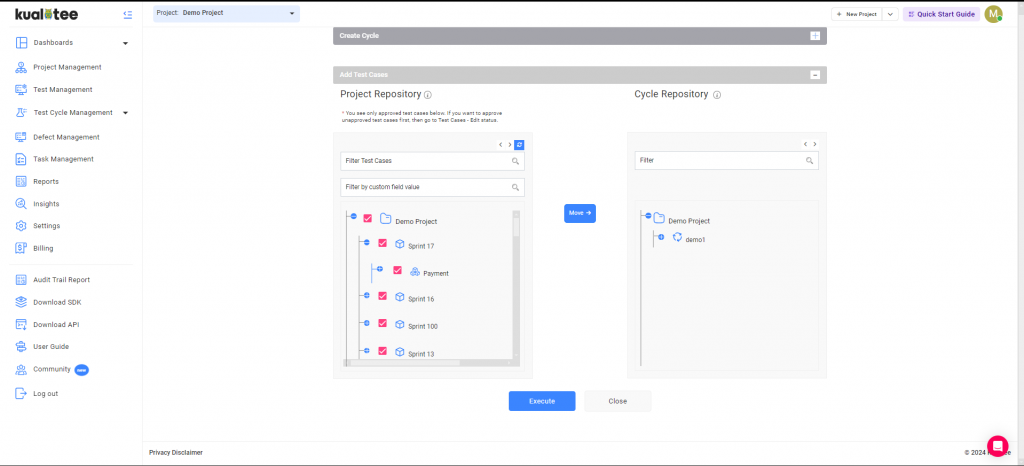
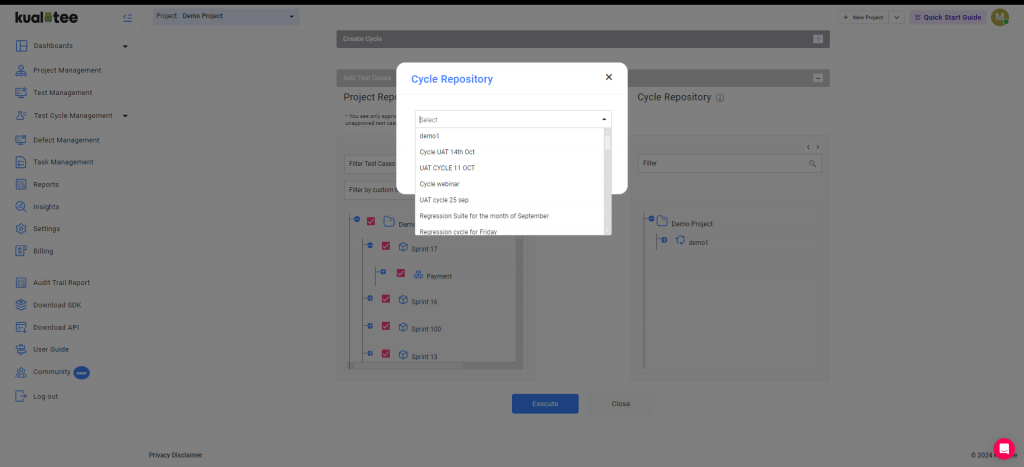
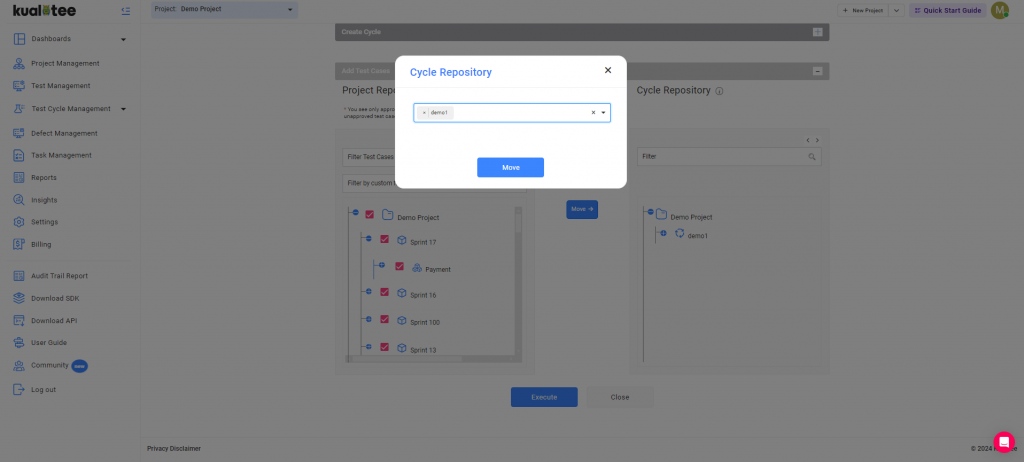
Once you are done with the addition of test cases, you will be redirected to the Execution listing screen.
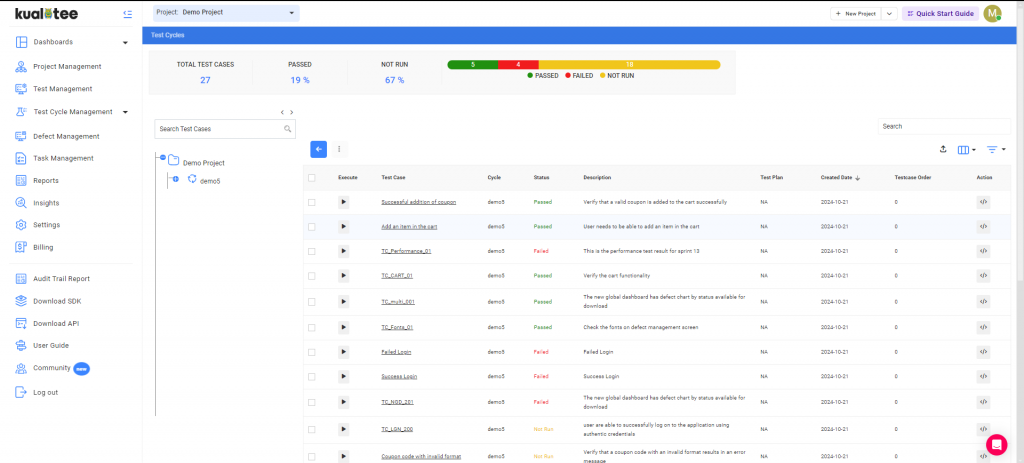
Click on the Play icon, and you will be ready to execute your test cases.
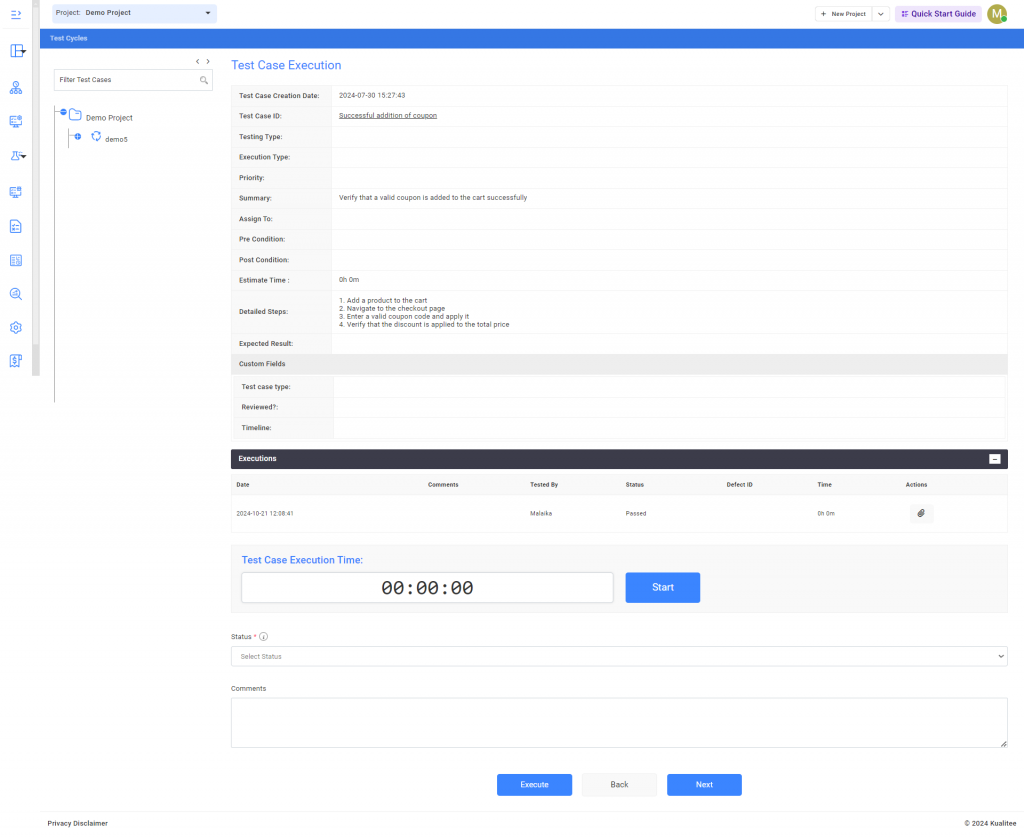
Removing Test Case from Test Cycle
You can delete any test case from your test cycle, by pressing the Ctrl key and selecting the test case. The ‘remove’ button will appear at top of the cycle repository; by clicking the ‘remove’ button, the selected test case will be removed from the respective cycle.
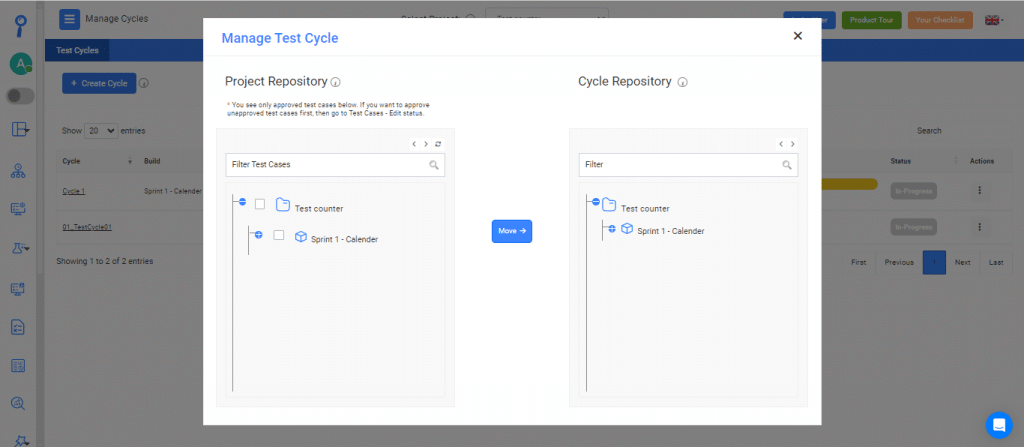
Click on the Play icon, and you will be ready to execute your test cases.
Defect Management
Defect Management gives you a detailed picture of the type of defects. You can capture a bug by reporting different aspects of abnormalities in our information-rich format. You can further manage your defects by approving, assigning to developers, rejecting, and logging comments for future references. Bugs can be tracked in multiple ways, simplifying the process manifold through different viewing formats. You can monitor the bug history at any time with multiple information pointers.
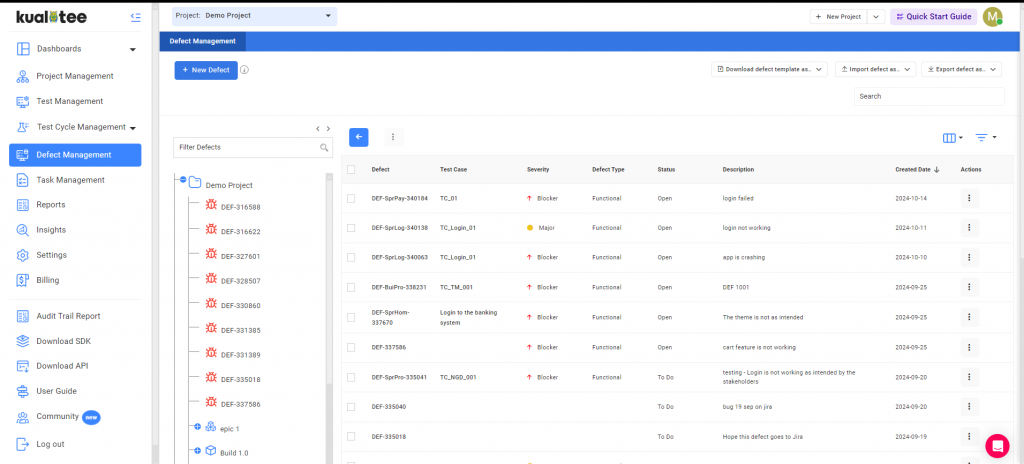
Creating Defect
Ensure that a project has been selected and then move to defect management by clicking on the left side pane.
Defects Ids are auto-generated. You have to add the defect description. But we have the following additional fields in which you can add details to make the defect more specific.
You have the following fields to provide details on the defect in defect management other than defect decscription.
- Build
- Module
- Defect Type
- OS
- Severity
- Status
- Steps to Reproduce
- Actual Result
- Expected Result
- Comments
- Assign to
- Priority
- Attach Video
- Attach multiple images
- If you have integrated with JIRA, also select the JIRA user
Clicking on the Save button will create the defect.
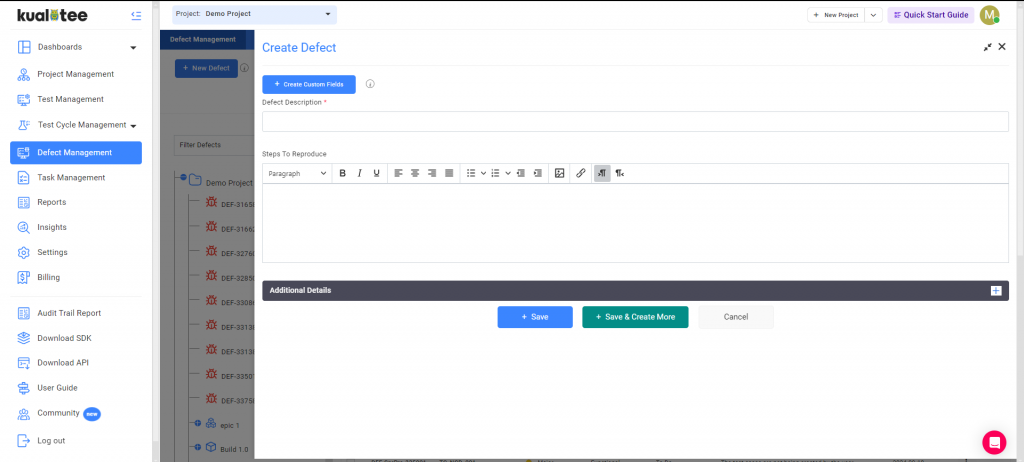
Import and Export of Defect
Additionally, you can also import your already created defects, you can either upload your own copy and map the fields according to Kualitee fields using the in-app mapping wizard or you can download the template and use that to upload your list of defects.
You can export your data in three different formats CSV, Excel and Word. Clicking on any of the icons will get your file ready for export and prompt you when it is ready for download.

Action Button
- Delete: You can delete your selected Defects in bulk.
- Copy: You can save a copy of your selected Defects in the same project.
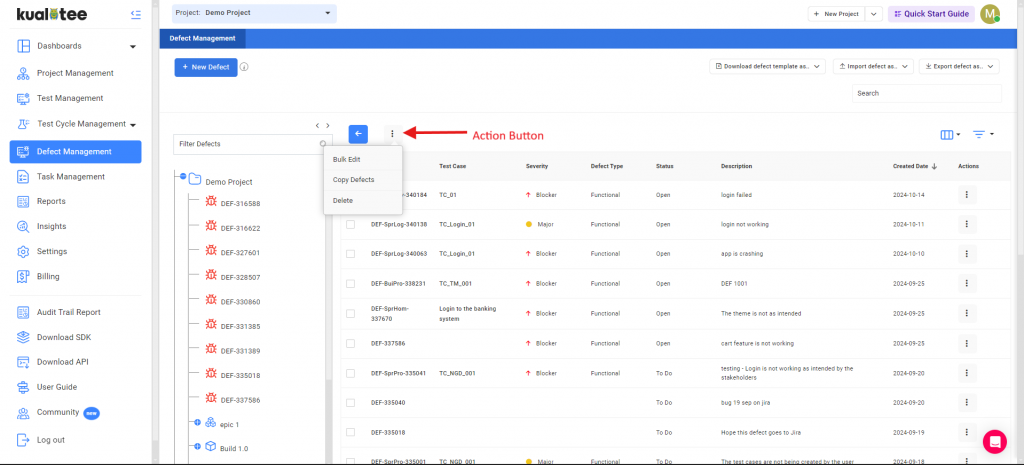
Bulk Edit
You can use the bulk edit option to change associations between data — e.g build, module and requirements associated with your defect can be changed using the bulk edit option for selected or otherwise all of the items in the listing. Also, you can edit your custom created fields too from the “Bulk Edit” option.
Note: Associations once changed cannot be reverted back to an earlier state.
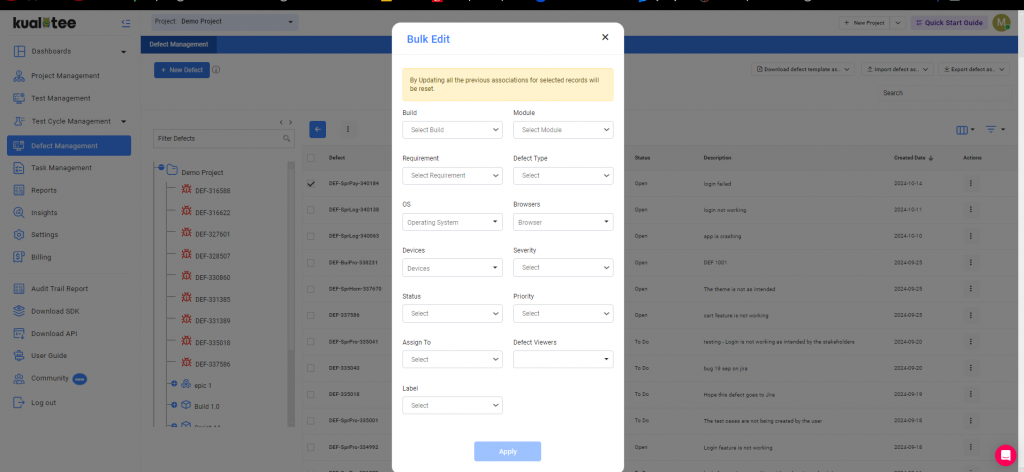
Filters
Multiple filter options are available in the Test Scenarios tab to filter out the defects.
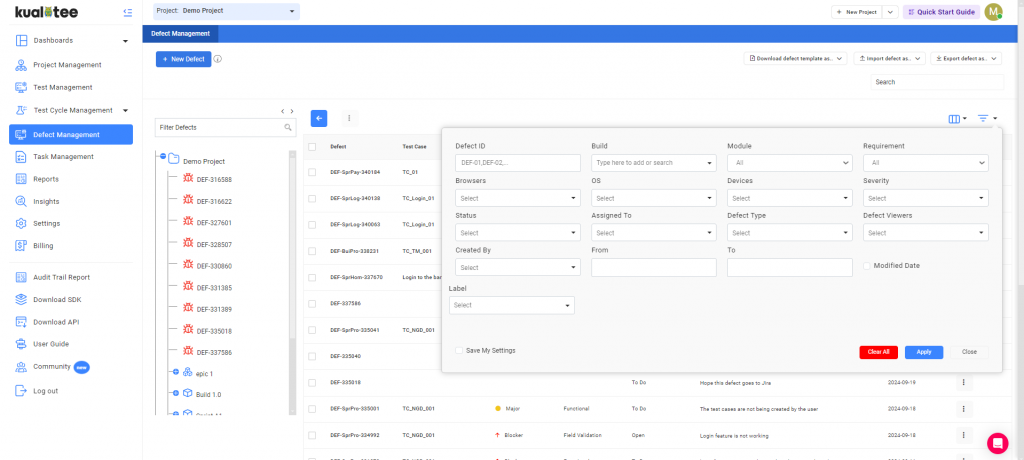
Customize Listing:
You can now view your custom fields on your listing page from the custom listing option.
To add custom fields to your listing pages, follow the steps below:
- Click on the “Custom Listing” option.
- Select the fields you want to view on your listing page, and they will be displayed.
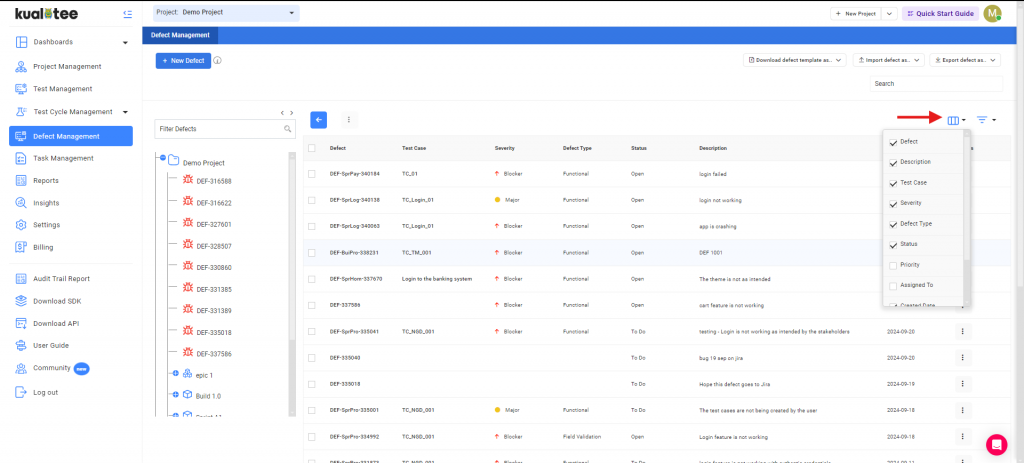
Full View
Full view can be accessed when you review the specifics of your Defects. As you move your cursor over the action items in the corresponding column, a complete view icon will appear. Clicking on it will reveal the full view, opening up to your saved details, attachments, and comments. You can also make edits directly from this section.
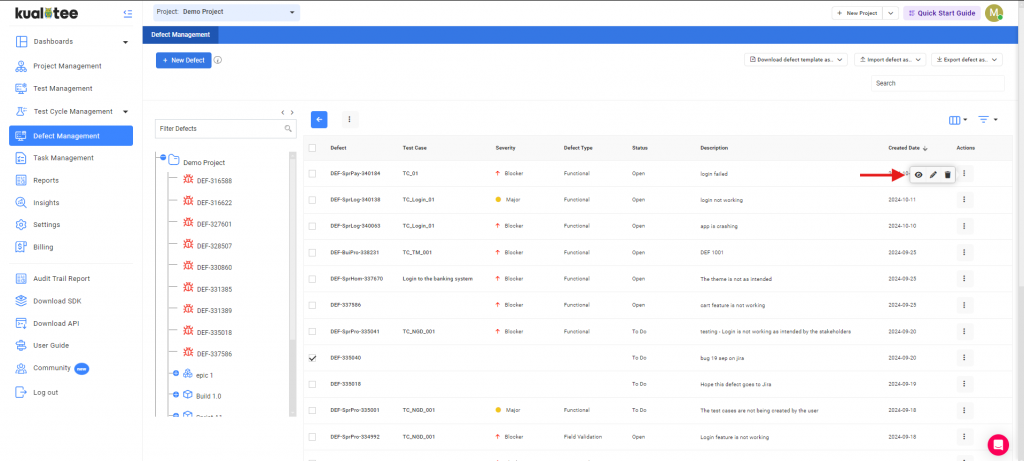
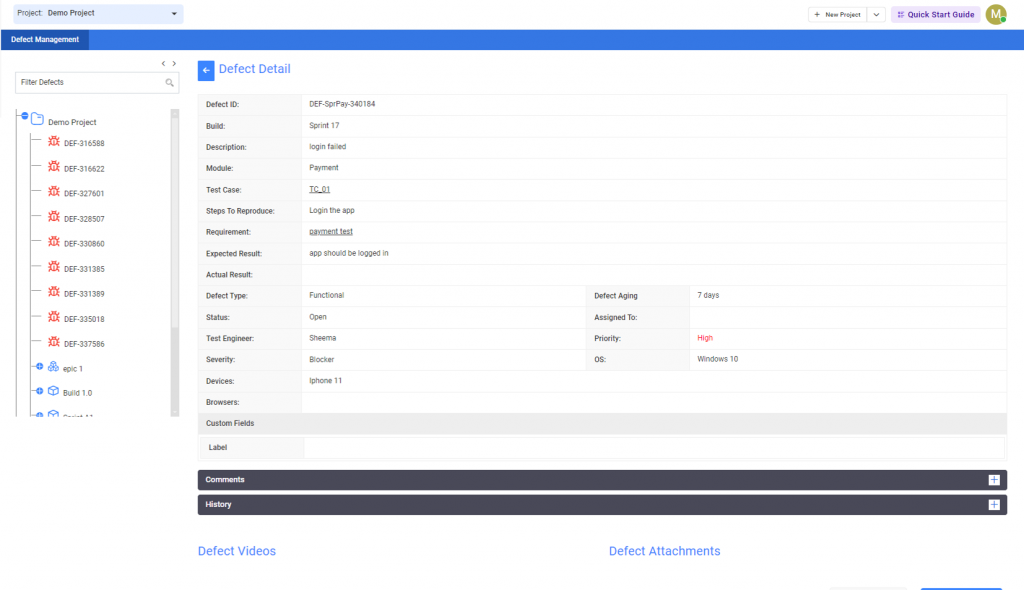
Task – Calender View
In tasks, you will see tasks and timelines for your project. You can view the details of each task by bringing the cursor on it. The details include:
- Project Name
- Start and End date
- Module
- Assigned to
- Assigned by
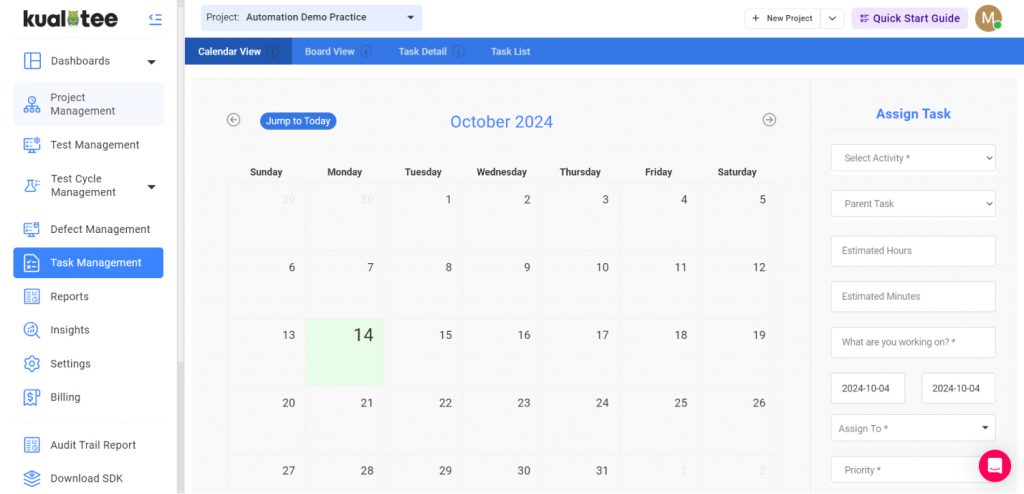
We offer customization of colours, so users can differentiate between projects.
You can create, edit and assign new tasks to your team members by clicking on any of the dates you wish to start your project from.
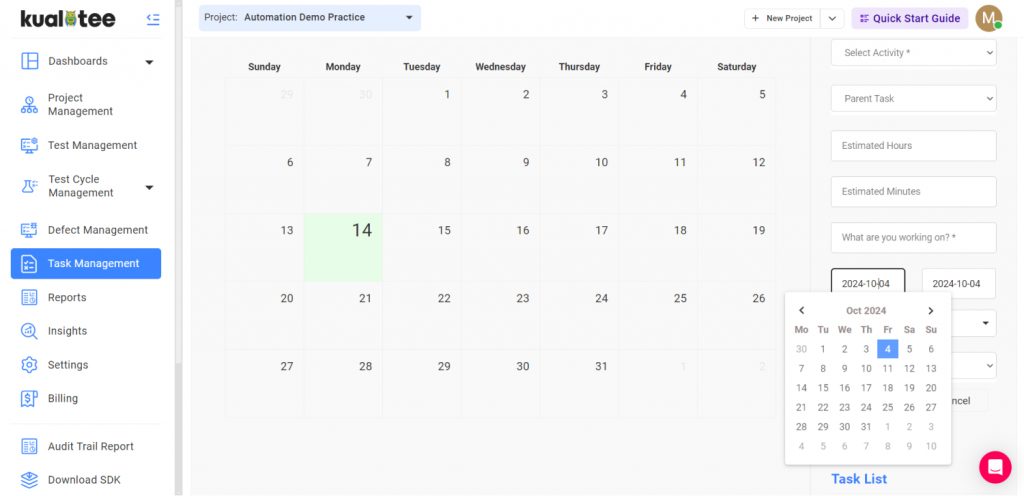
Once you have successfully created and assigned the task, a notification will appear on the ‘Notification Bell’. Your task will also be represented on the calendar under the color you have chosen from the start to end date. You can check the brief details of the task by bringing your cursor on the color.
Tasks – Board View
No matter what methodology you use Scrum, Kanban, or your own unique approach; Boards are built to support you, so you can work your way.
Columns:
Define your own columns for each process, and use them to quickly see the status of each task — and what still needs to be done before you can reach your goals.
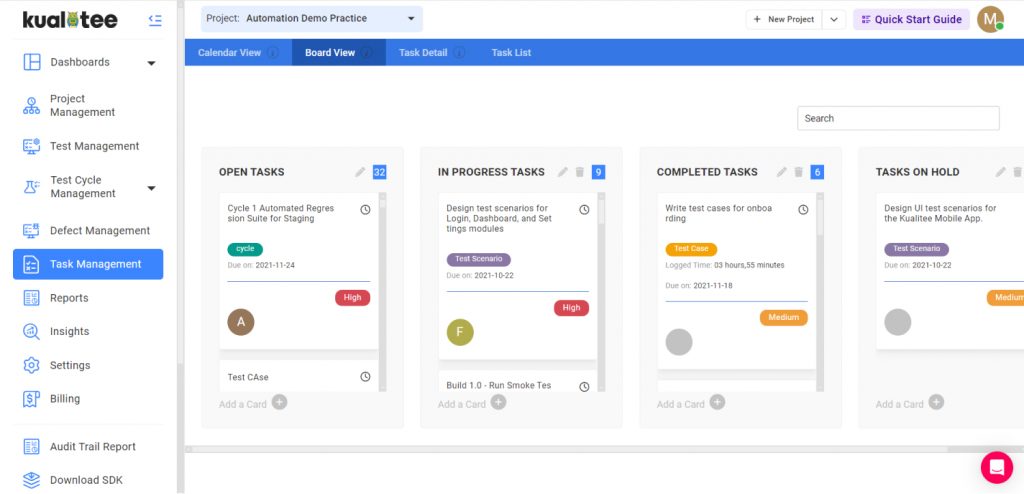
Drag & Drop
You can drag and drop tasks and columns to reorganize your work or move it through stages. Project members can rearrange tasks as needed, and followers will get updates when tasks move columns so all members stay on the same page.
Task Details
The task created by you is also shown in ‘Task Detail’ where you are able to log and track time against those tasks. Task Detail page shows your current tasks.
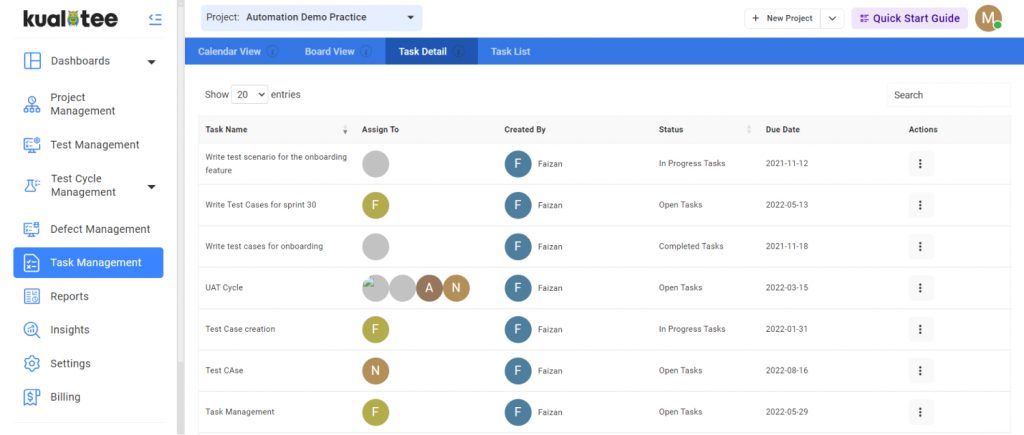
Time Log
You can log time and select whether you would like these hours to be logged as your billable hours.
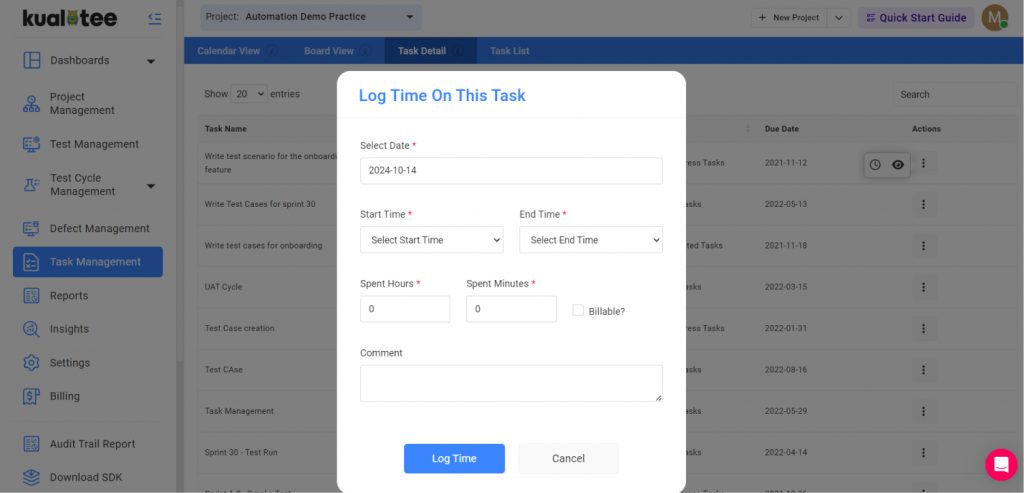
Build Traceability Reports
Build Traceability facilitates visualization of the hierarchy of test cases and defects in a tree structure.
Users can easily view the hierarchical structure from builds to defects, while being able to see details on each node of a test case or defect.
This plays a role in the efficient identification and resolution of issues throughout the testing process.
To generate Project Traceability Reports:
- 1. Go to the Reports module
- 2. Go to Traceability Reports > Build
- 3. You will be able to view a dynamic tree with the details
You can download the report in PNG or SVG format.
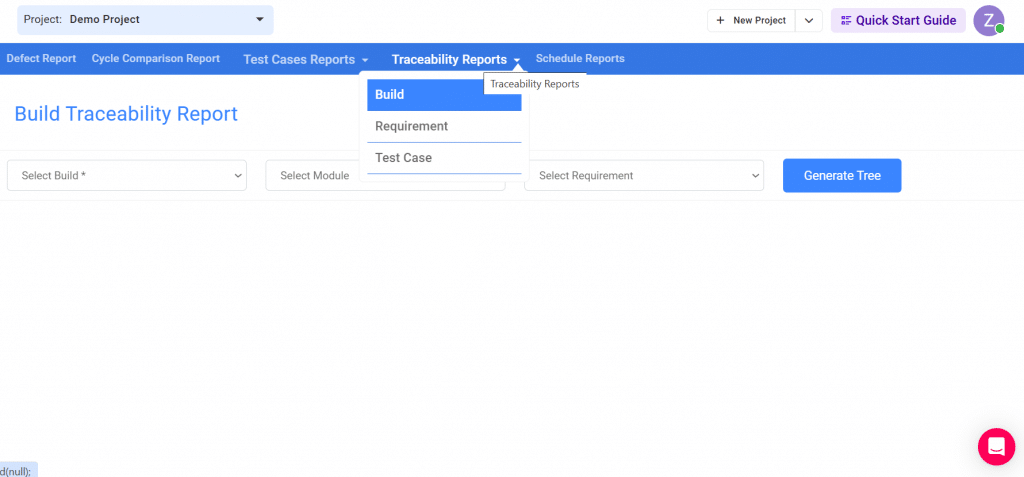
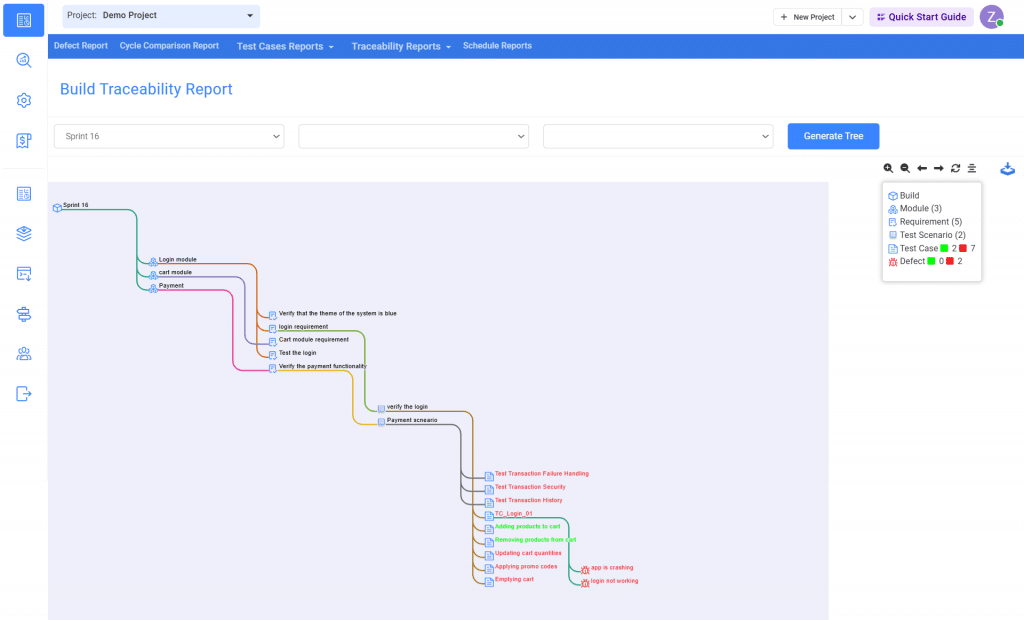
Defect Reports
The bug tracking report is one of the most important elements of a bug tracking system. The report is what tells every detail about a bug and how it was handled or is being handled. It is very important that each report is detailed. Bug tracking reports need to include certain pieces of key information. The following list portrays what’s in each and every report issued.
- Build
- Module
- Status
- OS
- Browser
- Assign to
- Severity
- Cycle
- Date
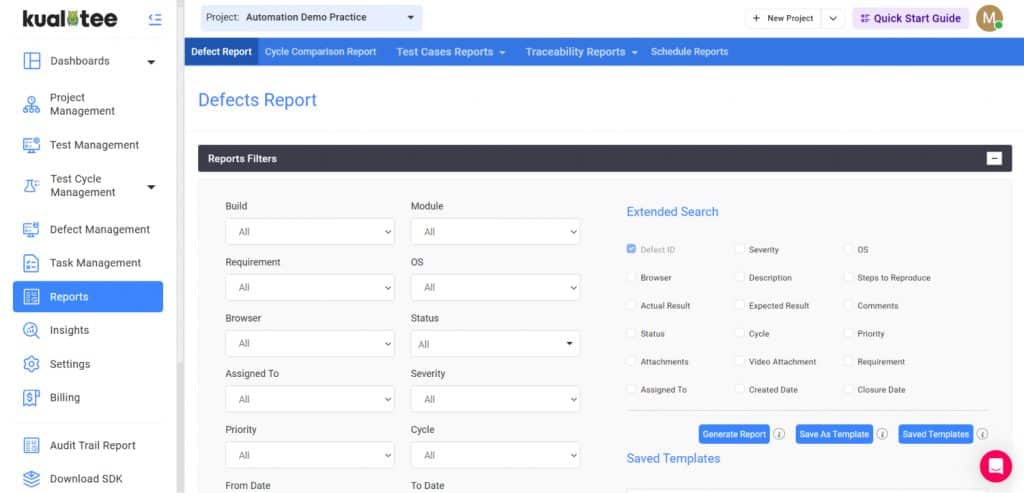
Export Defect report to Excel, CSV and Word. Also, you can make an extended search on the basis of defined parameters.
Test Case Reports
Under test reports you can develop custom test reports with key information such as:
- Build
- Module
- Test Case Status
- Cycle
- Date
Extended search allows you to filter through to the exact Test Report you are searching for and then take exports of the custom report that you have generated.
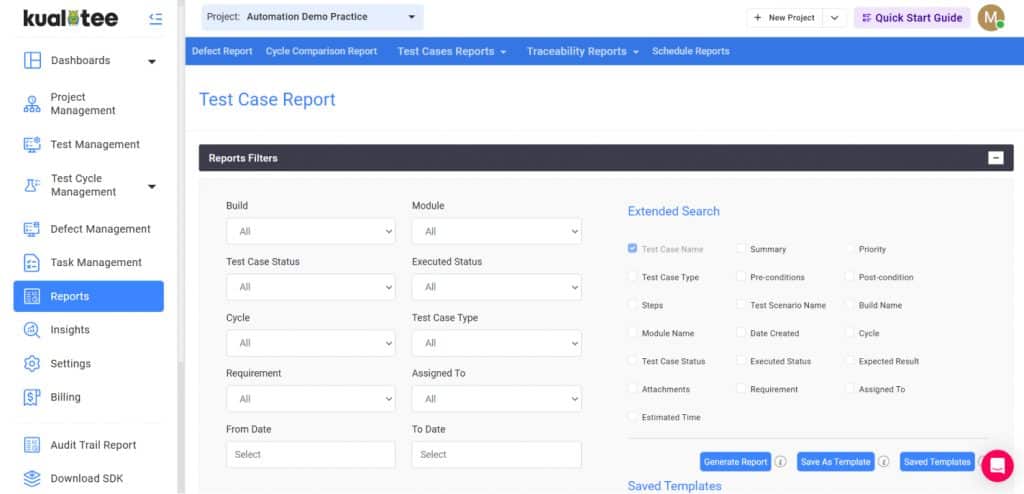
Export Test Case report to Excel, CSV and Word. Also you can make an extended search on the basis of defined parameters.
Test Execution Reports
Under test execution reports, you can develop custom reports with key information such as:
- Build
- Cycle
- Tested By
- Selected Executed Status
Extended search allows you to filter the exact results that you are searching for.
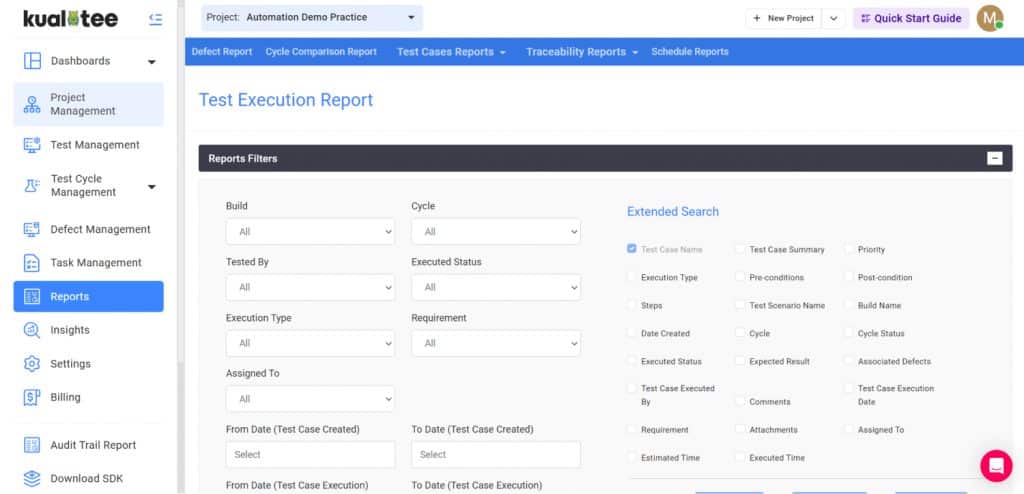
Export the report in a format of your choice, e.g. Excel, CSV or Word. Also, you can make an extended search on the basis of defined parameters.
Scheduled Reports
Scheduling reports help you streamline the information during off-peak hours. You can set the frequency of all the reports available in the reports module.
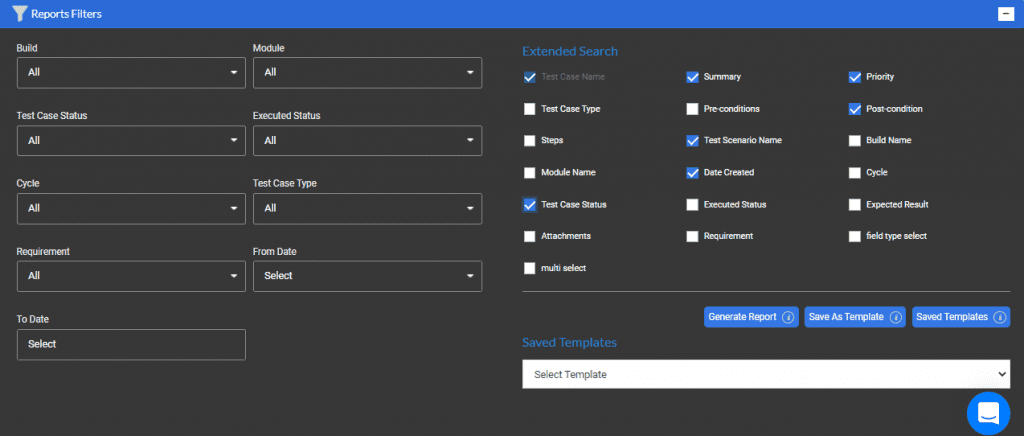
To get started you simply,
Save filters as templates for reusability
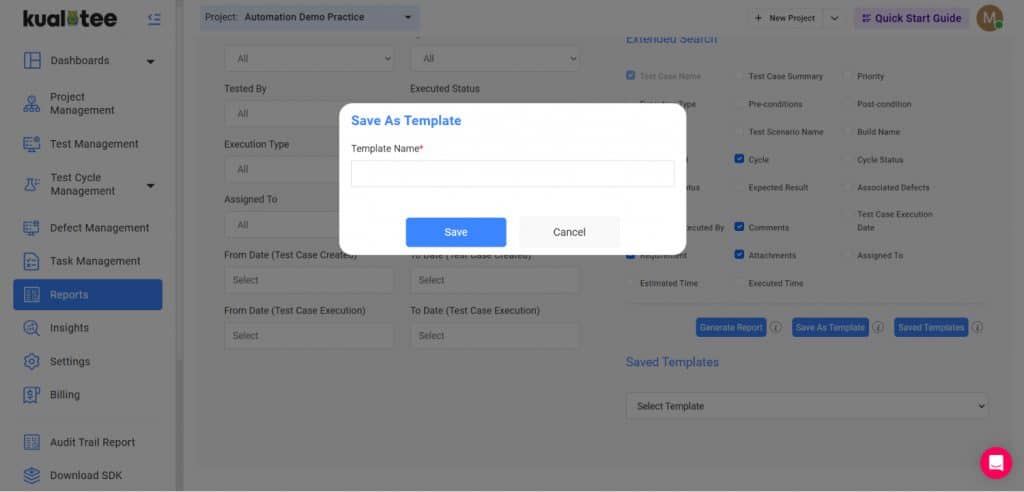
Scheduling Reports
To schedule auto-recurring reports. You simple
- Choose the report type as in Bug Report, Test Case Report, or Execution Report
- Choose one of the saved templates so you don’t have to set filters every time
- Choose Frequency whether you want daily, week, biweekly or monthly reports*
- Choosing the report format whether you want it in CSV, Excel, or Word
- Choose team members who are part of the project who should receive similar updates
*Kindly note that the reports are generated according to GMT
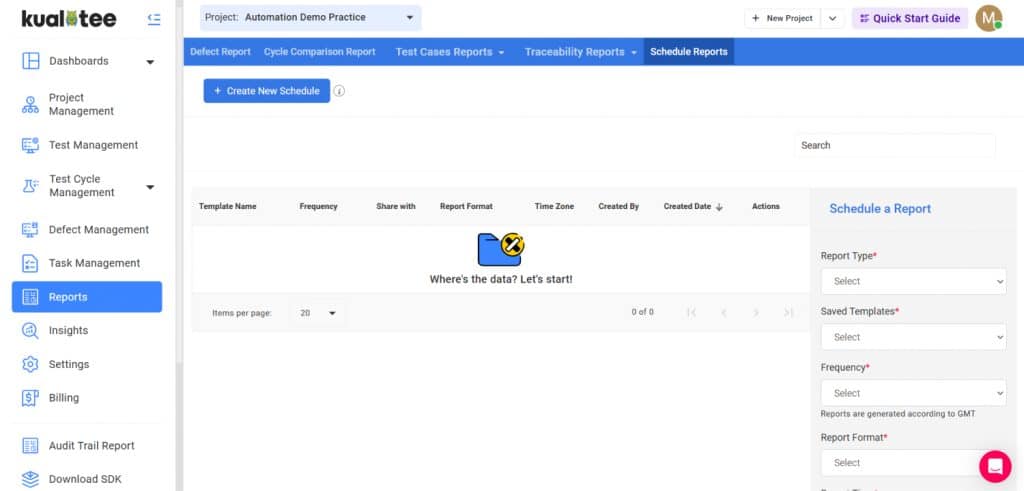
Once the reports are scheduled, they show up in the list. You can discontinue at any time by simply deleting the scheduled report from the list.
Cycle Comparison Report
A cycle comparison report comprises of comparison of multiple cycles and the stats of those cycles. You can make a comparison of cycles having the same test cases but are executed in different environments and get a report of their execution statuses. Besides a graph, there is a table in which you can get the count and percentages of the test cases according to their status. Also, you can select your desired cycles for comparison too.
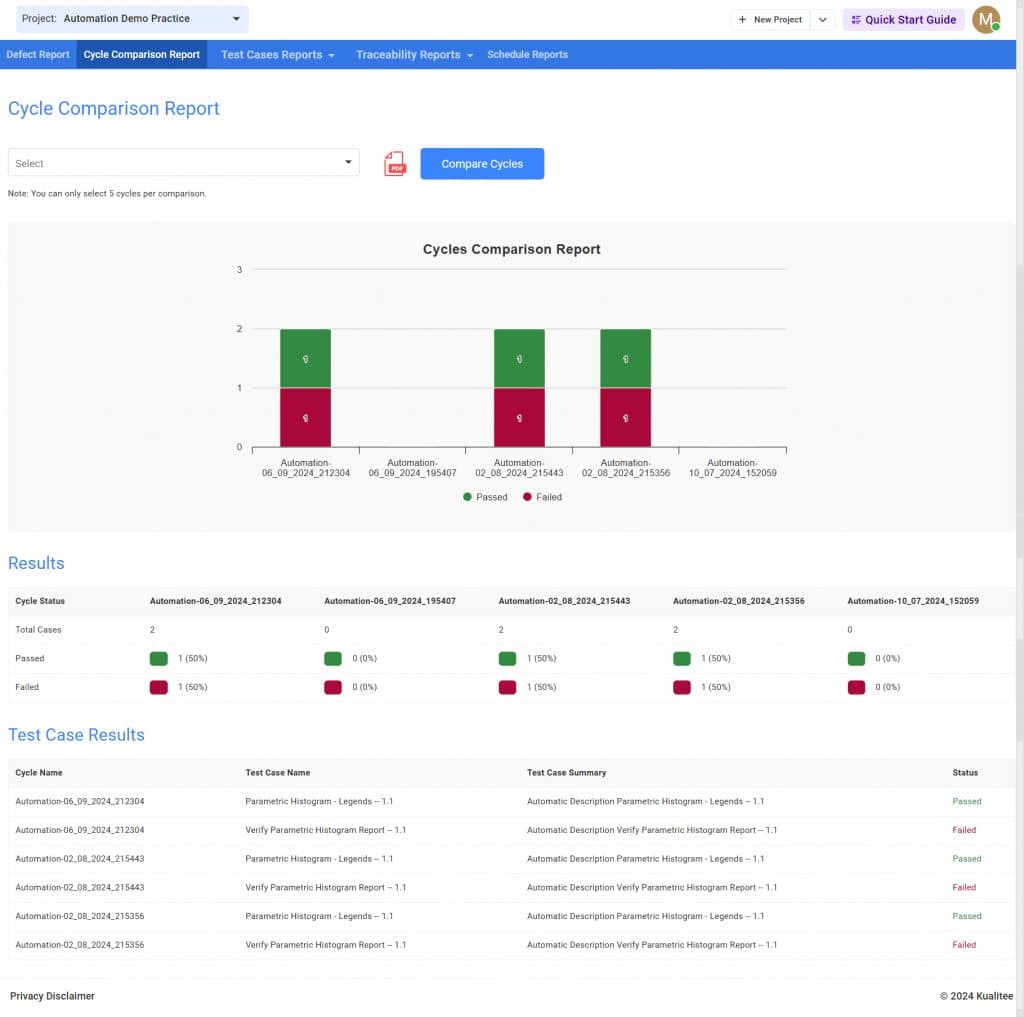
Steps to generate a Cycle Comparison Report:
- Go to “Reports”.
- Go to “Cycle Comparison Report”.
- The cycle comparison report will be displayed.
Test Case Traceability Report
A test case traceability report encompasses the following: your test cases, their execution, and the defects associated during the test runs/cycles. Kualitee has now implemented the feature of a test case traceability report, letting you extract a report related to your test case execution in multiple test runs/cycles and their associated defects. You can also export the generated report in xlsx. format.
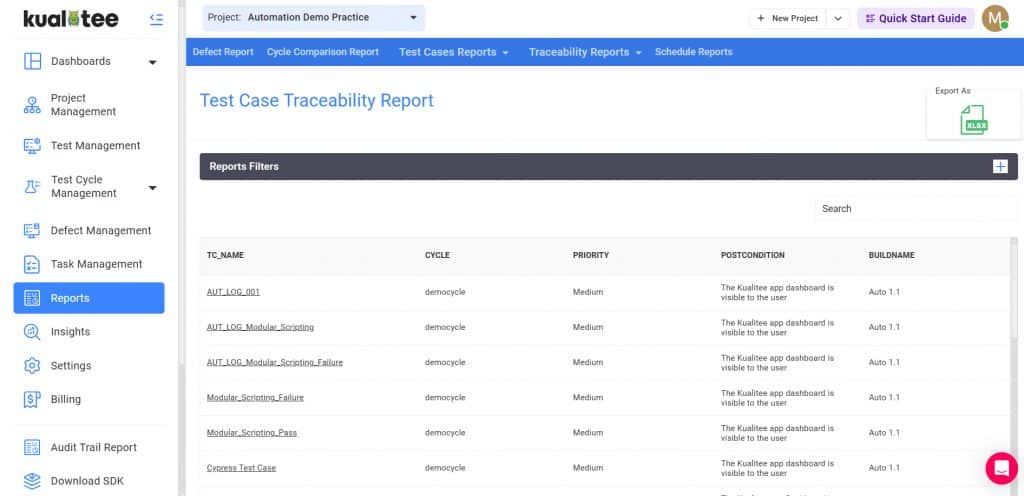
Follow these steps to extract a test case traceability report:
- Go to the Reports section.
- Click on “Test Case Traceability”.
- Apply filters according to your requirement from the left panel, and select the desired columns you want in your report from the right panel.
- Click on the “Generate Report” button and your report will be generated.
Requirement Traceability Report
A Requirement Traceability report encompasses the following: your requirement, test cases associated with those requirements, their execution, and the defects associated during the test runs/cycles. Kualitee has now implemented the feature of a requirement traceability report, letting you extract a report related to your requirement coverage and its test case execution and their associated defects. You can also export the generated report in excel.
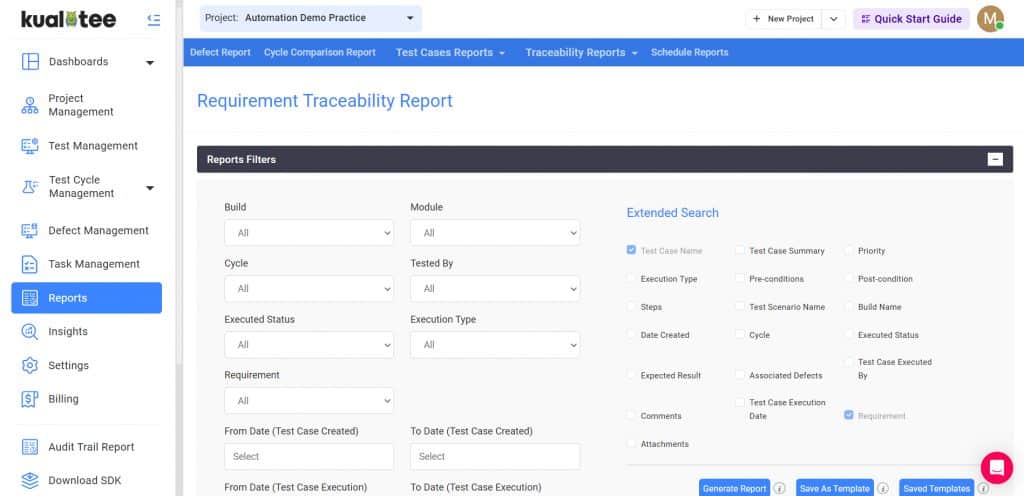
Follow these steps to extract a Requirement traceability report:
- Go to the Reports section.
- Click on “Requirement Traceability”.
- Apply filters according to your requirement from the left panel, and select the desired columns you want in your report from the right panel.
- Click on the “Generate Report” button and your report will be generated.
Insights
Test Effectiveness – Test Effectiveness represents critical and major defects in relation to total number of defects for every module.
Team Effectiveness – Team Effectiveness represents rejected defects and defect quality for each team member. Defect quality is percentage of Critical and Major defects in proportion to total defects.
Test Efficiency – Test Velocity covers the average number of testcases executed per week.
DEV Team Effectiveness – Development Team Effectiveness is measured through the percentage of resolved defects in comparison to defects assigned.
Test Execution Coverage – Test Execution Coverage represents test cases against requirement and shows the percentage of the executed test cases with each requirement.
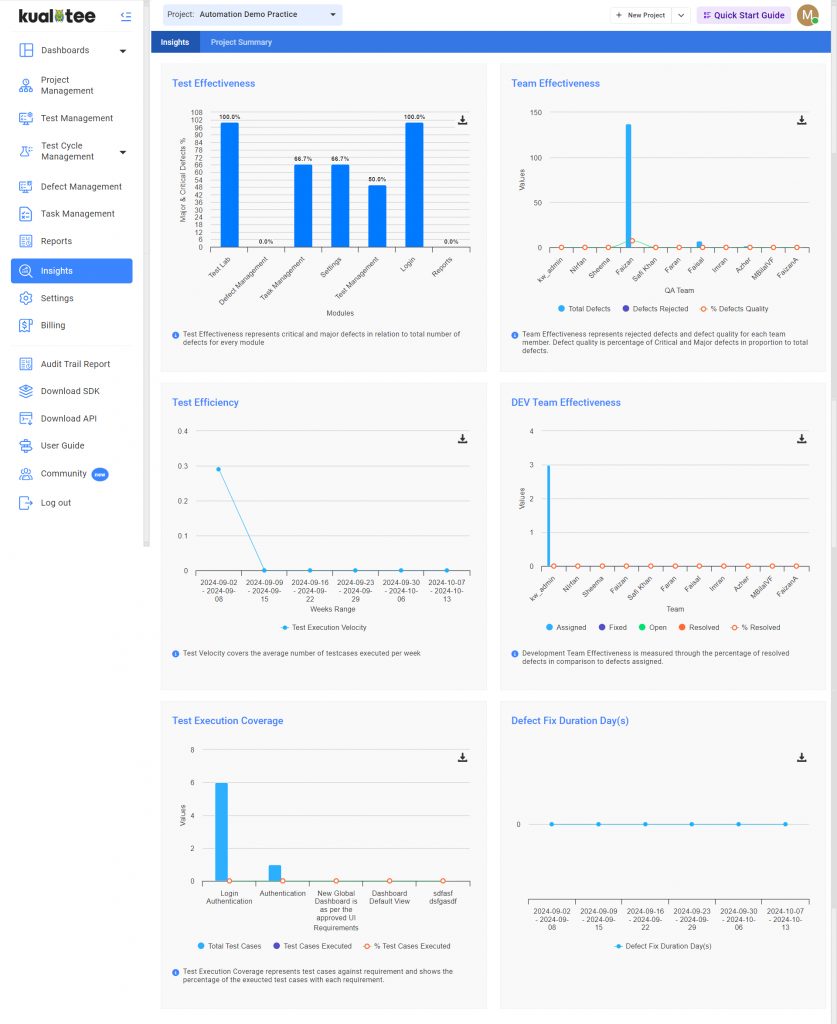
Roles
Kualitee allows you to create roles with certain set of privileges that are provided to keep users under specific job roles. You select and apply privileges to a role and transfer them to a User.
The user then can use the role to perform the task that has been delegated to him under the parameters of his role.
Kualitee has 4 system roles i.e. admin_tenant, tester, test manager, developer. All these roles have specific set of permissions throughout the app. Please refer to the document for details of permission with each role.
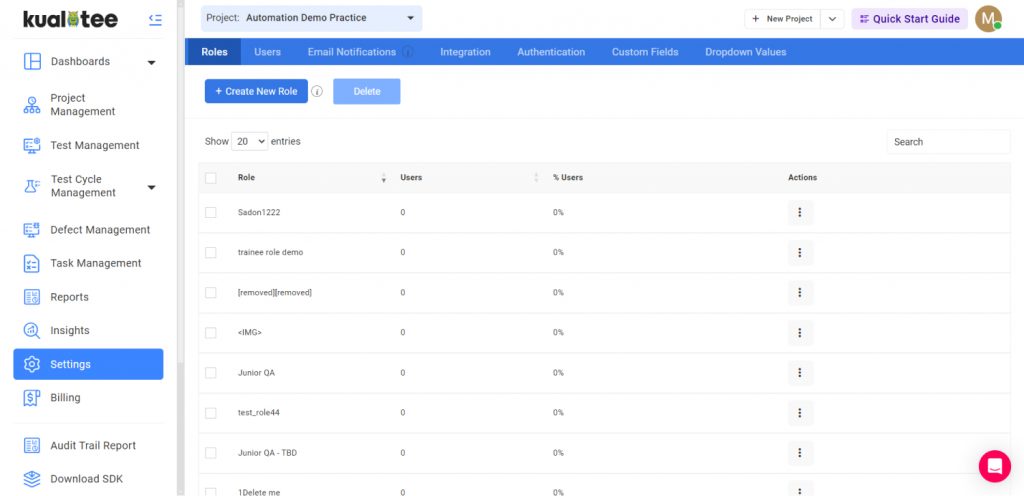
Create Role
Click on ‘Create New Role’ to enter the Role name and it’s description and after that you check in the box whether the profile is removable or not.
The detail to perform permission and action review can be performed by editing the user profile from Account distribution.
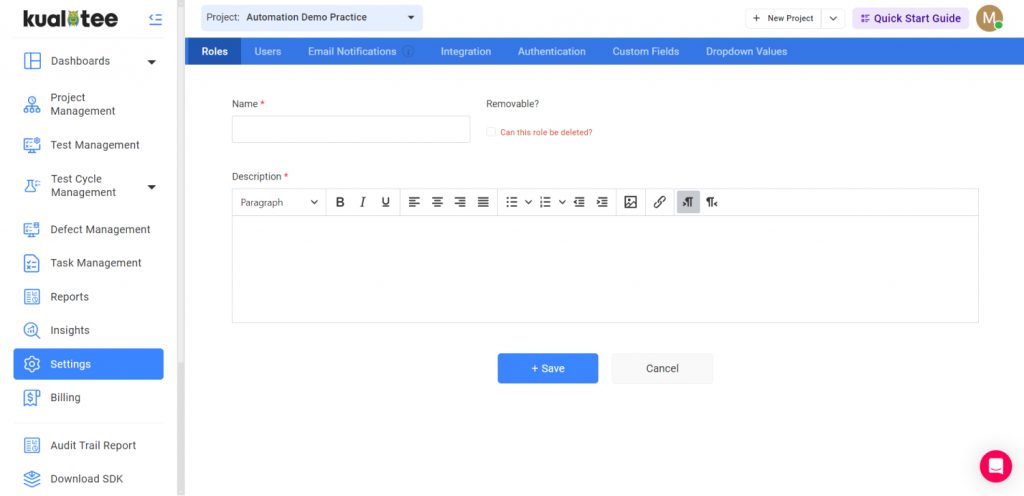
Permissions:
Only admin has the option to edit and change permissions of users. You can edit the role name, description and permissions.
- Role: Allows you to define the designation for the user being added
- Description: You can add description to the provided role
- Removable: Whether the created role or designation can be deleted.
- Permission: Includes what information the user can view while on Kualitee and actions that he/she can perform. Permissions include
- Reports: Whether it can be viewed or not
- Project Management: Whether it can be viewed or not
- Dashboard: Whether it can be viewed or not
- Test Management: Whether it can be viewed or not
- Bug Management: Whether it can be viewed or not
- Test Lab: Whether it can be viewed or not
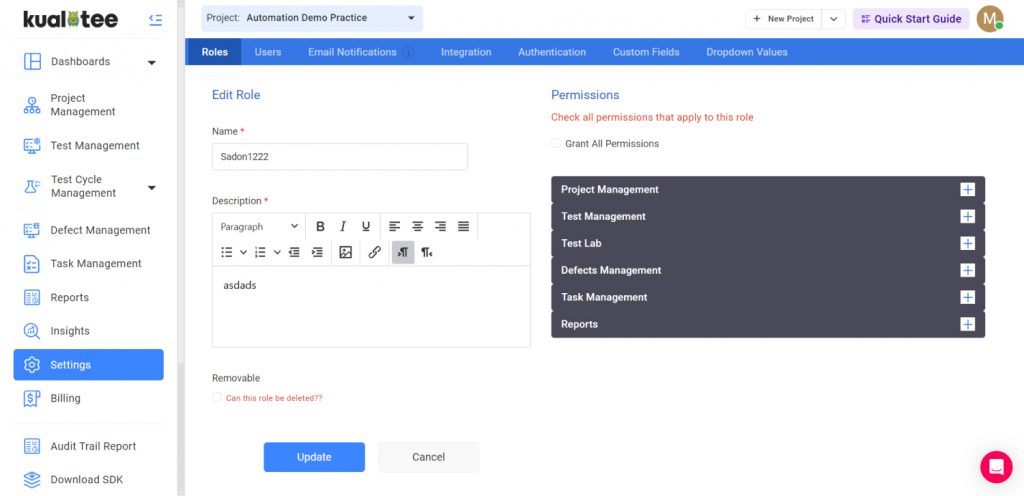
Clone Role
You can clone any custom/ system role that you create, instead of manually creating a role from scratch.

Users
“Users” is a very important feature of Kualitee. Here, Admin can add a list of Users and build their team on the domain. These users can later be assigned to different projects from the project management tab.
- Click on “Settings” tab shown on the dashboard.
- Click on “Users” button.
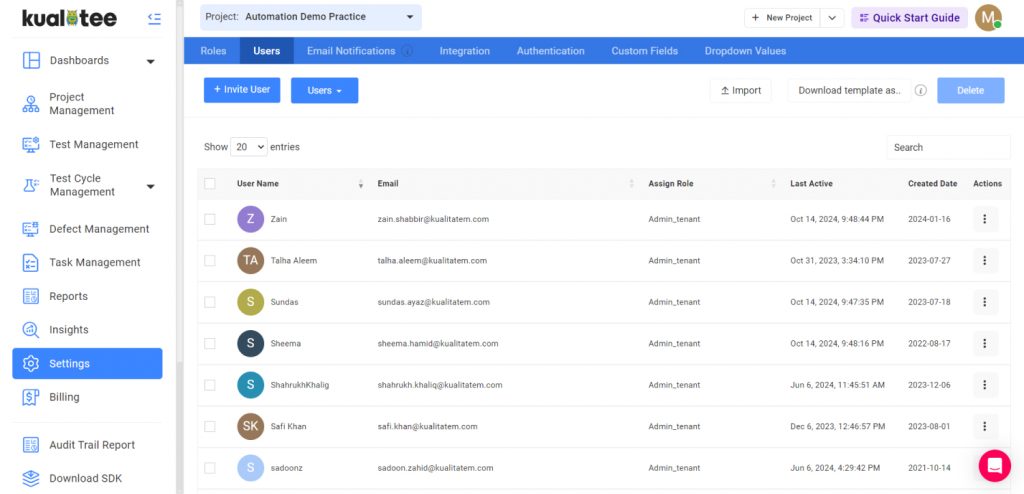
Create New User
To start adding your team to Kualitee, simply click on ‘Create New User’ and provide brief details, assign each member a role, and select the project you want them to be added to. The roles are domain based which means the user’s level of access will remain the same on every project.
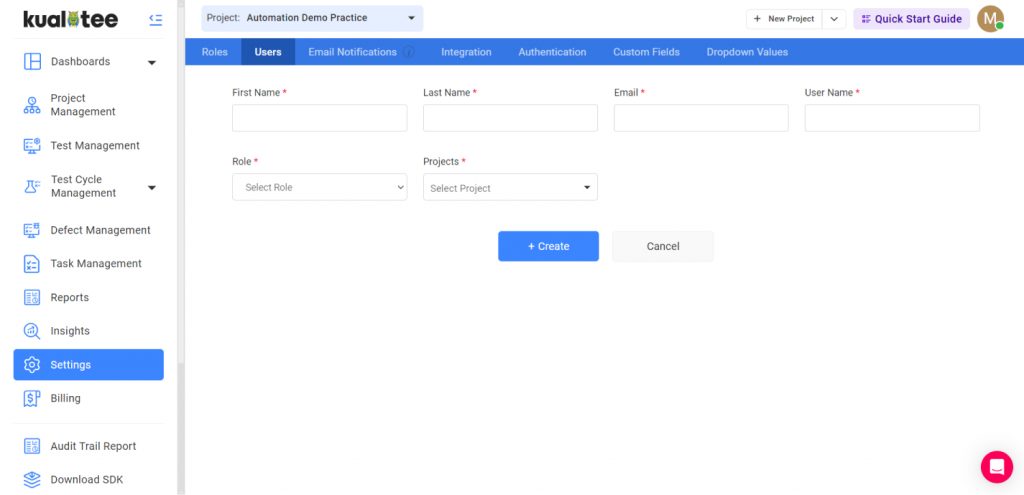
Inactive Users
Users who have been sent the invitation link but have not yet activated their account are listed in the inactive users page.
Email Notifications
Under the tab of ‘Email Notifications’ you select what email should be send to which role
Scenarios are:
- Test Cases
- Test Case Execution
- Defect Management
Email notifications are user based. So, we can customize the notifications for each user according to each module.
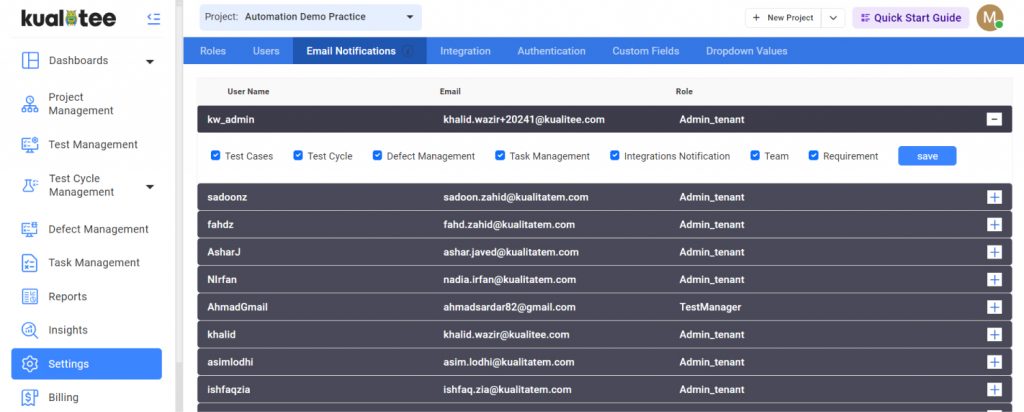
Custom Fields
In case, you require adding more information to your defect reports, test scenario or test case, you can add them through the custom field feature in settings.
Take advantage of the wide array of fields like e.g. Text Box, Text Area, Multiple Selection, and date fields etc.
Create, Edit or Delete:
You can create custom fields by clicking on ‘Create New’ Select your Project and then select the module in which you would like to add the fields.
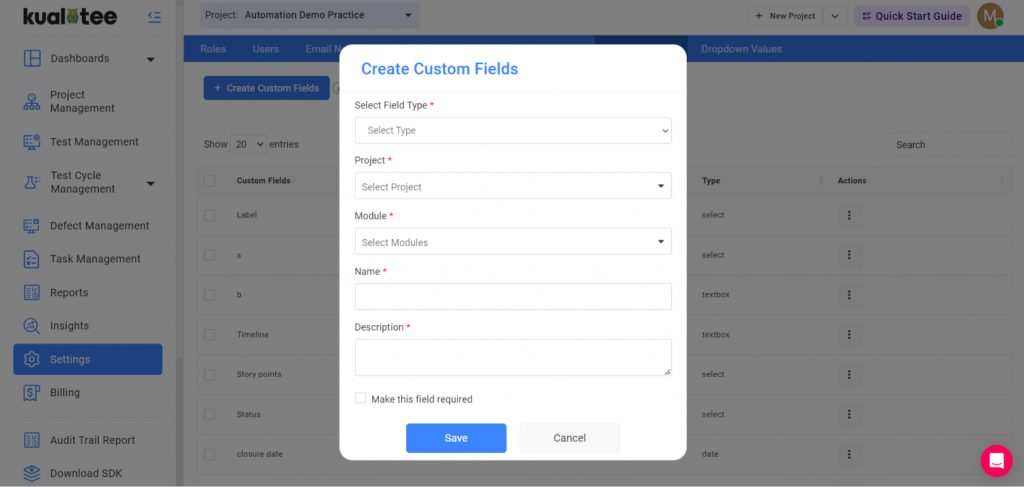
In “Select Project” select the project in whose module you would like the custom fields to appear.
Select Module the particular module you would like the custom fields to appear. You can create custom fields in your Defects, Test Scenarios and Test Cases.
Name your fields, add description and choose the type of fields you would like to add. You have the option select
- Text Box
- Text Area
- Multiple Selection
- Single Selection
- Date
Once you have inserted all the required information, click on “Create Field” to let it take effect.
Dropdown Values
The dropdown feature allows you to insert custom values that you require in different fields. Currently, you can add values in different fields in Project Management, Bug Management, Test Scenario and Test Case.
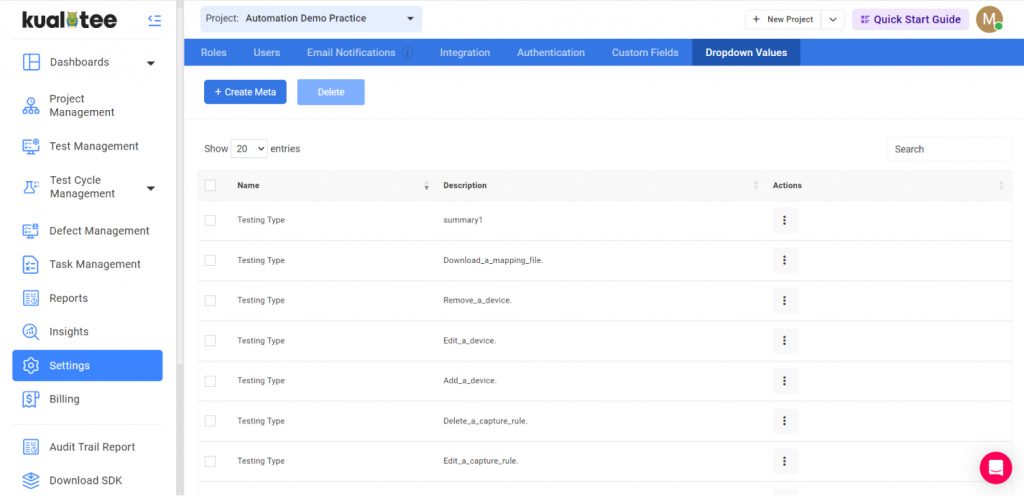
Create, Edit or Delete:
To create a custom dropdown option, go to Settings and select customizations and then choose dropdown.
Here, you’ll see the option ‘Create New’; click on it and you’ll be presented with the page below.
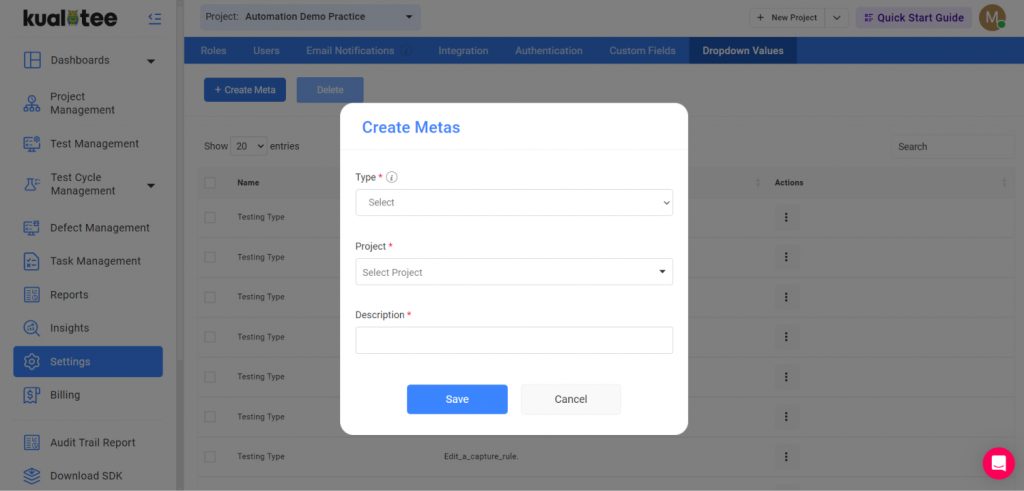
Playwright
Playwright is a powerful automation framework for end-to-end web testing. It enables reliable cross-browser, cross-platform, and cross-language automation, ensuring consistent user experiences. Kualitee’s integration with Playwright allows you to run Playwright tests directly from Kualitee and consolidate all your test reports in one place.
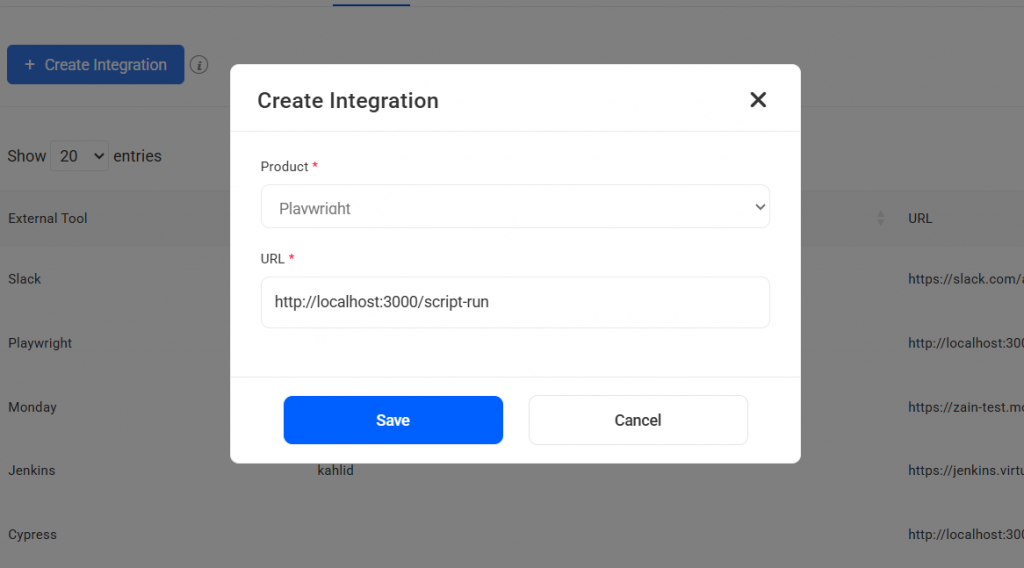
Key Features
- Generate Reports on Kualitee: Effortlessly generate comprehensive reports within Kualitee for your Playwright test executions.
- Execute from Kualitee: Run Playwright test scenarios directly from Kualitee and automatically update the status of your test cases.
- Centralized Reporting: Keep all your Playwright test results organized and accessible in a single, unified location within Kualitee.
Configuration
With the Kualitee Bridge, you can seamlessly integrate Playwright, enabling you to run tests and import results into Kualitee.
To configure the integration between Kualitee and Playwright:
Follow the step by step instructions in the given link to setup your server: https://www.npmjs.com/package/kualitee_bridge
To integrate on Kualitee:
- Go to Settings and select Integrations from the top bar.
- Go to ‘Create New’ in the external tool integration listing.
- Select Playwright tool from the drop-down menu.
- Enter server URL and end point of your server.
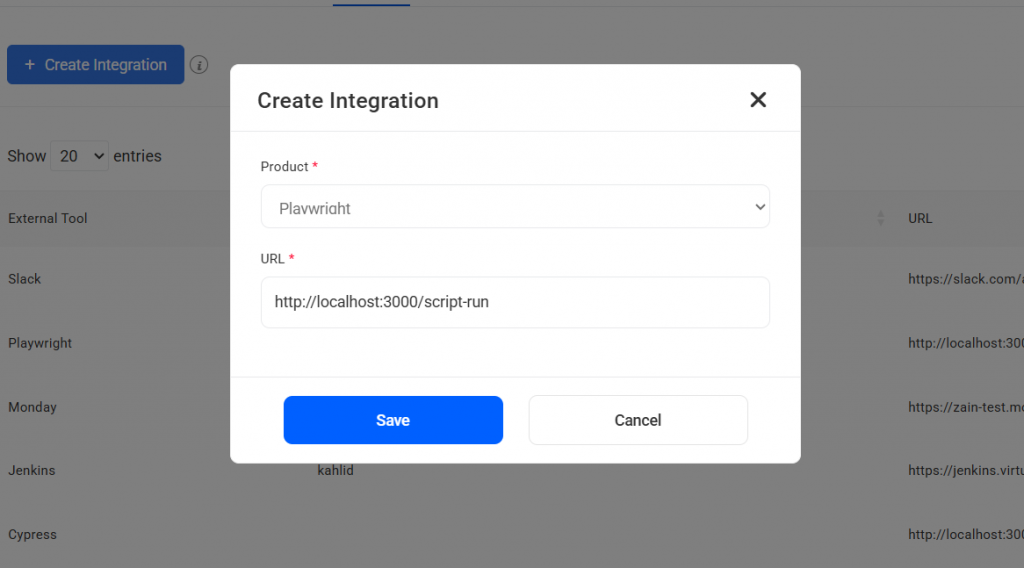
- Click ‘Save’ button to confirm a successful integration.
- To check if you server is up, click on Actions button next to Playwright integration and then click on Test server icon.
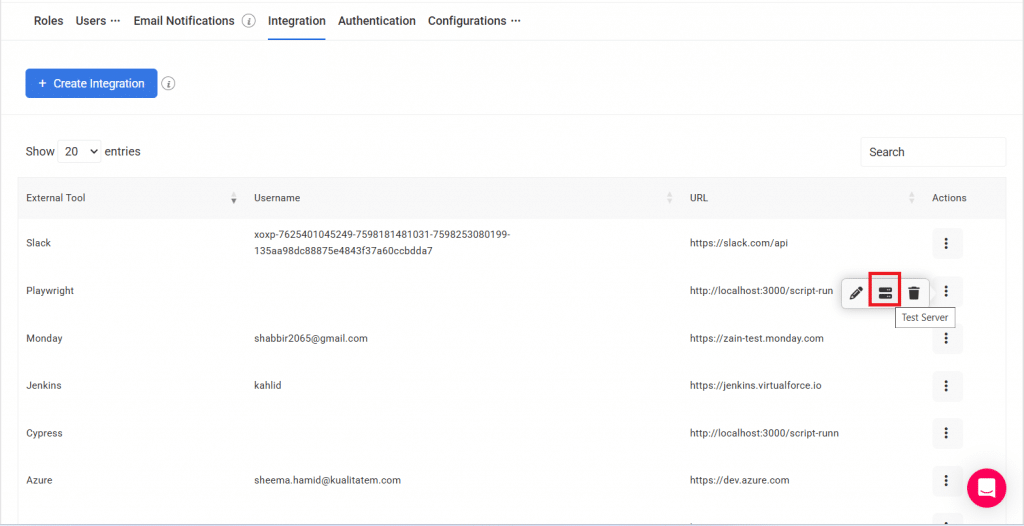
A popup will open, click on Check button to check the server status. A message will be displayed on popup about server status.
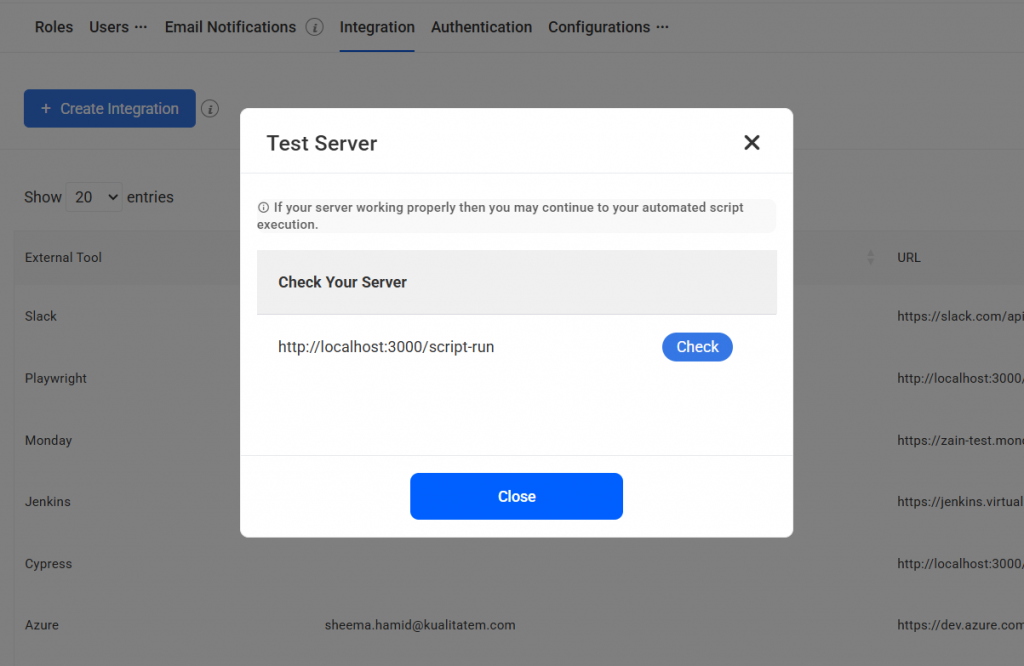
Now the server is up, go to Test Cycle management section > Test Cycles
Click on “Sync Playwright” button to execute test cases from Kualitee
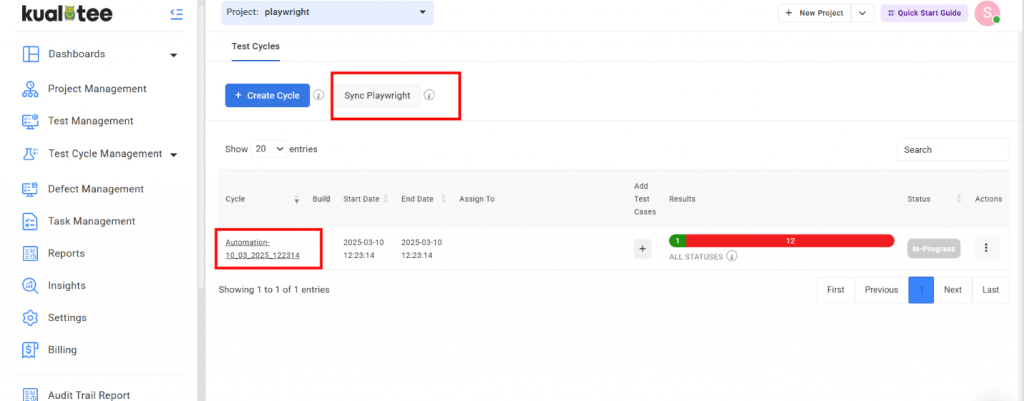
A cycle will be created with executed test cases
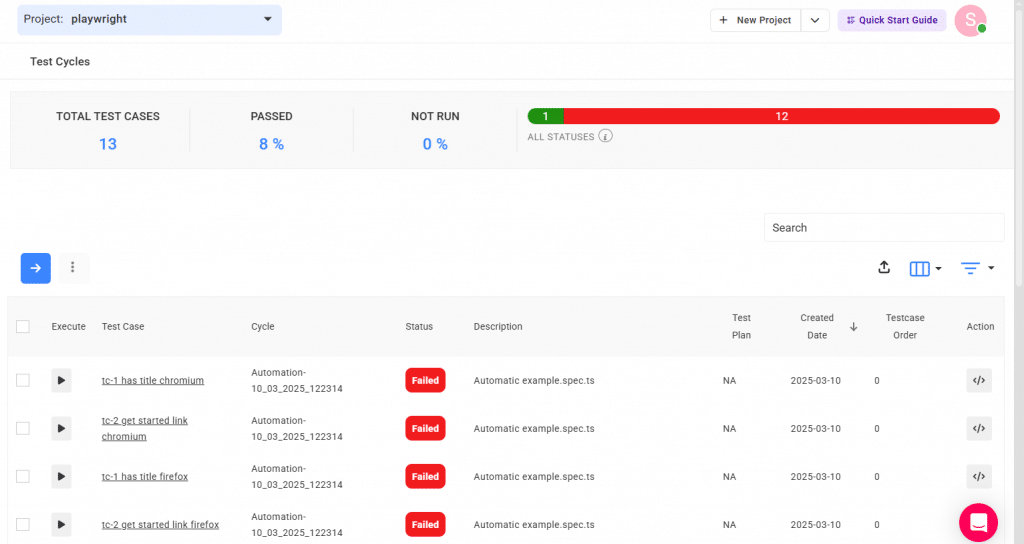
Monday.com
Monday.com is a versatile Work Operating System (Work OS) that empowers teams to build custom applications and workflows for managing everything from simple tasks to complex projects. It offers a highly visual and intuitive platform, making it accessible to users of all technical backgrounds. Key features include customizable boards for organizing work, automated workflows, collaboration tools, integrations with other applications, and robust dashboards and reporting. Kualitee integrates seamlessly with monday.com, bringing testing efforts directly into project workflows.
Key Features:
Effortlessly log and sync issues between Kualitee and monday.com, keeping all details aligned.Categorize items (requirements, defects, etc.) using monday.com columns, with consistent visibility in Kualitee. Gain a unified view of project progress and boost team collaboration.
Configurations:
With Kualitee-Monday, you will be able to sync Monday Defects, Sprints, Epics, Bugs Queue and Retrospectives, with Requirements and Defects on Kualitee.
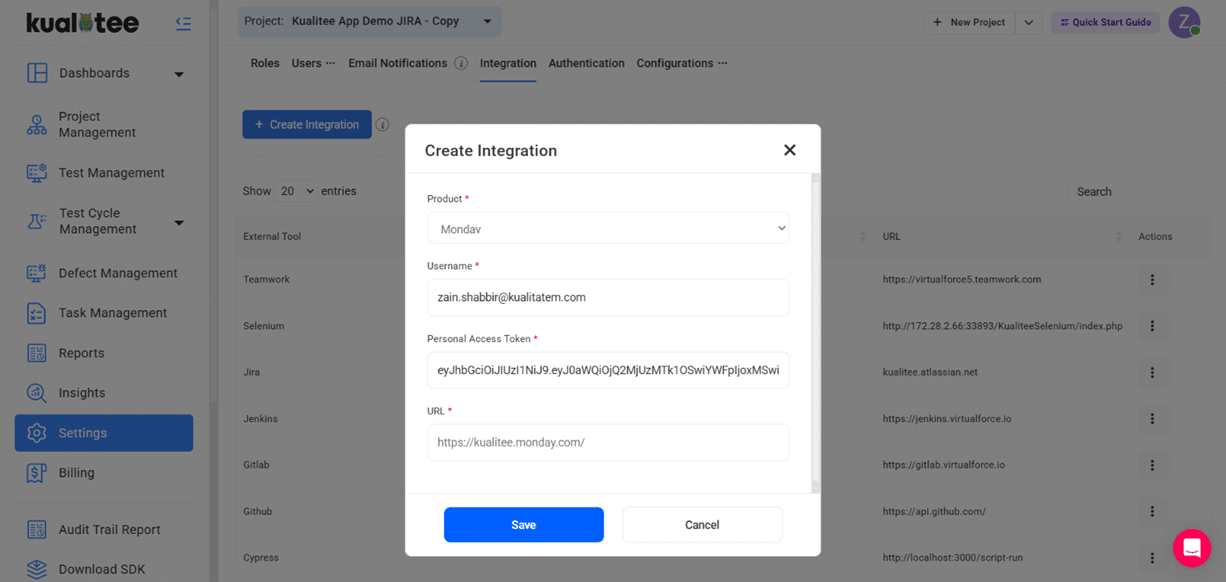
- To configure the two-way integration between Kualitee and Monday, you need admin access on the tools.
- Go to Settings and select Integration from the top bar.
- Go to ‘Create New’ in the external tool integration listing.
- Select Monday tool from the drop-down menu.
- Enter your Monday Email, Personal Access Token and Monday URL.
- Click ‘Save’ button to confirm a successful integration.
Asana
Kualitee has integrated itself with Asana. This exclusive two-way integration allows you to sync your tasks as requirements or issues between Kualitee and Asana. Each Asana project can be linked with a Kualitee project to sync all requirements and issues in both projects. Since it’s a two-way integration all updates made on the issue will automatically get synched that includes a change in status, additional comments, and association changed through Kualitee.
Creating Asana Integration
To integrate with Asana, you click on ‘create integration’ in settings and choose Asana from the product. Provide your exclusive access token generated from Asana to successfully create domain level integration.
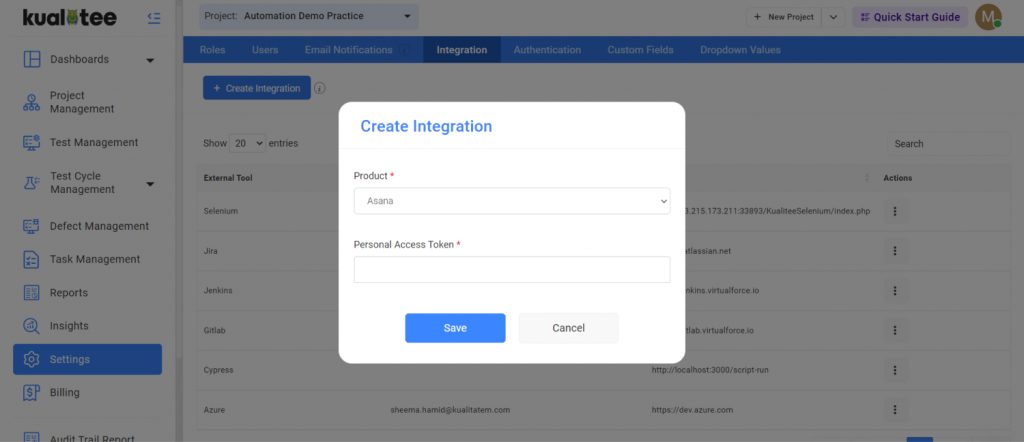
Once the integration is created, the next step is to map projects.
Under the Asana Projects, you will see the list of projects you have in your Asana instance. While in the Kualitee project you will see the list of projects you have on Kualitee.
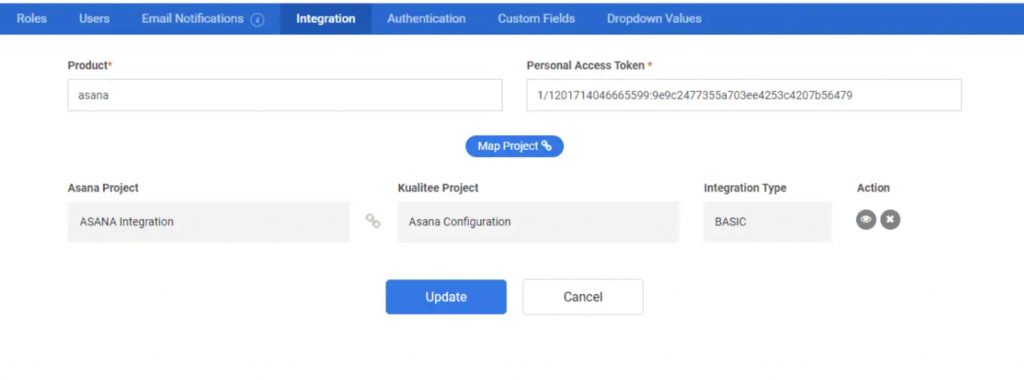
The basic mapping is a hard-coded field to field mapping between Kualitee and Asana. Below is a table that shows the mapping for each field.
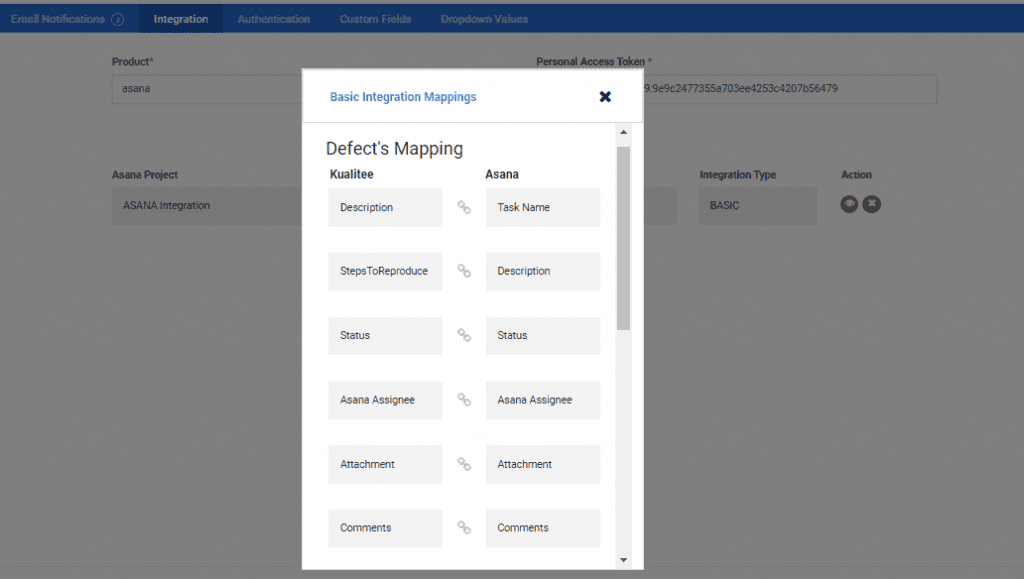
To send tasks as requirements or issues from Asana to Kualitee, you simply add a tag of “Requirements” or “Bugs” against your tasks and it will automatically be synced in the respective module inside Kualitee. You can additionally assign these tasks or issues to your team in either tool.
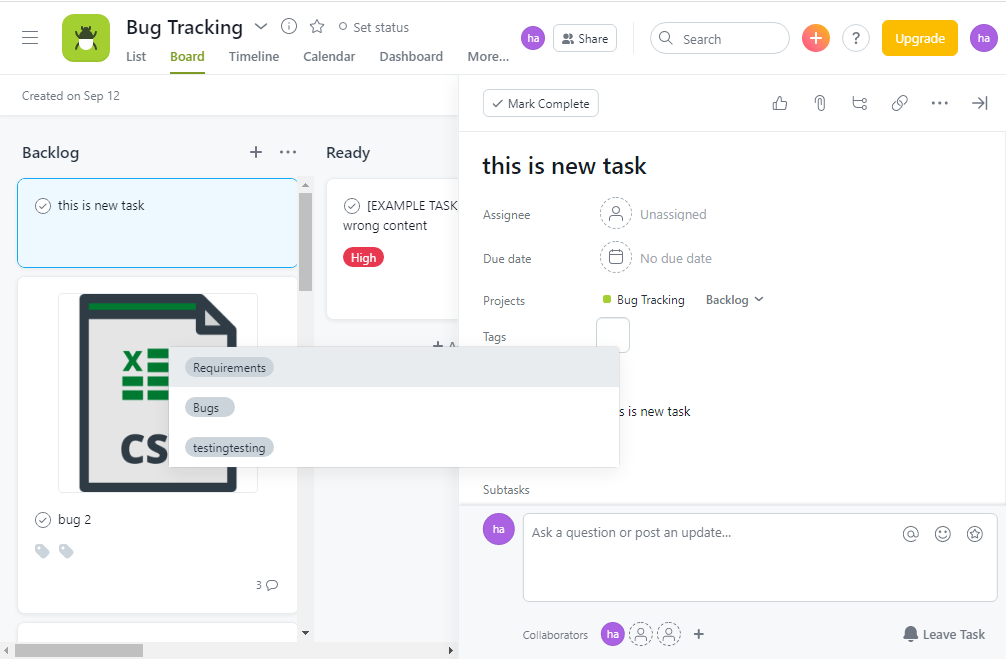
Azure DevOps
With Kualitee-Azure, you will be able to sync Requirements, issues, bugs, impediments both ways between the tools.
To configure the two-way Requirement integration between Kualitee and Azure, you need admin access on the tools.
Go to Settings and select Integration from the top bar
Go to ‘Create New’ in the external tool integration listing
Select Azure tool from the drop-down menu
Enter your Azure Email, Azure token and Azure URL
Click ‘Save’ button to confirm a successful integration.
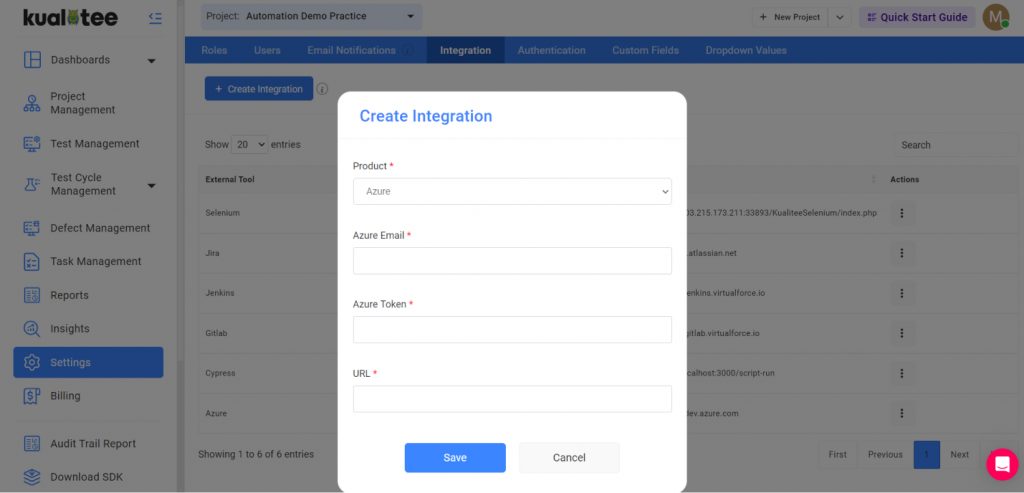
Once the integration is created, the next step is to map projects.
Under the Azure Projects, you will see the list of projects you have in Azure. While in the Kualitee project Go to Settings and Click on Edit button against azure integration Click on Map Project button
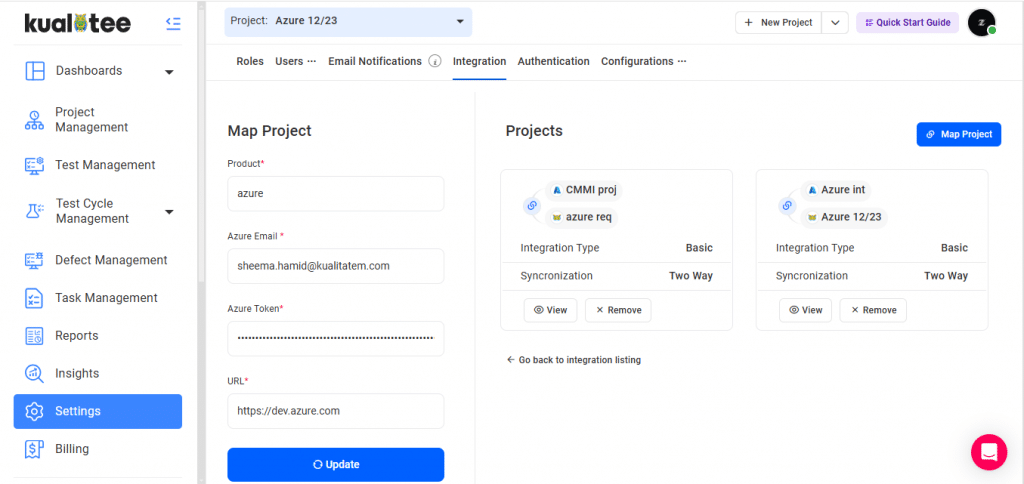
Select Integration Type, Azure Organizations, Azure project and Kualitee Project.
Click On Save button save the project mapping
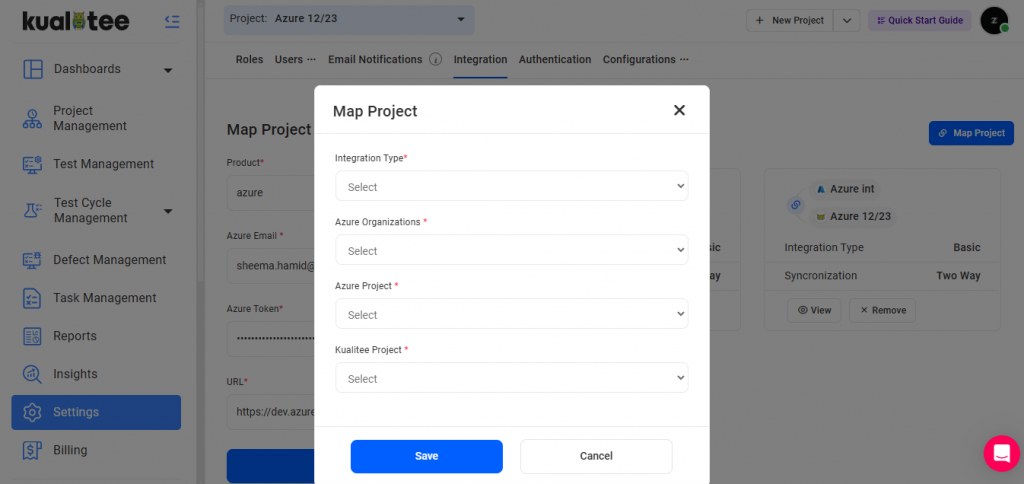
The basic mapping is a hard-coded field to field mapping between Kualitee and Azure. Below is a table that shows the mapping for each field.
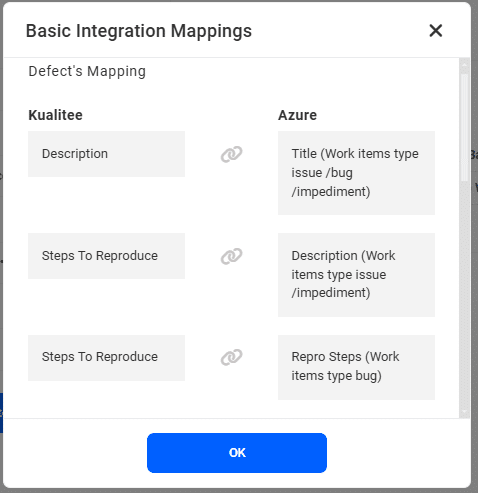
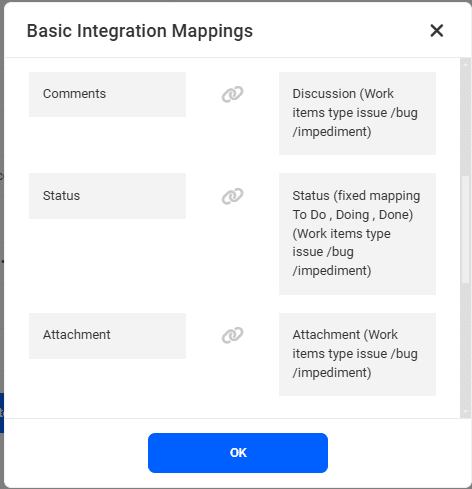
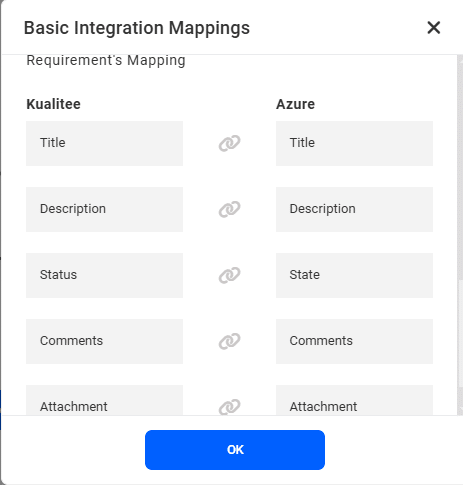
To sync requirements from Azure, go to Kualitee’s requirement screen and click on sync button and to sync issues/bugs go to defect screen and click on sync integration button

Azure token generation steps:
Navigate to Azure User settings
Click on Personal Access token
Click on +New token Enter token name
Select All accessible organizations from Organization dropdown
Select Token Expiration Dates
For Scope Select custom defined and select all check boxes manually
Click on Create
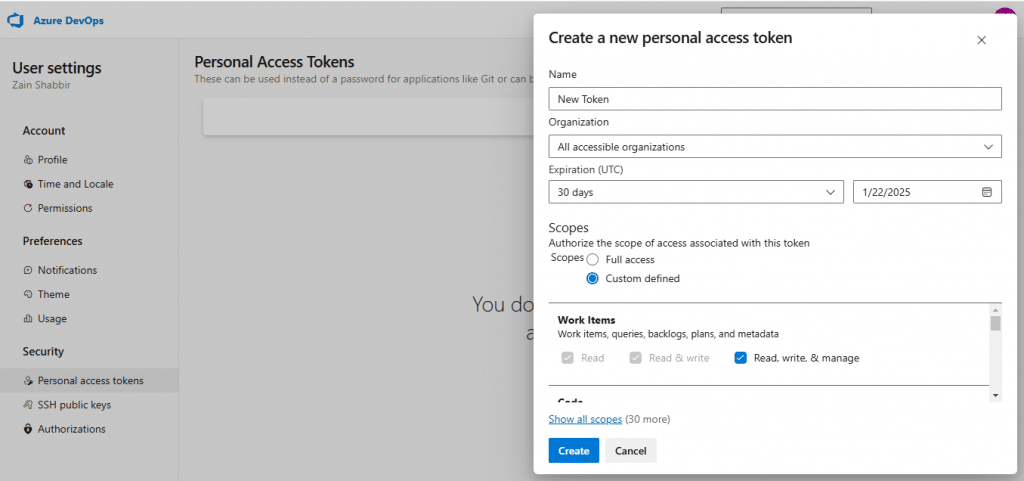
Bitbucket
Bitbucket is a Git-based code and CI/CD tool optimized for testing teams. The Kualitee-Bitbucket two-way integration allows you to sync your issues between both tools. Each Bitbucket repository can be linked with a Kualitee project to sync all the reported issues that exist in both platforms.
Create Integration
To configure the two-way integration between Kualitee and Bitbucket, you need admin access on the tools. The integration is basic, with hard-coded field to field mapping.
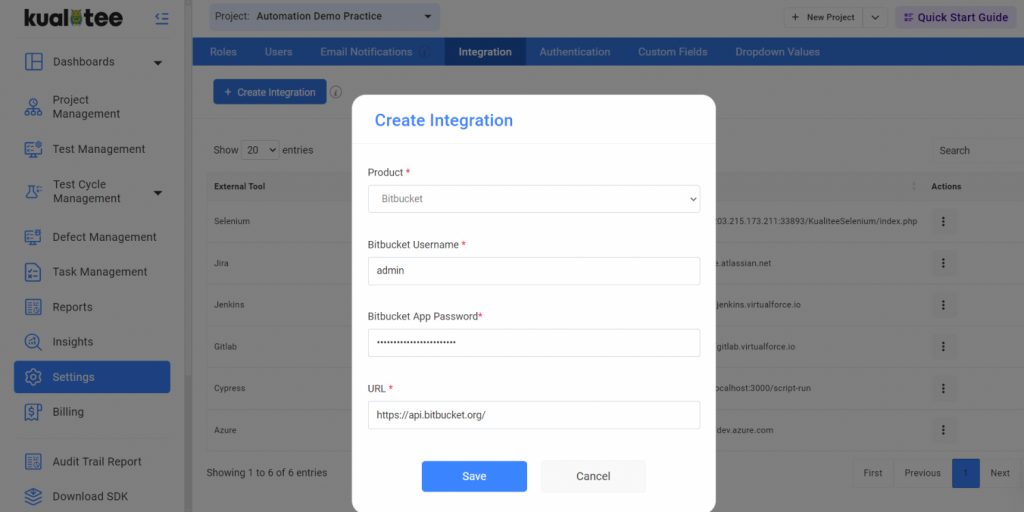
To integrate Kualitee with Bitbucket, you have to do the following:
To Configure:
- Go to Settings and select Integration from the top bar
- Go to ‘Create New’ in the external tool integration listing
- Select Bitbucket tool from the drop-down menu
- Select Organization (workplace slug)
- Select Project Name (repo slug)
- Select Kualitee Projects
- Click ‘Save’
- Enter details of your Bitbucket account
Click ‘Save’ to confirm a successful integration and to start syncing builds. Go to ‘Edit Integration’ to map the Bitbucket task with Kualitee Project.
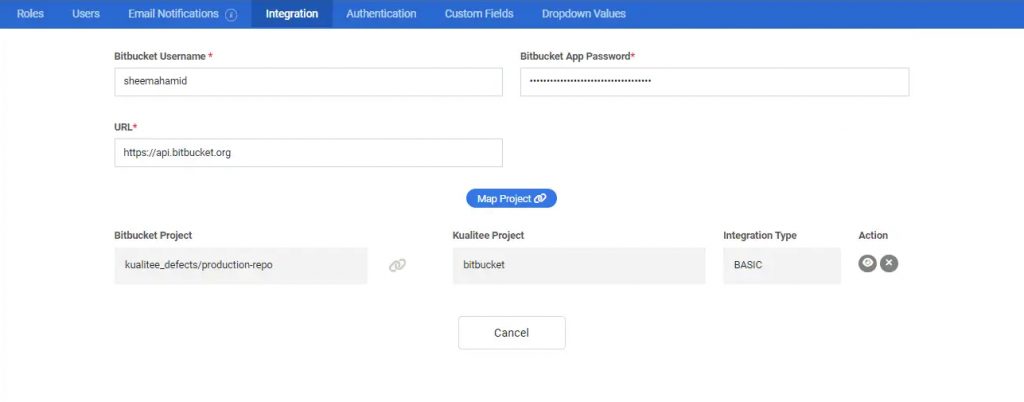
Map your projects with your Bitbucket tasks by selecting the information below.
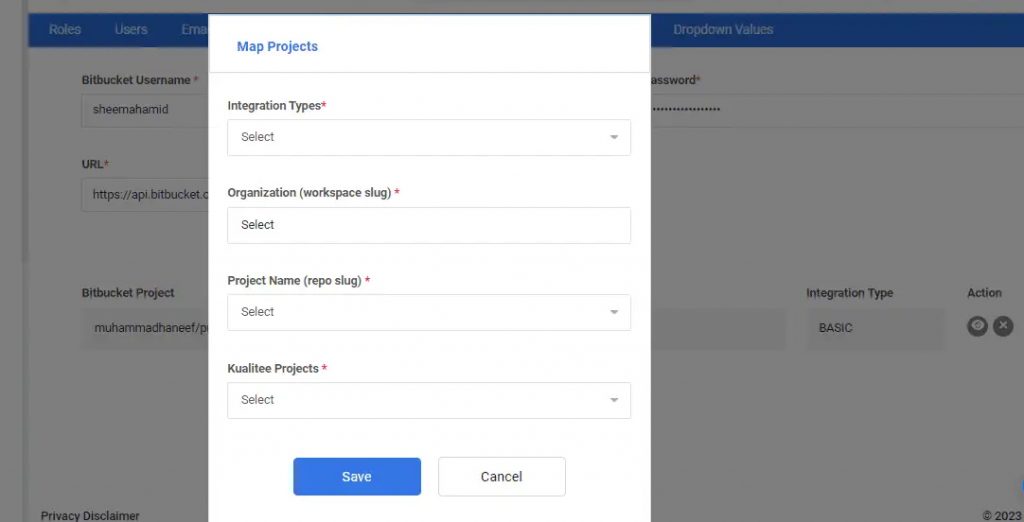
The basic mapping is a hard-coded field to field mapping between Kualitee and Bitbucket. Below is a table that shows the mapping for each field.
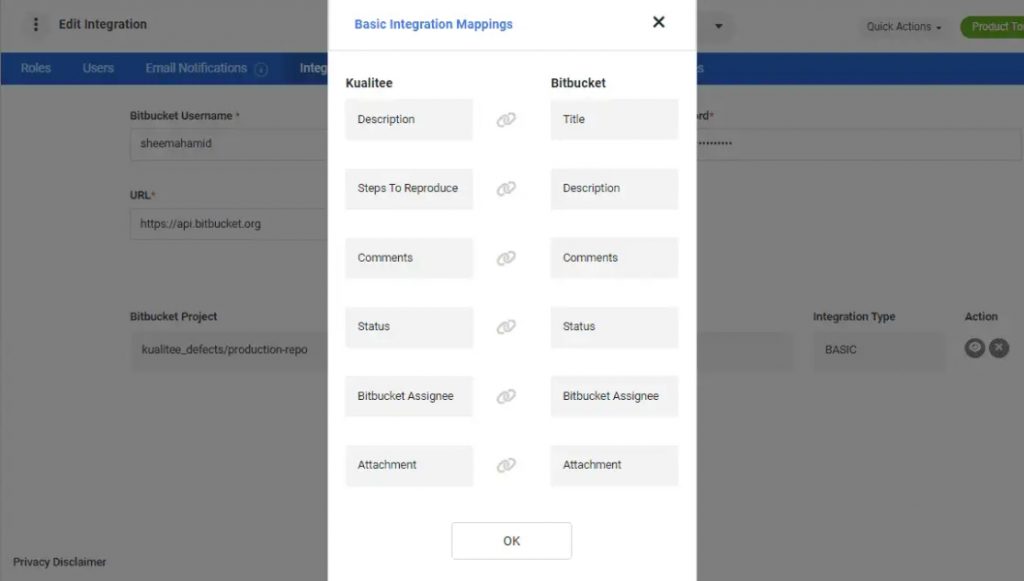
Circle CI
Circle CI is a CI/CD (Continuous Integration and Continuous Delivery) platform used for the purpose of implementing DevOps practices. Circle CI’s integration with Kualitee accelerates the continuous delivery processes and thus, speeds up the entire test management cycle.
Create Integration:
- Go to Settings and select Integration from the top bar
- Go to ‘Create New’ in the external tool integration listing
- Select Circle CI tool from the drop-down menu
- Enter details of your Cirlce CI account
- Enter Personal Access Token for Circle CI
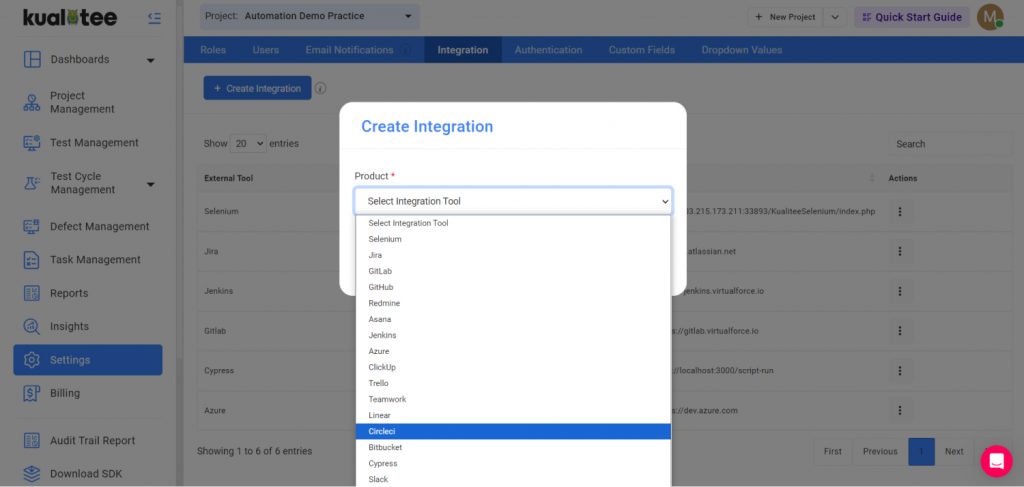
Enter details of your Circle CI account. Click save.
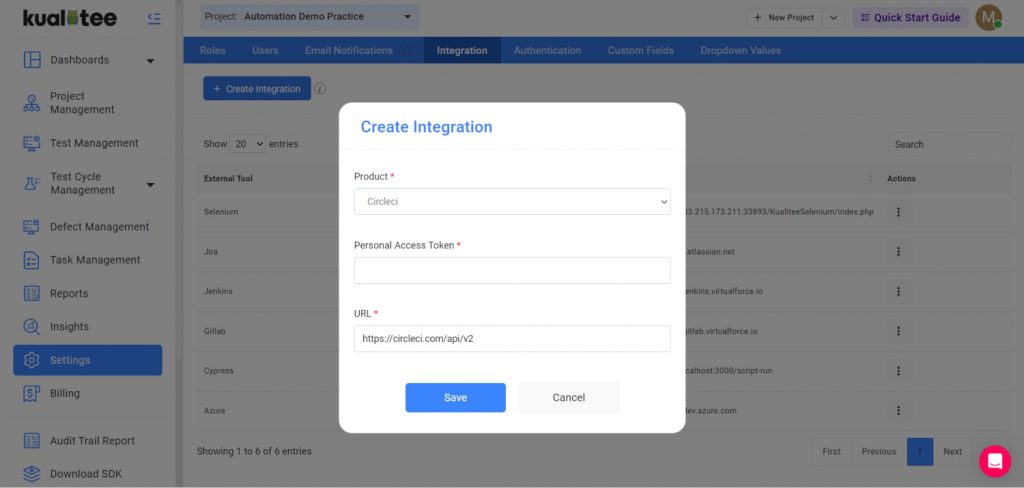
You can edit the integration as shown below.
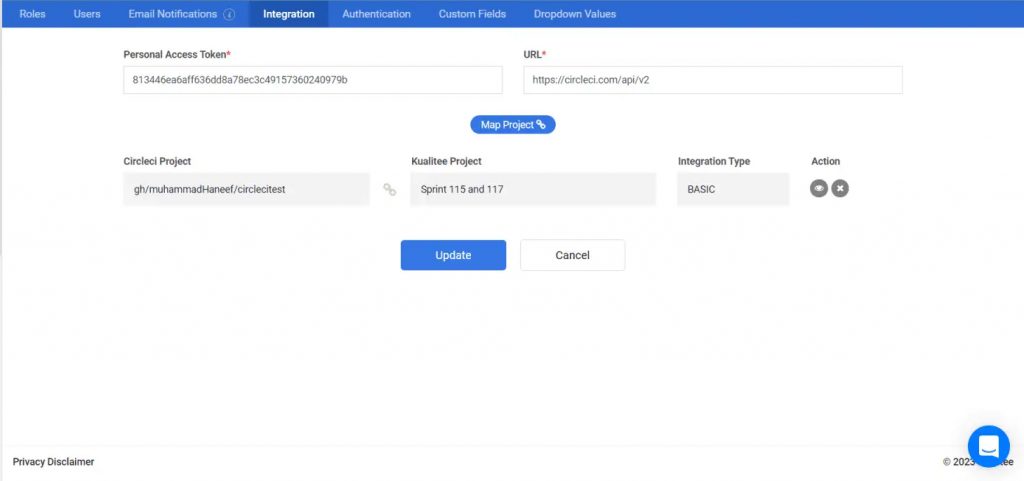
On this screen, you will also have the option to Map Projects. Fill in the information required and click save, for successful mapping.
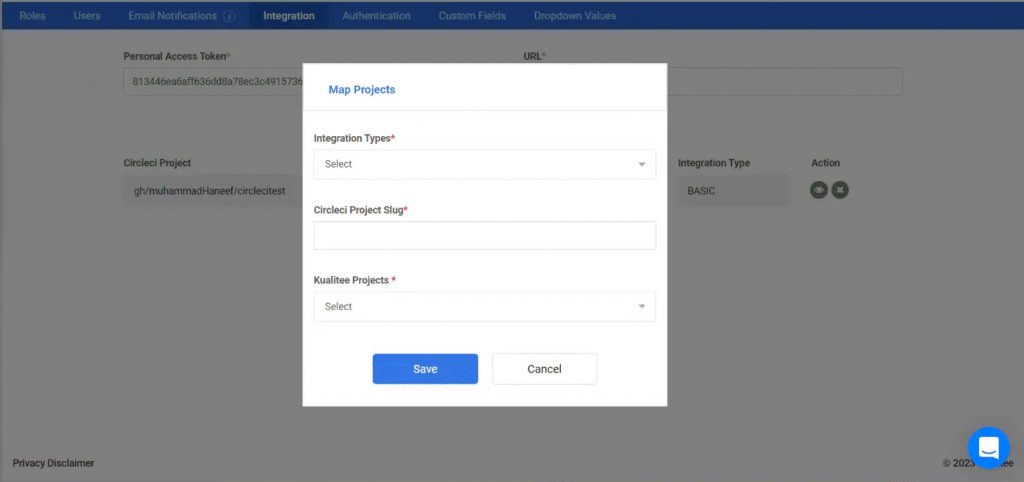
Go to Test Lab > Test Case execution, select your project and the cycle you want to import the test cases from Circle CI with execution results. Click import.
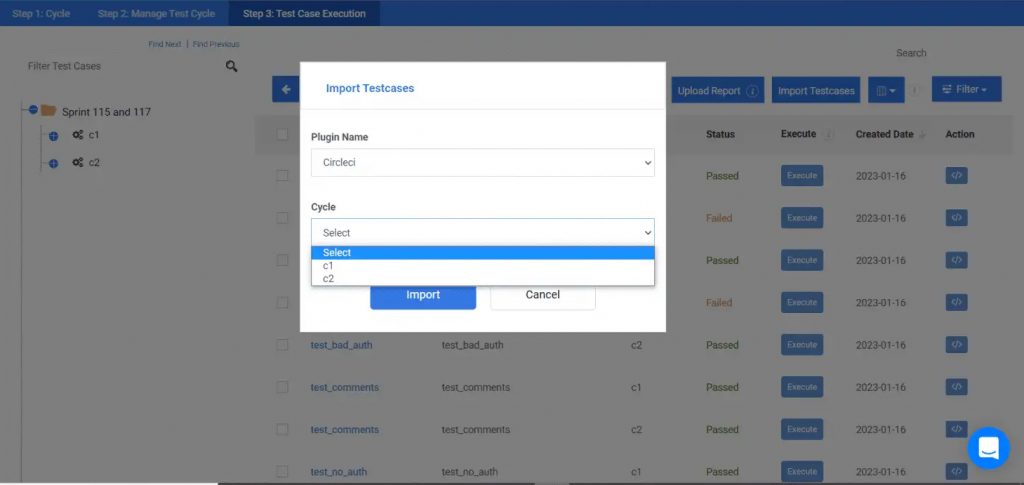
ClickUp
ClickUp is a cloud-based collaboration and project management tool that caters to businesses of all sizes and industries. Kualitee’s integration with ClickUp allows you to sync tasks through its two-way exclusive integration. You can link multiple ClickUp Lists with Kualitee; you will be able to create tasks on ClickUp and view them as defects in Kualitee, without having to switch applications for assignment or tracking.
Create Integration:
To configure the two-way integration between Kualitee and ClickUp, you need admin access on the tools. The integration is basic, with hard-coded field to field mapping.
- Go to Settings and select Integration from the top bar
- Go to ‘Create New’ in the external tool integration listing
- Select ClickUp tool from the drop-down menu
- Enter the Personal Access Token and URL of your ClickUp account
The following statuses need to be created in Click Up in order for the integration to work correctly:
1) Closed
2) In progress
3) To do
The same statuses need to be selected while creating a defect from Kualitee or changing status from Click Up.
Click ‘Save’ button to confirm a successful integration and to start syncing tasks from ClickUp to Kualitee as Defects
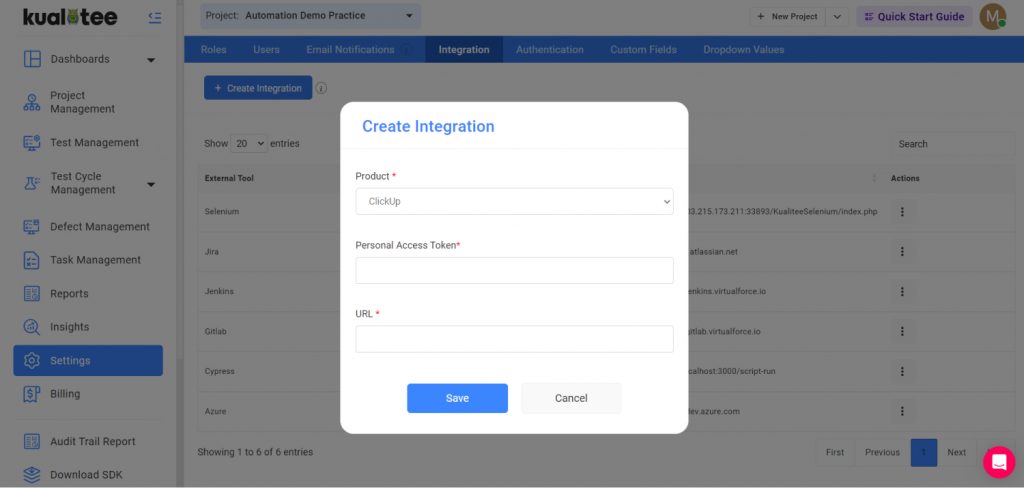
Go to ‘Edit Integration’ to map the ClickUp lists with Kualitee Projects.
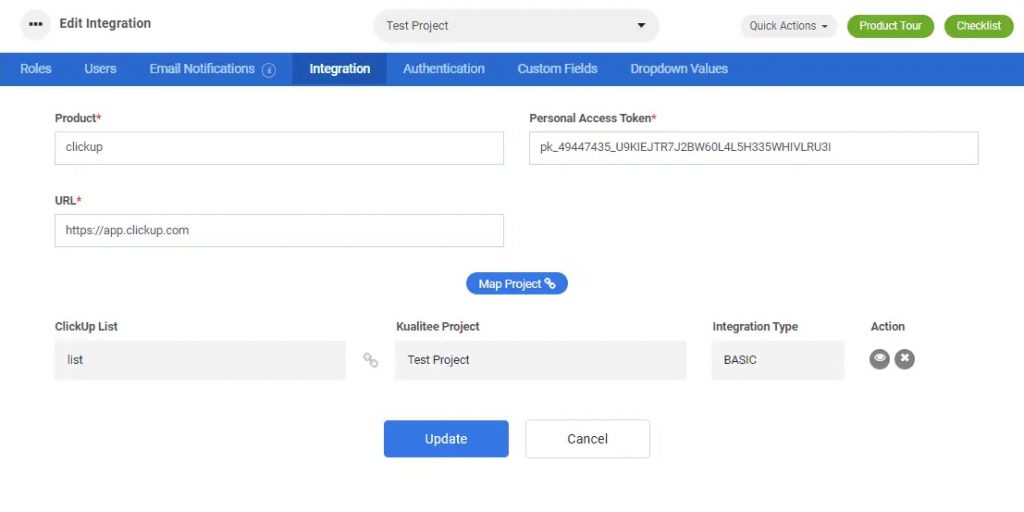
Map your projects with ClickUp lists by selecting the information below.
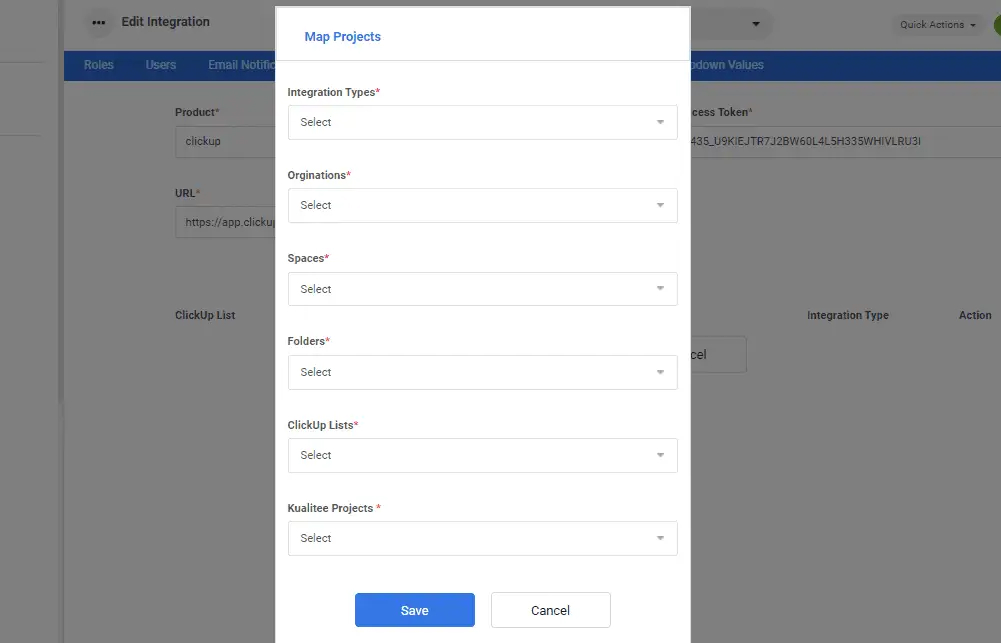
The basic mapping is a hard-coded field to field mapping between Kualitee and ClickUp. Below is a table that shows the mapping for each field.
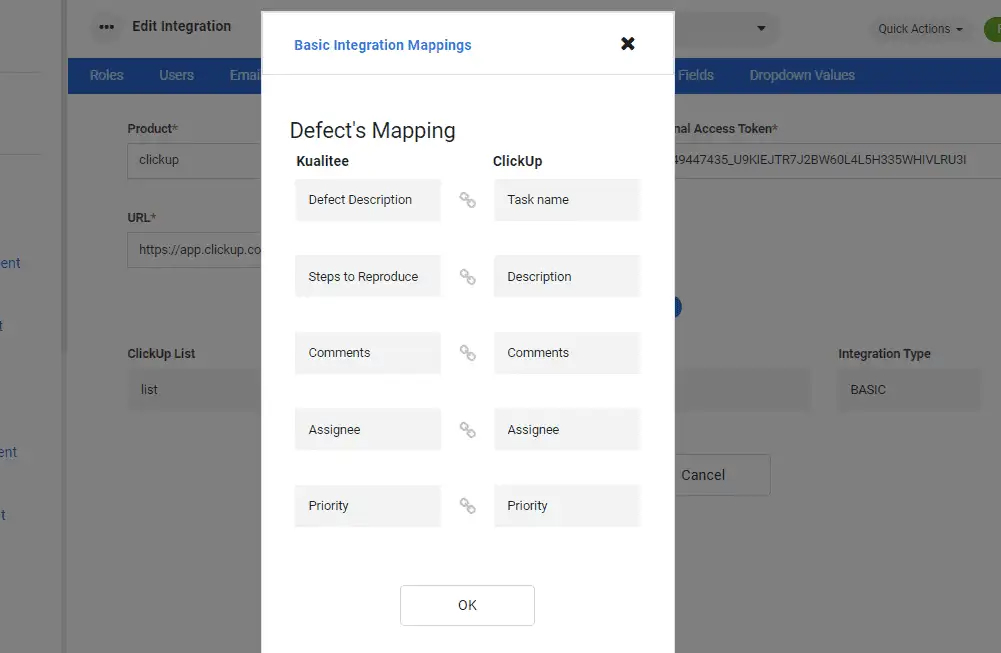
GitHub
GitHub is a widely used development platform. The Kualitee-GitHub two-way integration allows you to sync your issues between both tools. Each GitHub project can be linked with a Kualitee project to sync all the reported issues that exist in both projects. Since it’s a two-way integration, all updates that are made on the issue will automatically get synced, including a change in status, additional comments, and associations changed through Kualitee.
Create Integration
To configure the two-way integration between Kualitee and GitHub, you need admin access on the tools. The integration is basic, with hard-coded field to field mapping.
- Go to Settings and select Integration from the top bar
- Go to ‘Create New’ in the external tool integration listing
- Select GitHub tool from the drop-down menu
- Enter the Personal Access Token of your GitHub account
Click ‘Save’ button to confirm a successful integration and to start syncing issues.
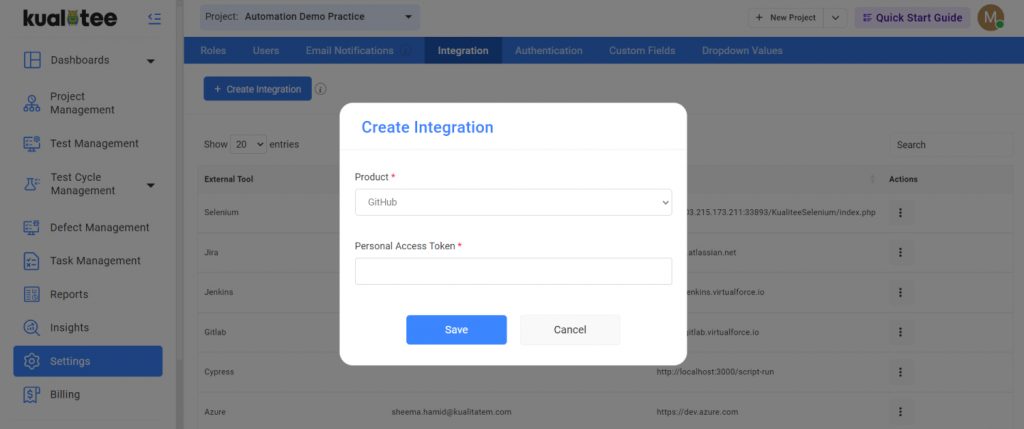
You can also edit the integration, as shown below.
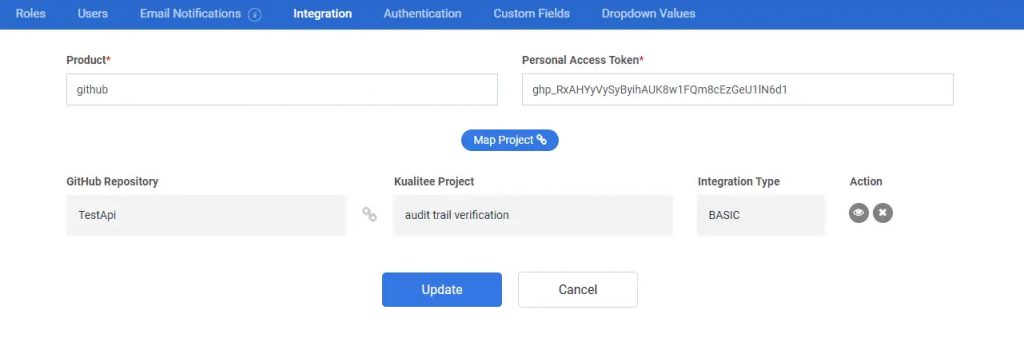
The basic mapping is a hard-coded field to field mapping between Kualitee and GitHub. Below is a table that shows the mapping for each field.
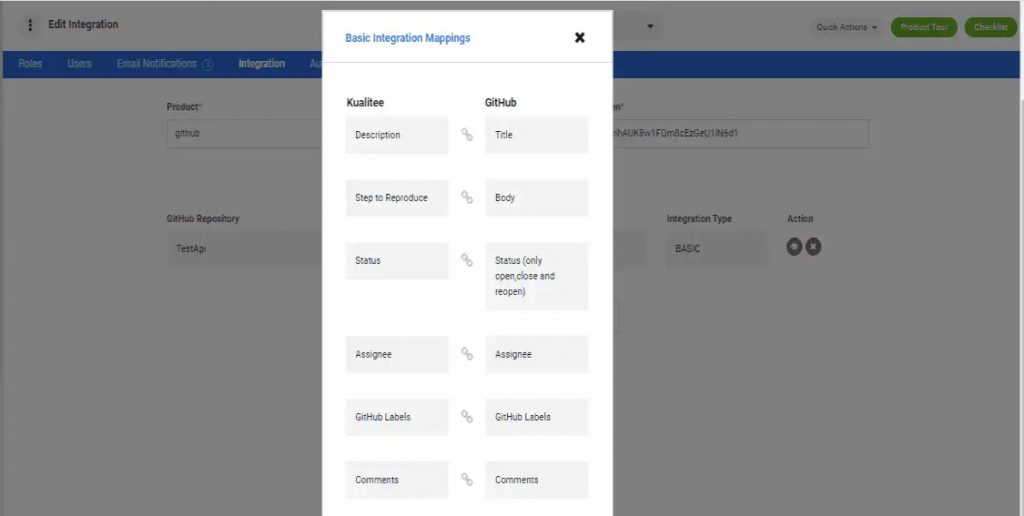
GitHub token generation steps:
Navigate to: https://github.com/settings/tokens
Click on generate new token (Classic)
Enter token name or any information in the “note” field
Set the expiry date of token
Select the scope of token as shown in below image, and click on ‘generate token’ button
To integrate on Kualitee:
Go to Kualitee -> Settings -> Integrations
Click on ‘Create Integration’
Select GitHub as tool from the drop down menu
Copy the token in Personal Access token field
Click on the ‘edit’ icon and navigate to the Project Mapping screen
Click on ‘Map Project’ button
Select the integration type as ‘basic’
Select the organization that you want to map (if you want to map repository integrated from organization)
Select GitHub repository
Select labels (If you select the labels only, the labeled defects will be pulled from GitHub)
Select the Kualitee project with which you want to map
Click on the ‘Save’ button to save the integration
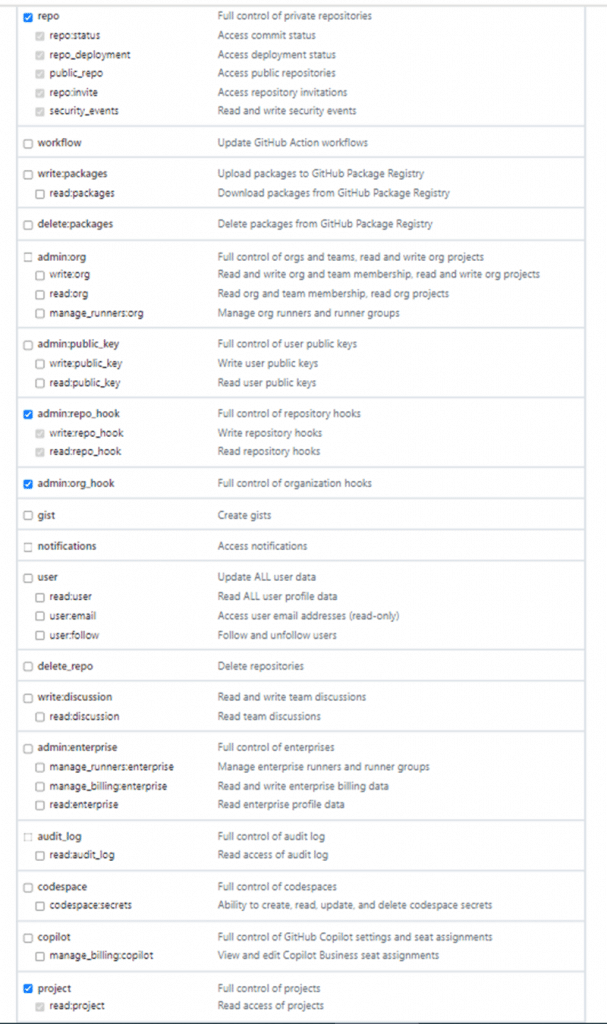
GitLab
Kualitee has integrated with GitLab issues and branches. This exclusive two-way integration allows you to sync your issues between Kualitee and Gitlab. Each GitLab project can be linked with a Kualitee project to sync all reported issues in both projects. Since it is a two-way integration, all updates made on the issue will automatically get synced; this includes a change in status, additional comments and association changed through Kualitee. Along with issues, you can also integrate Gitlab branches with Kualitee builds to run Pipelines within Kualitee.
Creating GitLab Integration
To integrate with GitLab, you click on ‘create integration’ in settings and choose GitLab from the product. Provide your personal access token and domain URL to successfully create domain level integration.
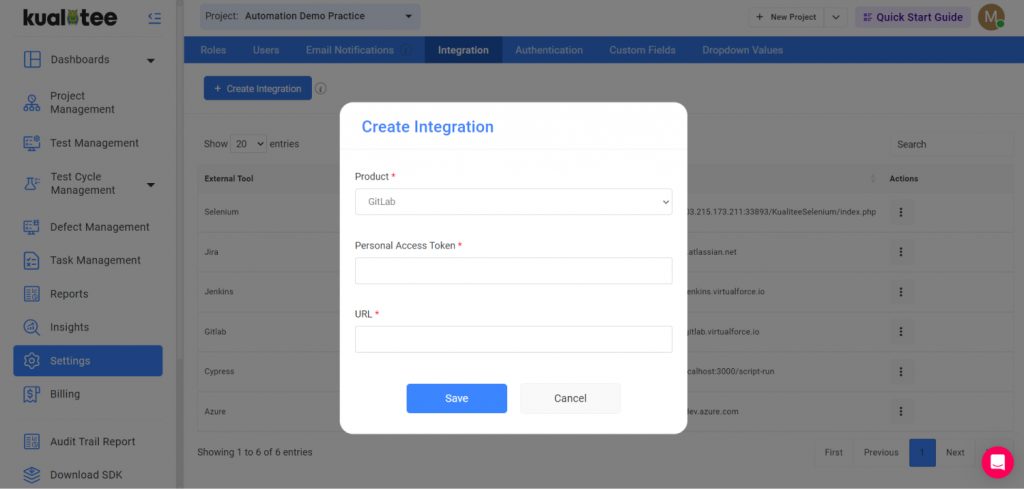
Once the integration is created, the next step is to map projects.
Under the GitLab Projects, you will see the list of projects you have in GitLab. While in the Kualitee project you will see the list of projects you have on Kualitee.

The basic mapping is a hard-coded field to field mapping between Kualitee and GitLab. Below is a table that shows the mapping for each field.
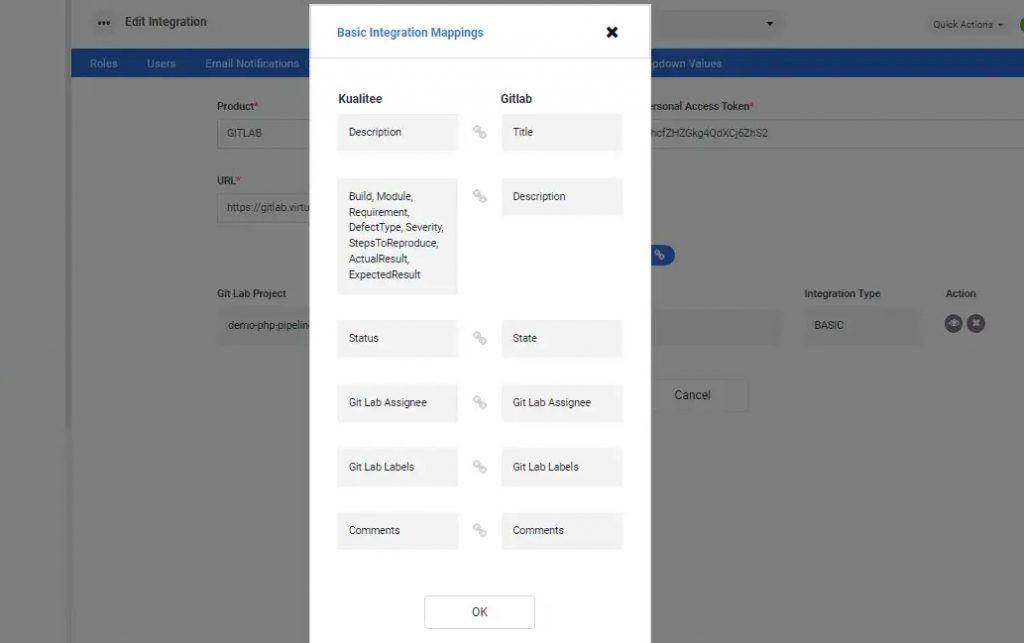
Users in GitLab can also follow the template below to provide additional information for the fields available in Kualitee.
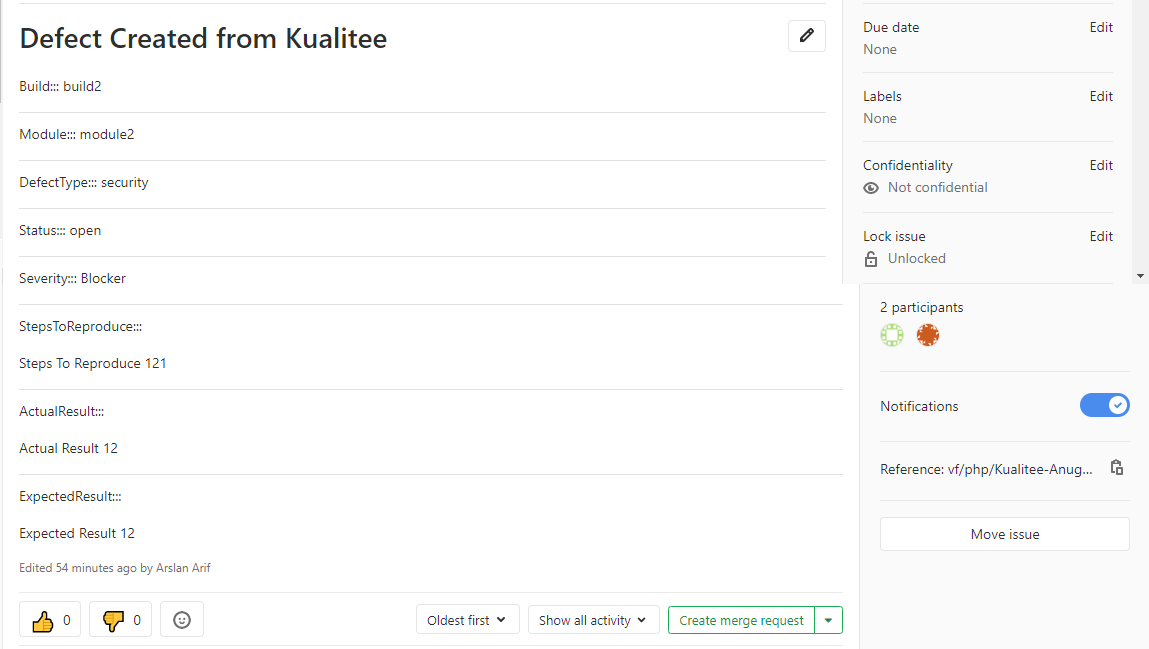
To integrate Kualitee Builds with Gitlab Branches, follow these steps:
- Go to ‘Project Management’
- Click on ‘Builds’ from the top menu
- Hover over the Build you want to map with GitLab branch and click on the Link icon
- Select the branch you want to map with selected Build
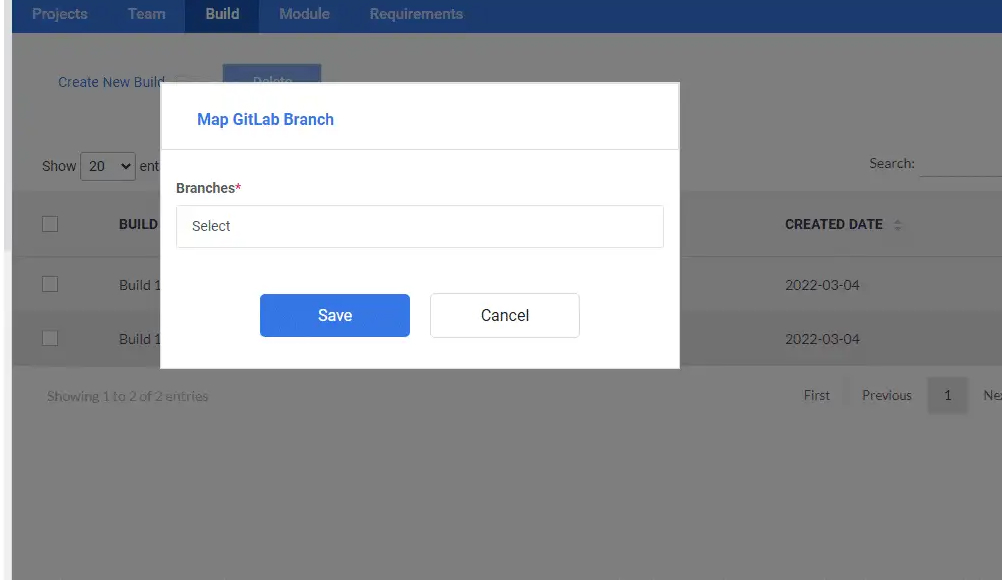
- After mapping Branch, click on the List icon to see the Pipelines of that branch
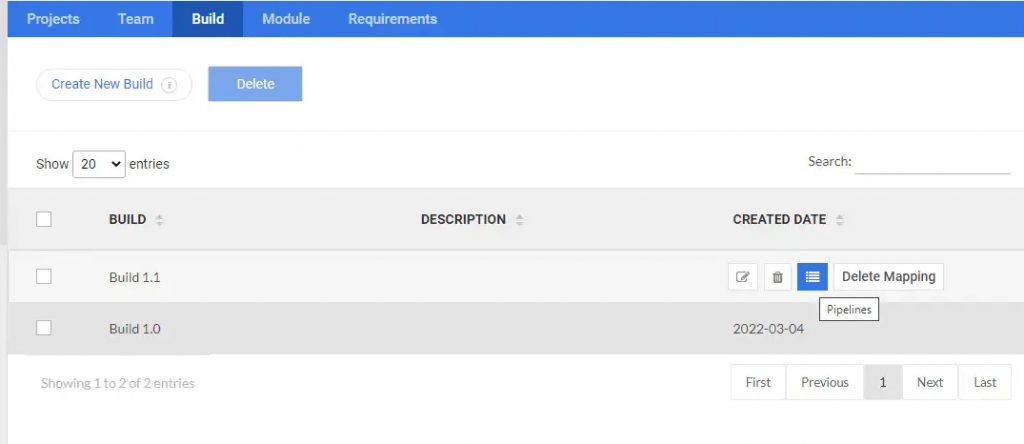
- From the Pipelines pop-up, you can create a new pipeline from ‘Create Pipeline’. You can also refresh the existing pipeline by clicking on ‘Refresh’, and be able to view its name, status, date etc.
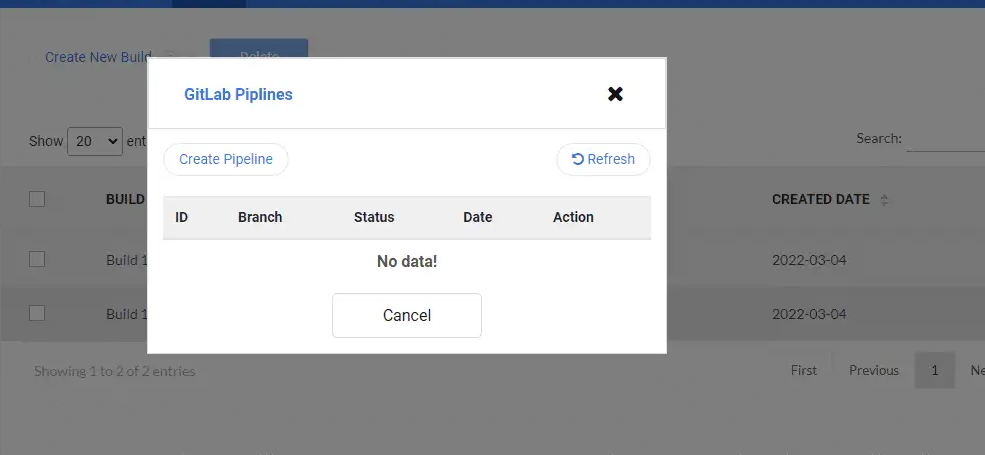
JIRA
Kualitee integrates with one of the most popular testing tools, JIRA. This integration allows you to stay connected with the development team while doing your planning in Kualitee, and sending checked and tested feature information back to your development team. The integration allows both tools to send and receive real time updates as they happen.
For example, if updates are made to certain features and requirements in Kualitee with “Sync Integration tool” those changes are automatically made in JIRA and vice versa. However, certain items and detail components are mapped so that if the product or development team split the progress into several different statuses the other team can monitor and remain updated with the progress.
Kualitee offers both one-way (i.e. Kualitee to Jira) and two-way integration with Jira. This way, you’ll be able to pick the integration method according to your project requirements.
Creating JIRA Integration
To create the JIRA integration, you click on create integration and choose JIRA from the product. Provide your JIRA admin email and API token with domain URL to successfully create domain level integration.
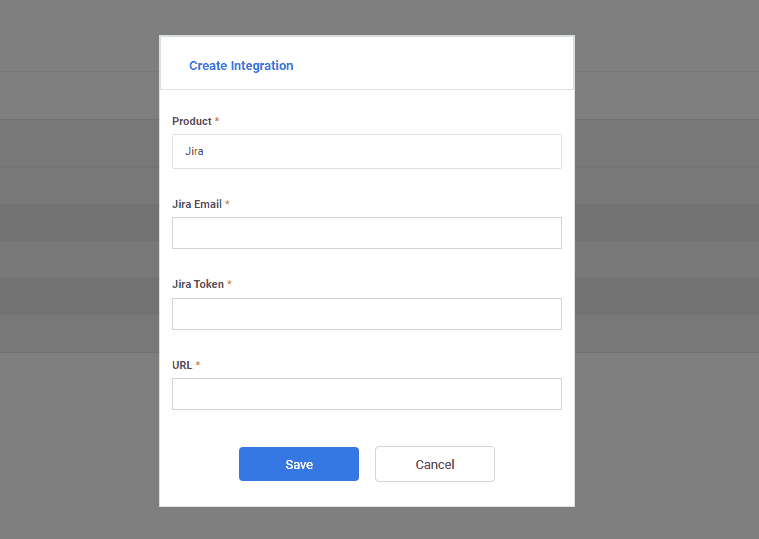
Once the integration is created, next step is to map projects.
Under the JIRA project, you will see the list of projects you have in JIRA. While, in the Kualitee project you will see the list of projects you have on Kualitee.
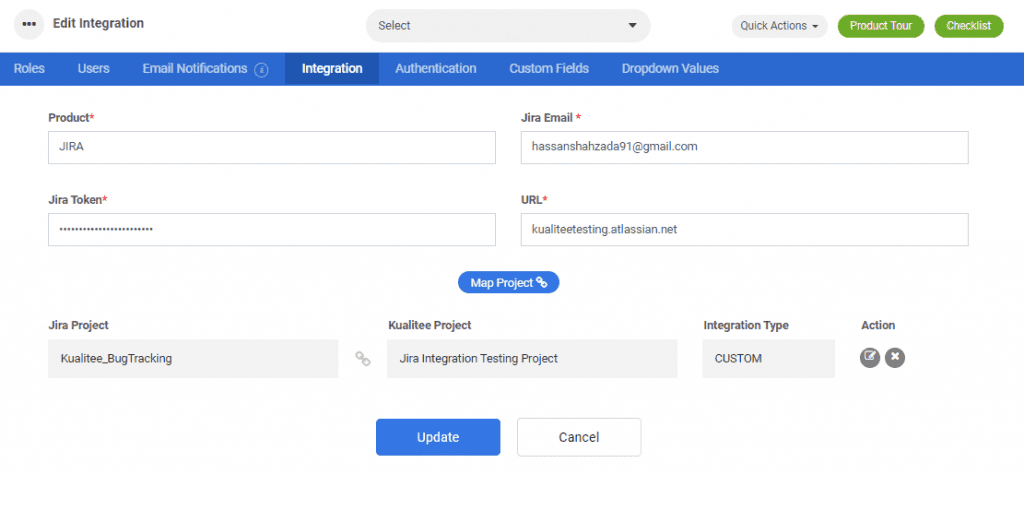
You also have the option to choose whether to integrate JIRA Stories with Kualitee Requirements or JIRA Defects with Kualitee Defects, or both.
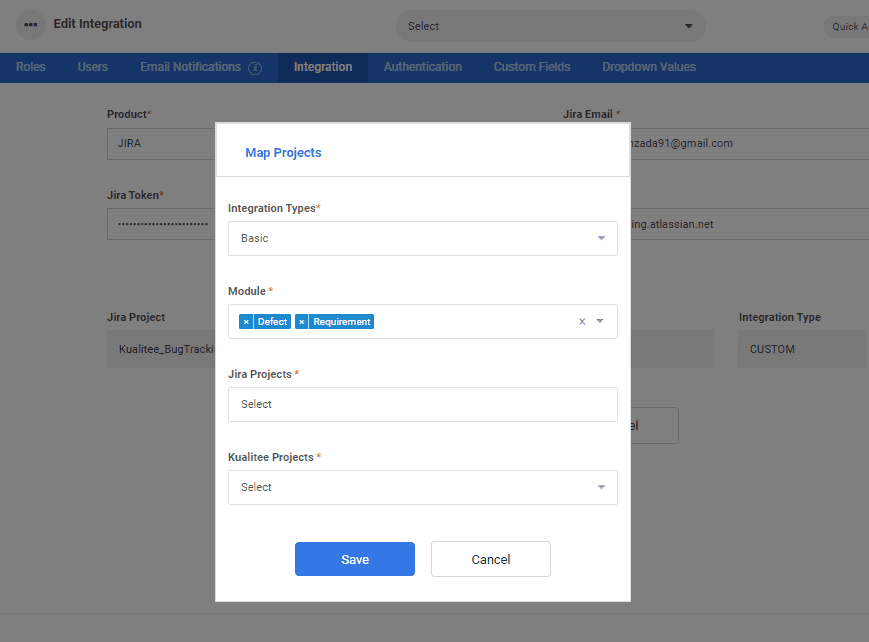
Basic Mapping
Basic Mapping with JIRA is hard-coded field to field mapping as mentioned in the table below.
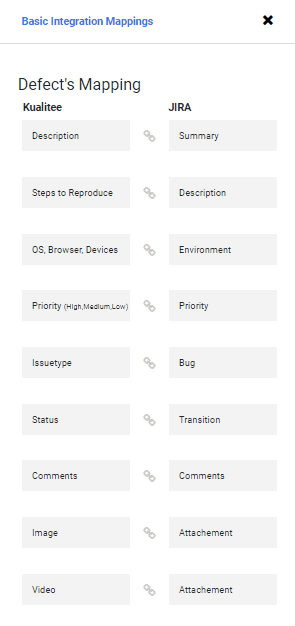
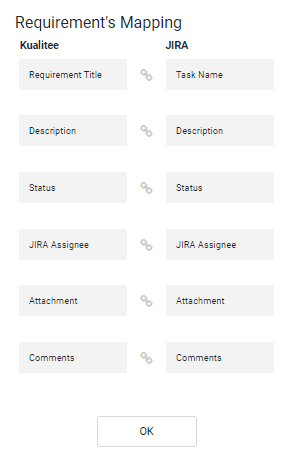
Module Wise Requirement
There is integration available for two modules; one for defect and one for requirements. Defect will get synced in Jira as issue. Requirement will get synced as user story, feature improvement or sub task. While creating requirement, you need to select issue type; the requirement will be created in Jira according to selected issue type as in Jira.


Following is the mapping of defect status in Kualitee with bug status in JIRA.

Mapping of priorities is:

- JIRA “Environment” which includes information regarding Browsers/Devices will appear under “Step to Reproduce” in Kualitee.
- Once, Sync integration function is active all the changes e.g. new defects created, updated and deleted will be reflected on either sides.
- Only issues which are classified as bug in JIRA will appear in Kualitee. Issues modified as story, task or epic in JIRA will not appear in Kualitee.
- Changing project name, project type or Re-Indexing the project will affect the integration.
Custom Mapping
Custom Mapping allows you to customize your synchronization with JIRA. You will need to create similar kualitee fields inside JIRA and drop down values so field to field mapping can take place upon sync.

Before you start mapping, make sure that you have completed the following steps:
- Created Custom Fields in JIRA for each field you are trying to map.
- Confirm the Field Type as mentioned in the table below
- Any Custom Value that you have created in Kualitee, is created in JIRA
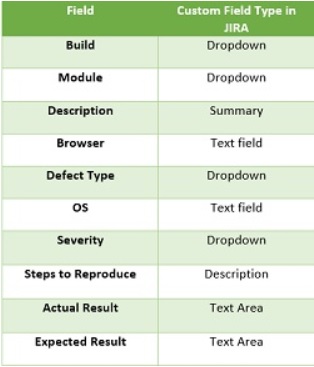
Do not forget to add the below mentioned(Priority and Environment) fields while integrating defects:
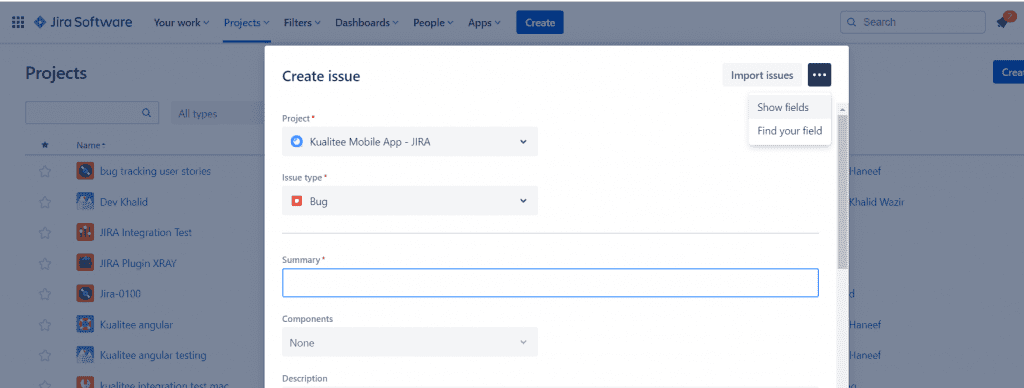
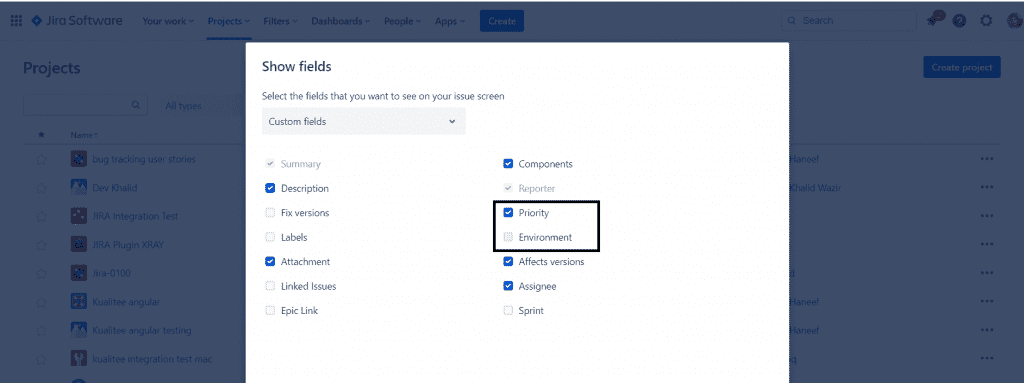
*Note:
1- Till Mapping is not configured basic JIRA Integration will be working
2- This configuration will not affect previous issues. It will only work with Issues created from this point onwards.
3- Build & Module created in JIRA will be created in Kualitee but will not have association with test scenarios and cases etc. To do that you will need to manually edit scenarios and cases or create build and module in Kualitee to maintain the association.
4- Any custom value created in JIRA will automatically be created once synced with Kualitee but any Custom value added in Kualitee will not be available inside JIRA. It will need to be created.
5- In case of Integration fail, make sure that field type and value you are mapping is available in JIRA.
Jenkins
Jenkins is an open-source CI/CD tool that helps deliver apps faster by introducing automation at different software development stages. It enables developers to continuously integrate changes into the build. Jenkins’ integration with Kualitee speeds up the continuous delivery processes and consequently, the entire test management cycle. You wouldn’t have to juggle different windows, and can get updated on everything in Kualitee.
Create Integration:
To integrate Kualitee with Jenkins, you have to configure the Jenkins server such that it allows you to sync the Jenkins’ builds from within Kualitee.
- Go to Settings and select Integration from the top bar
- Go to ‘Create New’ in the external tool integration listing
- Select Jenkins tool from the drop-down menu
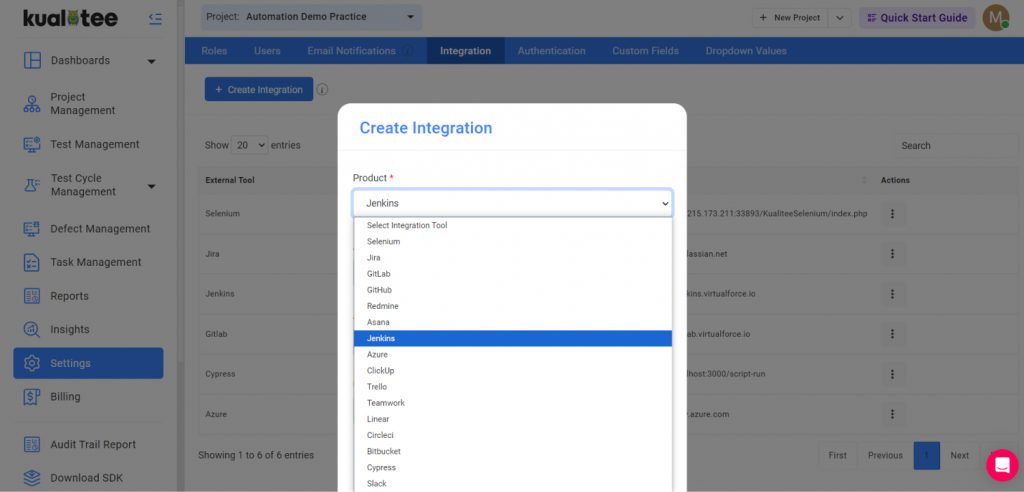
- Enter details of your Jenkins account
Click ‘Save’ to confirm a successful integration and to start syncing builds.
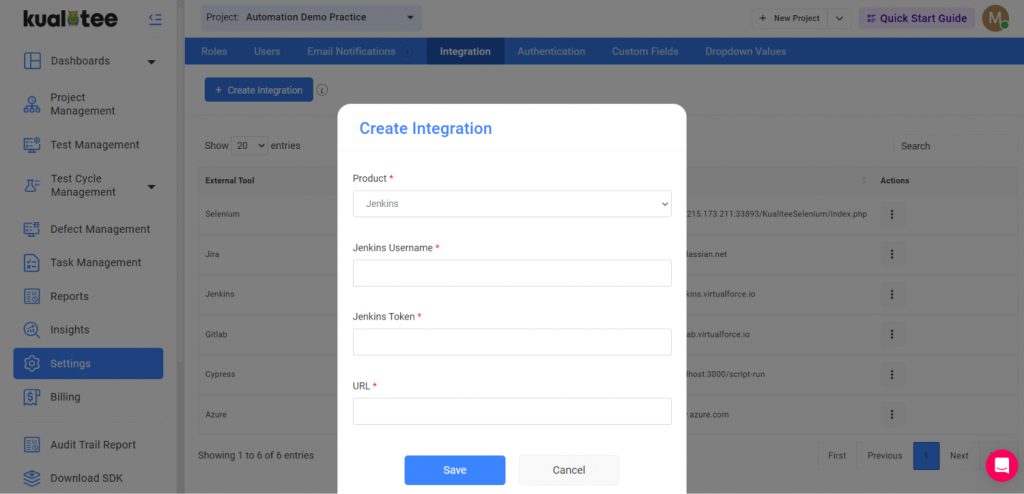
Once the integration is created, the next step is to map projects.
Under the Jenkins Builds, you will see the list of projects you have in Jenkins. While under Kualitee Project, you will see the list of projects you have on Kualitee.
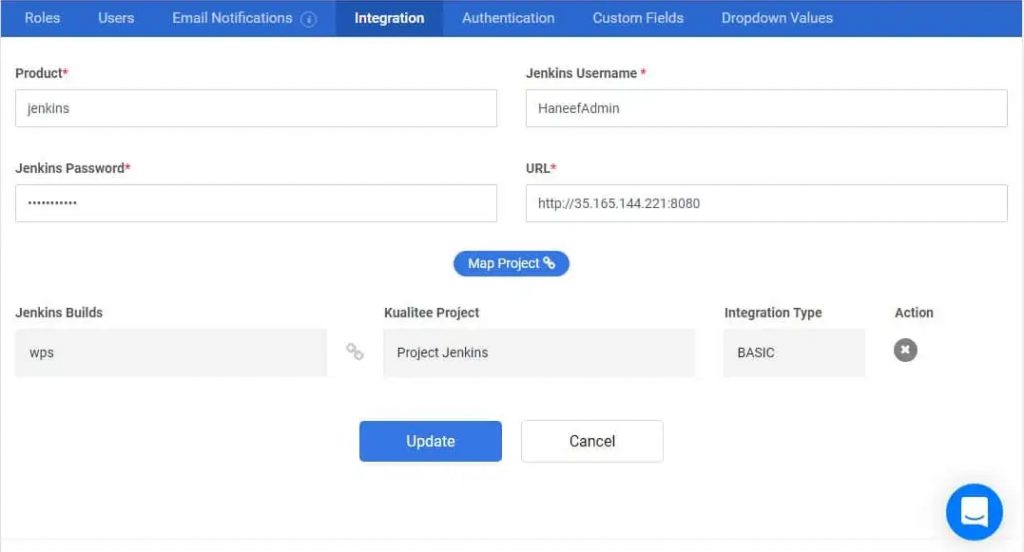
Map your projects with Jenkins Builds by selecting the information below.
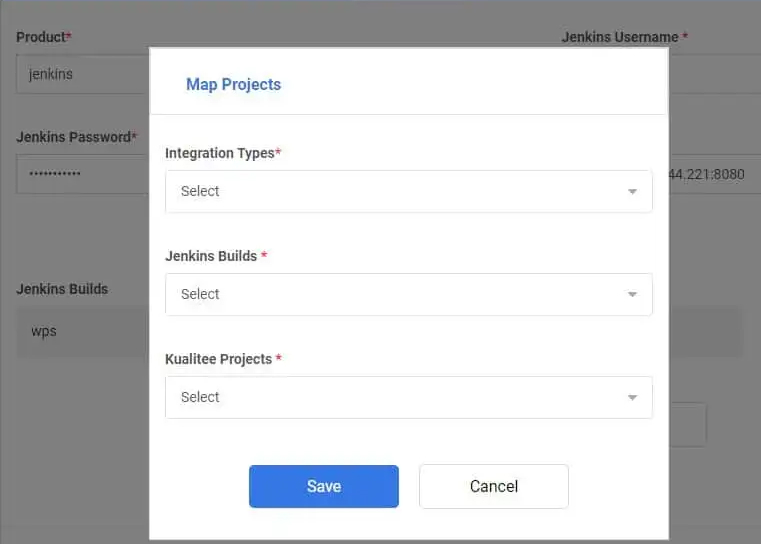
After creating integration and mapping the builds follow these steps to check Jenkins’ jobs and their statuses:
- Go to ‘Project Management’
- Go to ‘Build’
- Click on ‘Jenkins Job’ button
- A pop up will appear on which you can check the status of Jenkins jobs or refresh them. You can also create a new job by clicking ‘Create Job’.
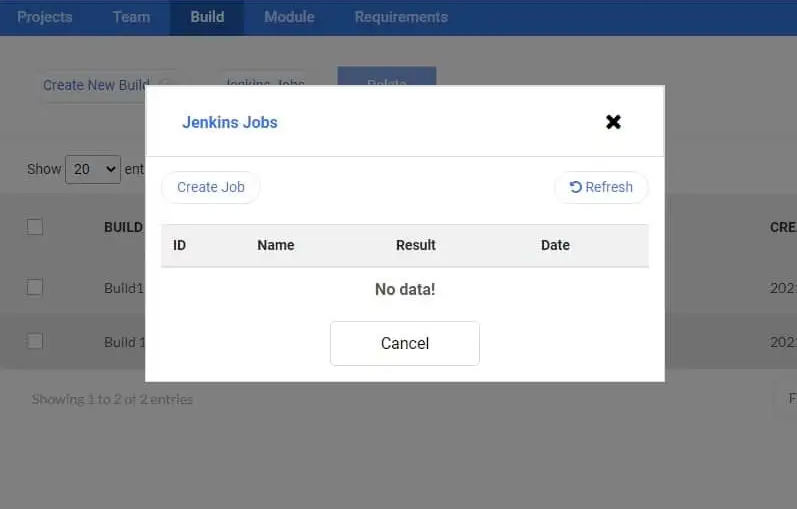
Linear
Linear is an issue tracking tool that helps streamline software projects, sprints, tasks, and bug tracking. Kualitee’s integration with Linear lets you sync Linear tasks with Kualitee issues through its two-way exclusive integration. You can link multiple Linear projects with Kualitee; whether you create tasks in Linear or issues in Kualitee, you don’t need to switch applications for assignment or tracking.
Create Integration
To configure the two-way integration between Kualitee and Linear, you need admin access on the tools. The integration is basic, with hard-coded field to field mapping.
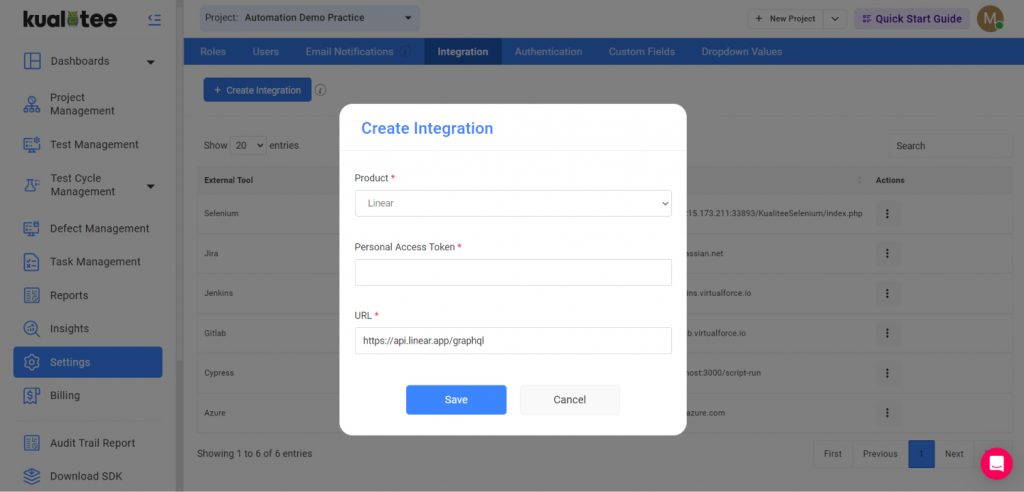
Configuration
To configure the two-way integration between Kualitee and Linear, you need admin access on the tools. The integration is basic, with hard-coded field to field mapping.
To Configure:
- Go to Settings and select Integration from the top bar
- Go to ‘Create New’ in the external tool integration listing
- Select Linear tool from the drop-down menu
- Enter the personal access token of your Linear account
Click ‘Save’ button to confirm a successful integration and to start syncing tasks from Linear to Kualitee as Defects.
Go to ‘Edit Integration’ to map the Linear task with Kualitee Project.
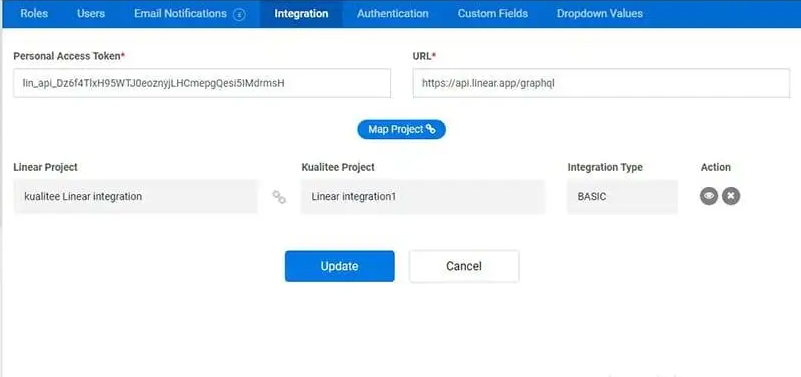
Map your projects with your Linear tasks by selecting the information below.
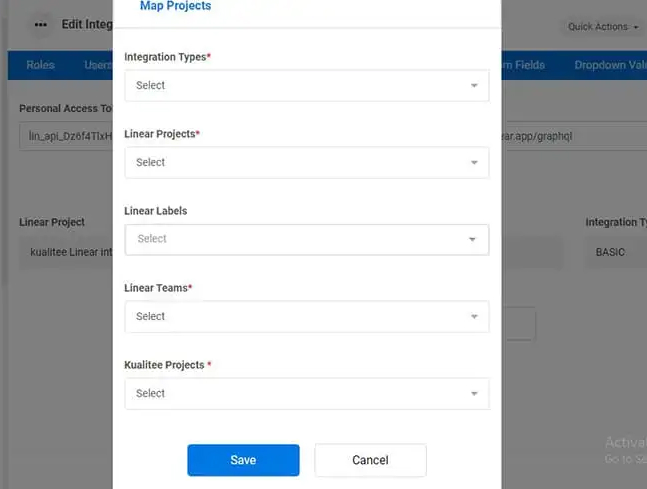
The basic mapping is a hard-coded field to field mapping between Kualitee and Linear. Below is a table that shows the mapping for each field.
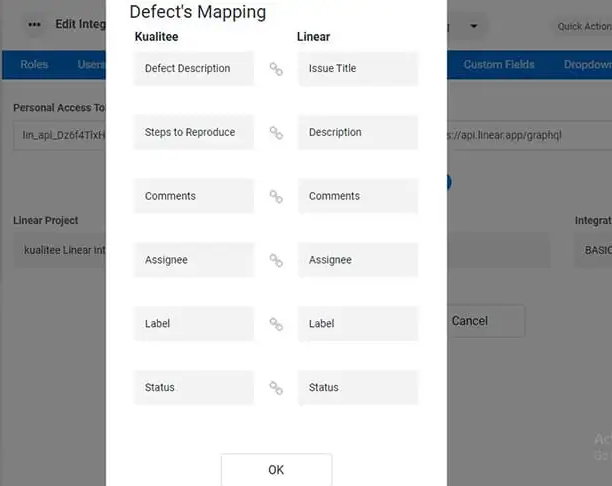
Redmine
Kualitee has integrated itself with Redmine. This exclusive two-way integration allows you to sync your issues between Kualitee and Redmine. Each Redmine project can be linked with a Kualitee project to sync all reported issues in both projects. Since its a two-way integration all updates made on the issue will automatically get synched that includes a change in status, additional comments and association changed through Kualitee.
Creating Redmine Integration
To integrate with Redmine, you click on ‘create integration’ in settings and choose Redmine from the product. Provide your email, password, and domain URL to successfully create domain level integration.
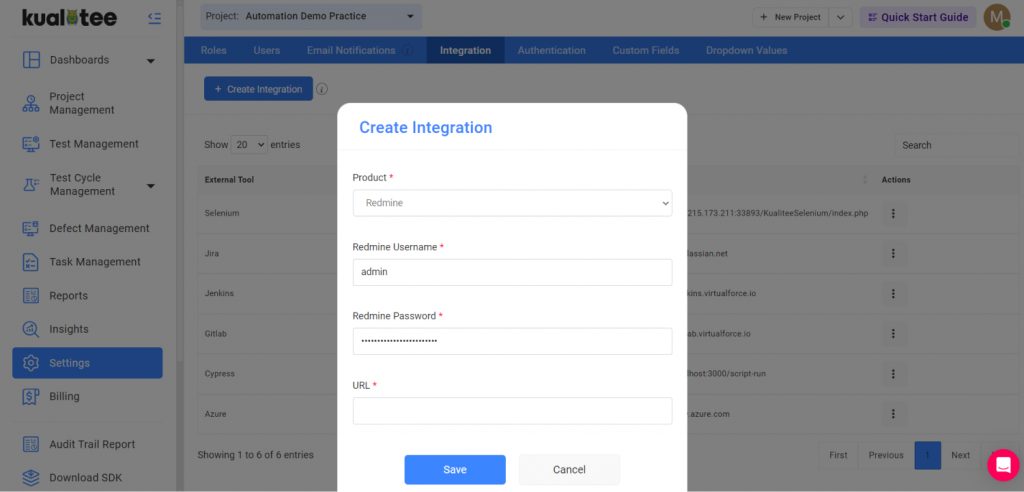
Once the integration is created, the next step is to map projects.
Under the Redmine Projects, you will see the list of projects you have in Redmine. While in the Kualitee project you will see the list of projects you have on Kualitee.
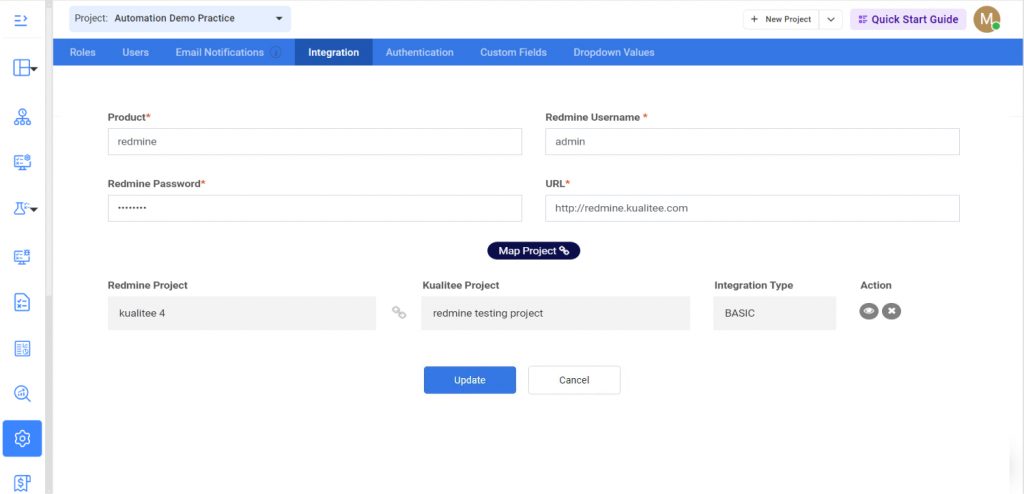
The basic mapping is a hard-coded field to field mapping between Kualitee and Redmine. Below is a table that shows the mapping for each field.
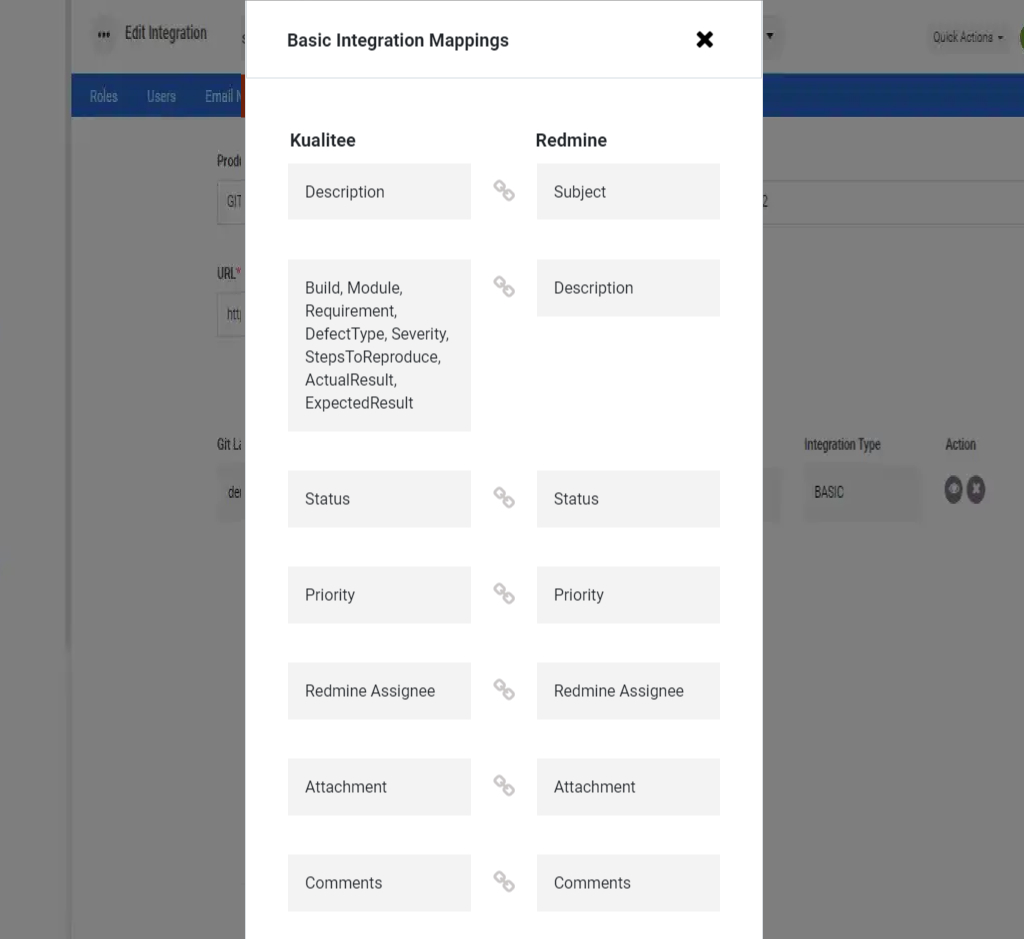
Selenium
Configurations:
For configuring Selenium, there are some pre requisites for it as under.
- Windows/Mac/linux server/system providing Public IP address to access
- Apache (For HTTP requests) normally we use xamp/wampp for it
- Download Kualitee selenium plugin
Public Ip:
Kualitee product will need a gateway to enter the environment where the scripts are going to execute. For that whatever environment you are using must have a public IP.
Apache:
You will need to have apache server setup, normally we use xampp/wampp for it.
Plugin:
Once Public Ip is ready and you have installed xampp. Go to Htdocs directory
(e.g. /var/www/html on a ubuntu machine and for windows xampp/htdocs/)
Once you are in the right directory, just download and unzip Selenium plugin in htdocs directory as:

Once all these things are done, your apche server is up, you have installed xampp/wampp and in htdocs you have unzip the plugin.
You have to try out the url to know if you are set to move a head as
e.g http://172.27.5.19/KualiteeSelenium/index.php
Syntax is [IP address]:[port if any specific]/pluginName/index.php
If you are not able to see blank page, this means you have connection issue and you need to connect with IT support team of kualitee.
Considering successful configuration,
You have to go to your kualitee application, and settings for jumping on to Integrations tab Now you have to add this url in the integration section and selenium tab as

Once you have pasted the url and saved it without any errors, you are all set with the integrations.

This means you have successfully configured the Integration.
Now lets setup one test case to perform automation
For creating your first automated test script, you will have to follow below steps
- Create a test case and set execution type to be automated on Test Management Tab

- Add your automated test case in any cycle you want to execute
- Go to Execute option and run your test case by clicking execute option
Go to Test Lab and test execution section as
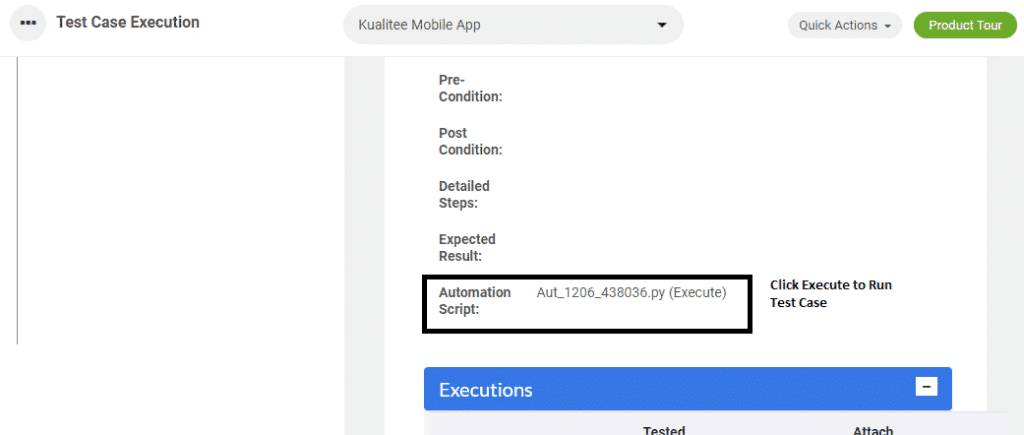
Here is the sample code snippet:
Make sure the driver you are going to use is placed in the server/system configured for automation. Like “C:\\xampp\\htdocs\\kualiteeSelenium\\chromedriver.exe”

Kualitee expects Status as parameter from the user to consider the test case to pass or fail.
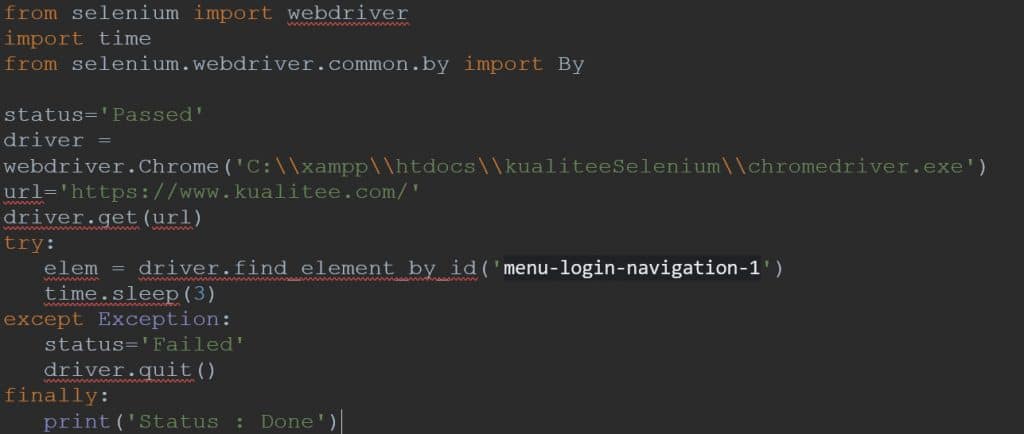
Slack
Kualitee seamlessly integrates with Slack, a leading team collaboration platform. This integration allows you to effortlessly sync Kualitee issues with Slack channels, ensuring your teams stay connected and can take swift action without switching between apps.
Create Integration
To configure the integration between Kualitee and Slack, you need admin access on the tools. The integration is basic, with hard-coded field to field mapping.
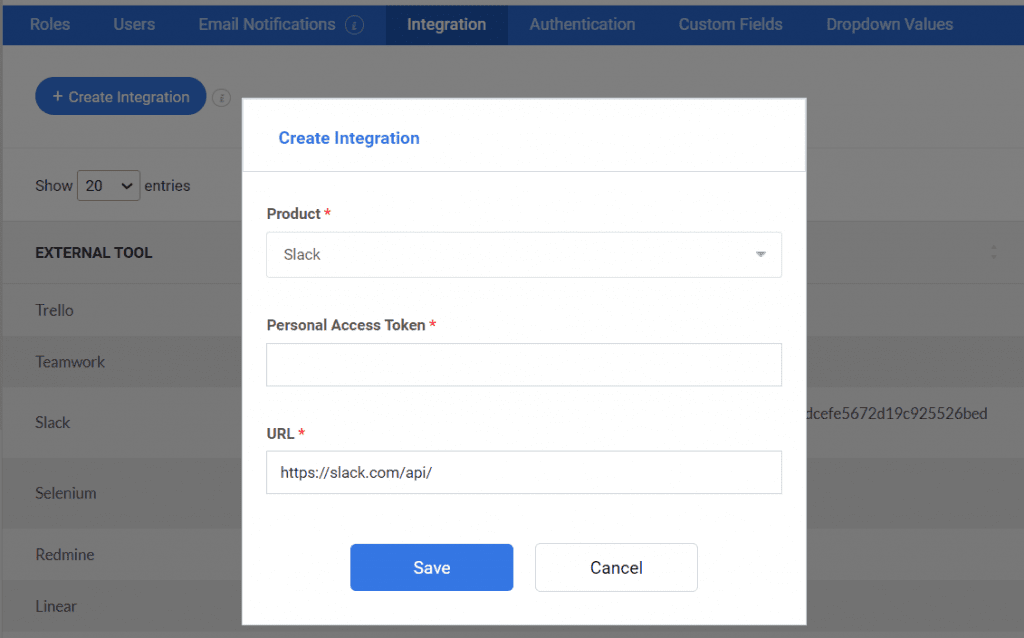
To Configure:
- Go to Settings and select Integration from the top bar
- Go to ‘Create New’
- Select Slack tool from the drop-down menu
- Enter the details of your Slack account
- Click ‘Save’ button to confirm a successful integration and to start syncing defects from Kualitee to Slack.
Edit Integration
Go to ‘Edit Integration’ to map the Slack channel with Kualitee Project.
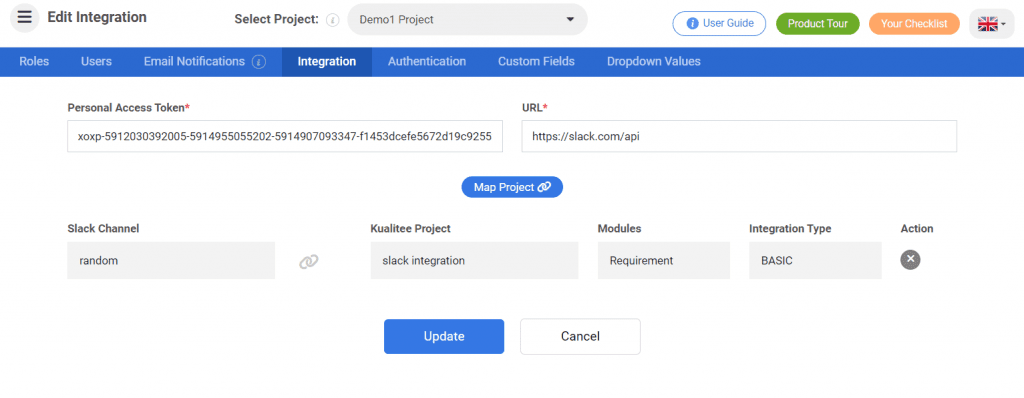
Map your projects with your Slack channels by selecting the information below.
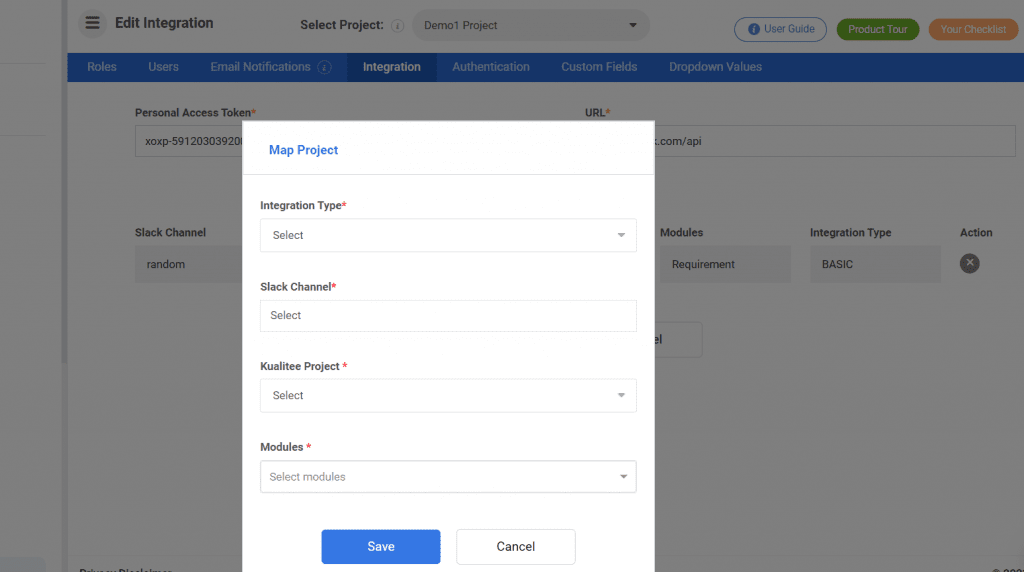
This integration can be mapped seamlessly with the Defects and Requirements modules.
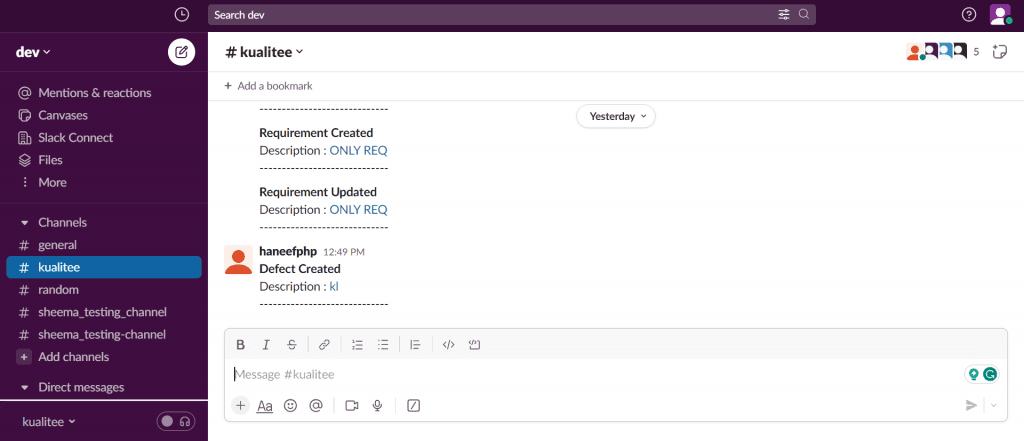
How to Build Integration with Kualitee on Slack
On Slack, you will need to access your User API token which can be generated by the following steps:
1. Visit the link https://api.slack.com/
2. Click on the Apps (top right corner) after login
3. Select Workspace
4. From the left menu click on Feature
5. Click on OAuth & Permissions
(Scopes of the token are mentioned below)
7. Copy the User OAuth Token
8. Go to the Kualitee -> Settings -> Integrations
9. Create Integration by adding User Oauth Token
10. Click Save
11. Click on Edit Icon
12. Click on Map Project
13. Select Integration Types “Basic”
14. Select the channel from your workspace
15. Select the module i.e. Defect, Requirement etc.
16. Click Save
If you have selected the Defect Module and you have created the defect, a message will be shown to the selected Slack channel.


Azure AD
Azure Active Directory (Azure AD) is an identity and access management solution that enables seamless and secure user authentication into applications. With Kualitee’s Azure AD Authentication, you can provide your users with a centralized and authenticated access system.
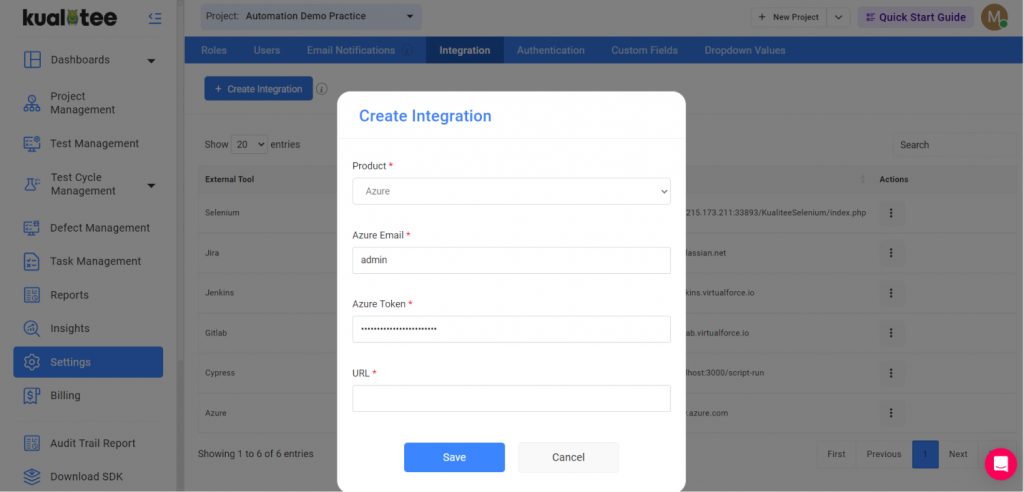
Configuration Steps
Click ‘Save‘ for successful authentication and to start login using Azure authentication.
- Sign in with your Microsoft account
- Click on “Enterprise Application” or search for “Enterprise Application”
- Click on “New application” button
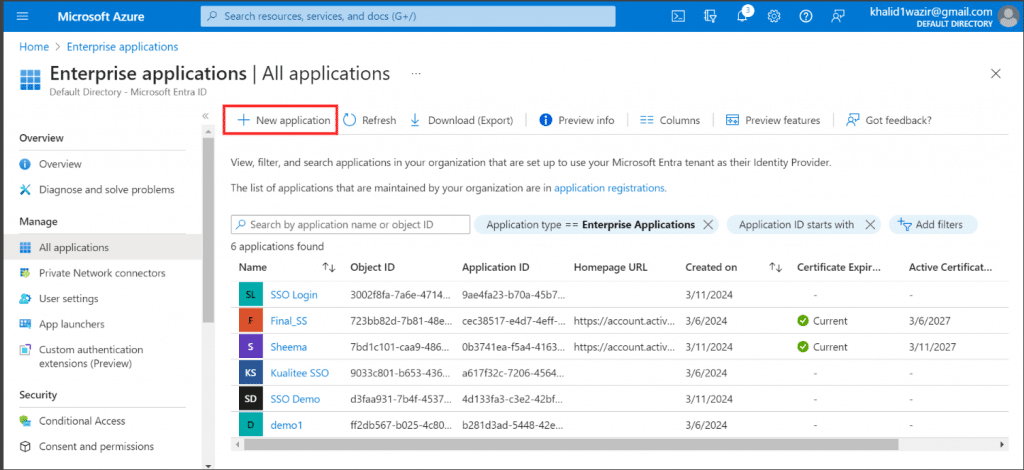
- Click on “Create your own application”
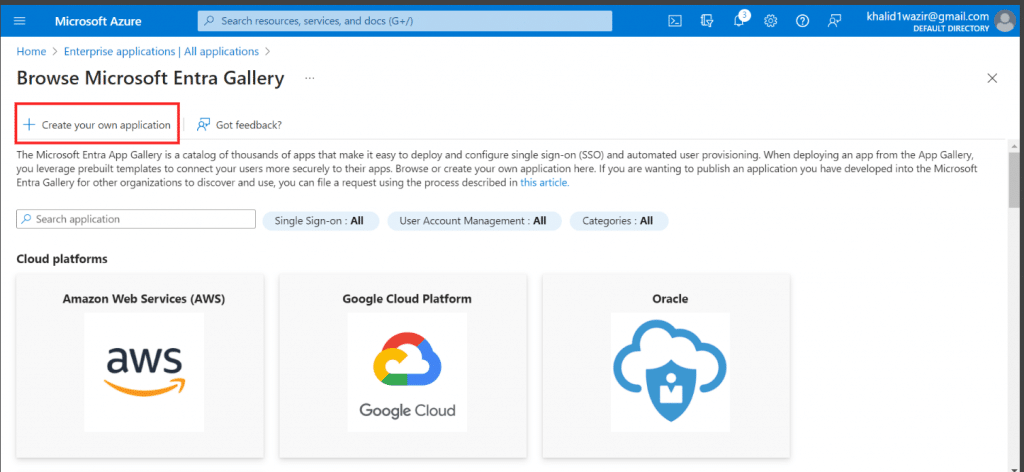
- Enter name and select option accordingly.
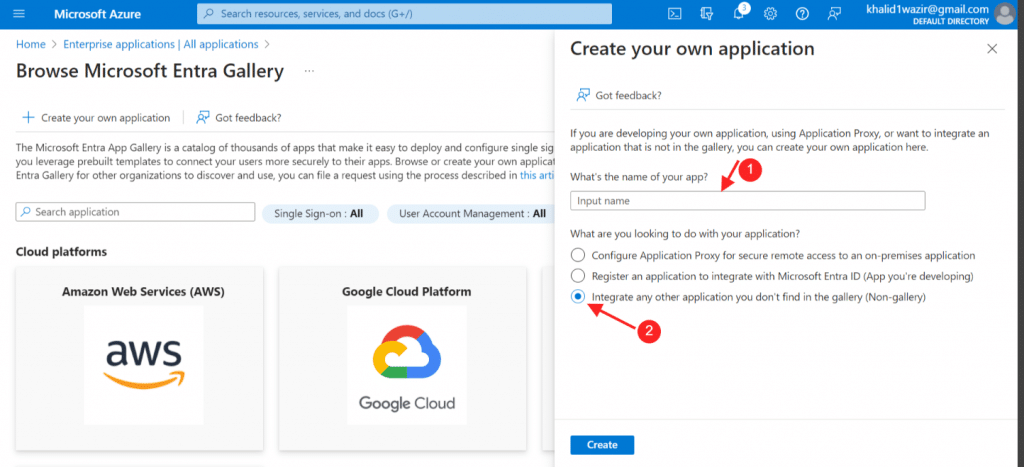
- Click on Setup single sign on option.
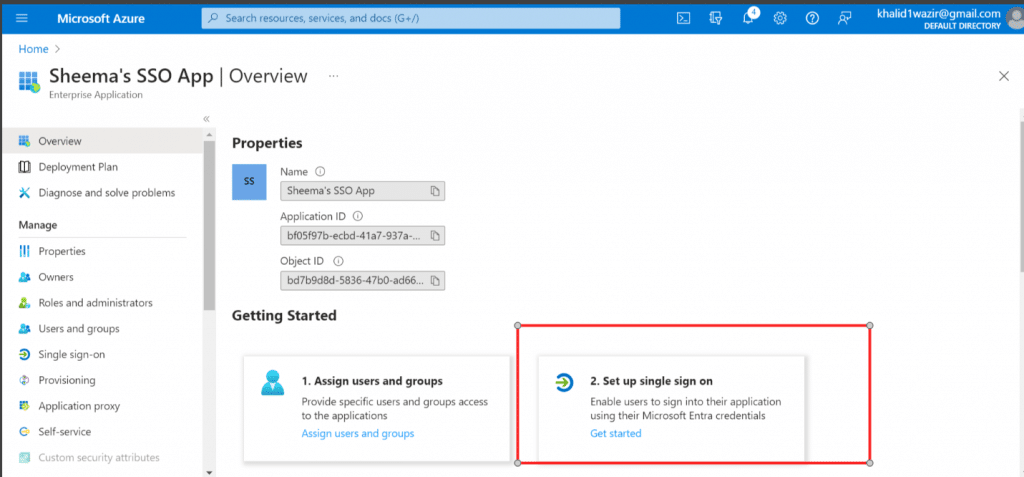
- Click on SAML
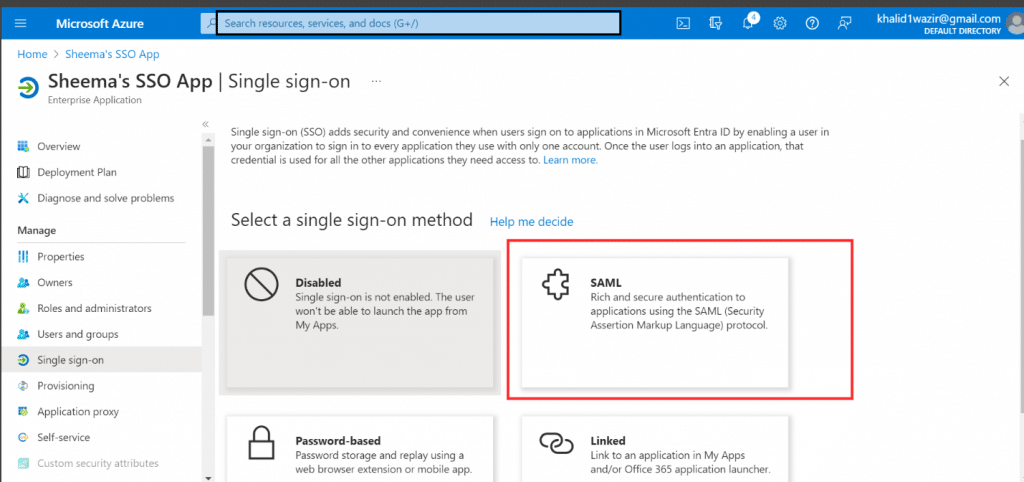
- Click on Edit icon and a side panel will open.
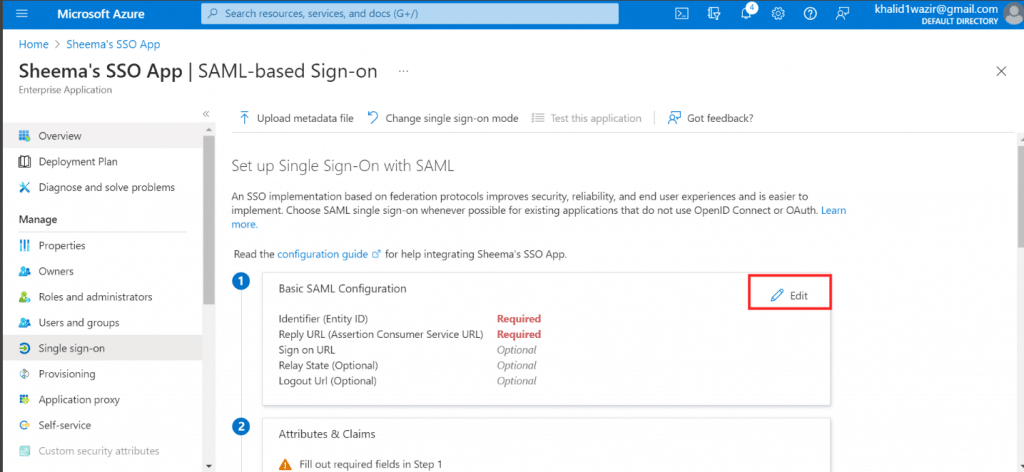
- Click on “Add identifier” and add any name and then click on “Add reply URL”. (Get the URL from Kualitee by following the below mentioned steps).
- Go to Kualitee domain. Settings > Authentications tab and select the tool as Azure.
- A popup will display, copy the URL from that popup and paste it in “Add reply URL” field.
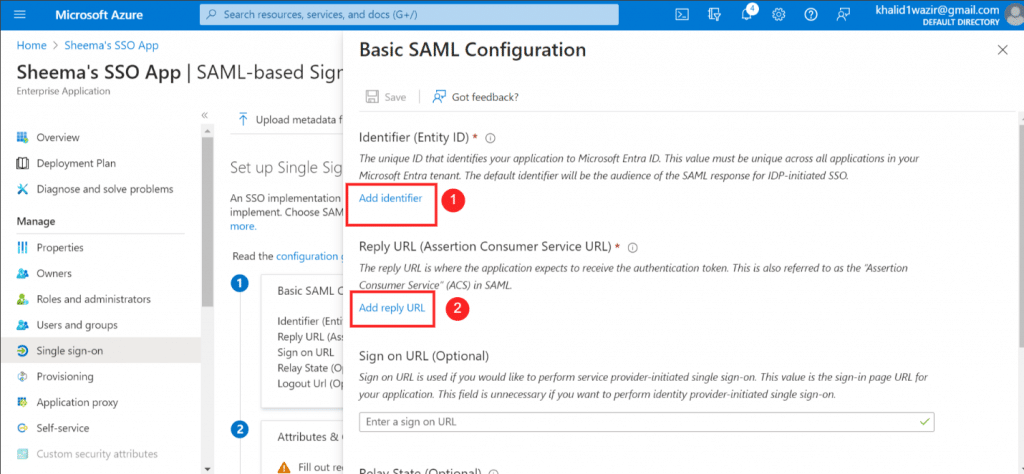
- Now back to Azure portal and click on overview option from right panel and navigate to Overview screen.
- Now click on “Assign users and groups”
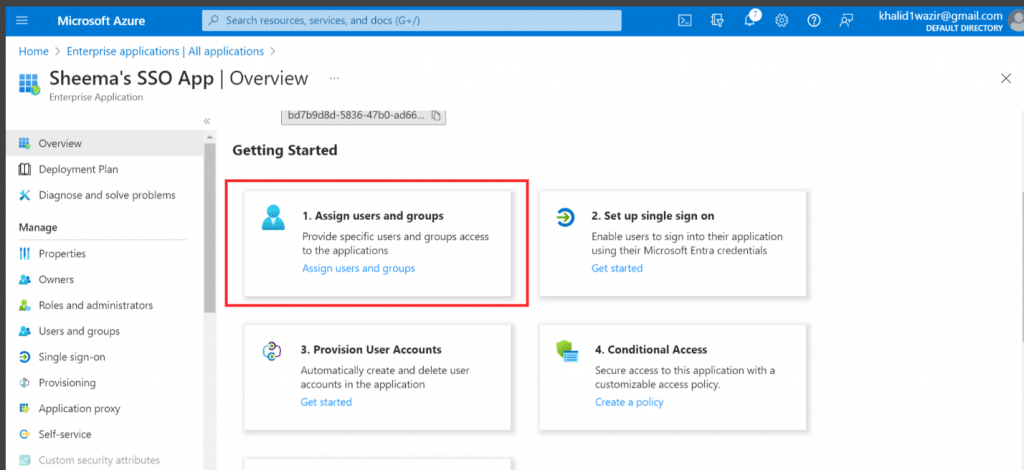
- Click on Add user button.
- Click on “none selected” under users, select the user, click on select button, and then click on Assign button.
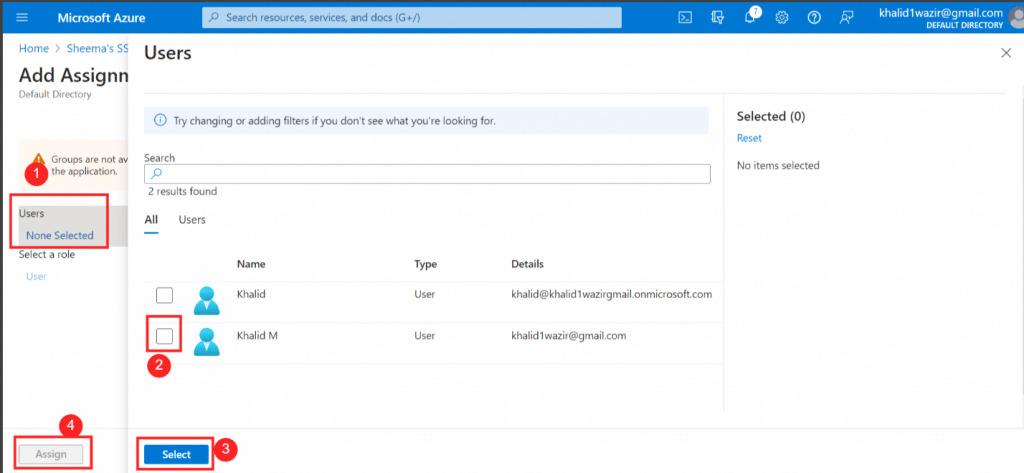
- Now search for “App registration” in the search bar at top.
- Select the option to view your application.
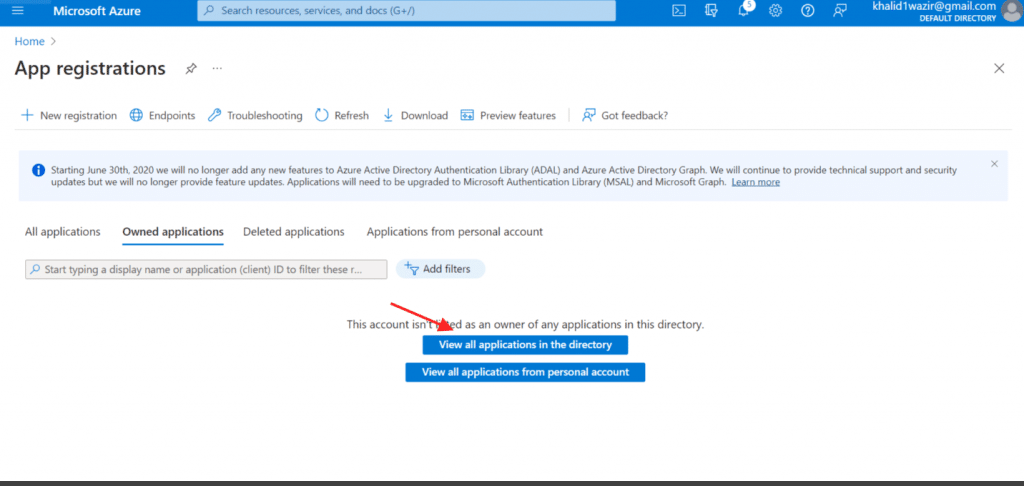
- Select your application and navigate to Application overview screen.
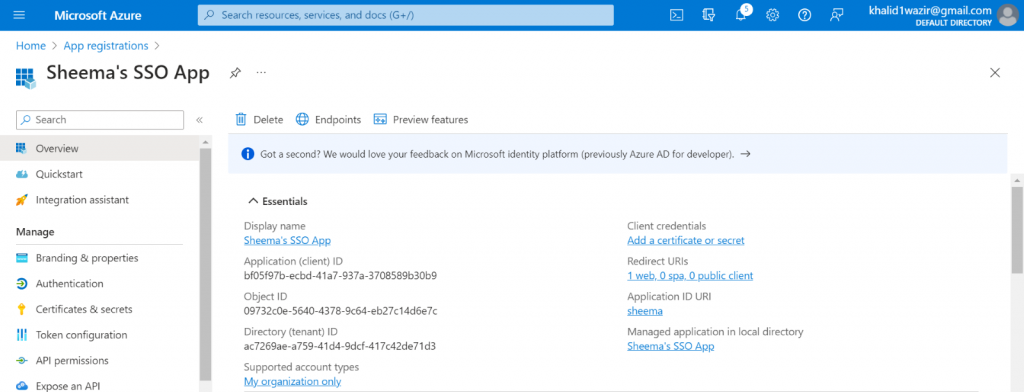
- Click on “Add a certificate or secret” option
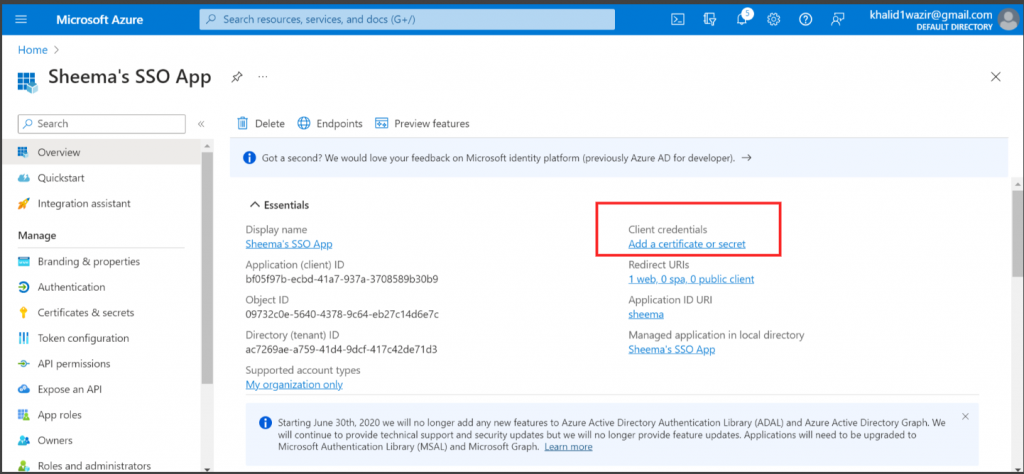
- Click on “New client secret” a side panel will open. Enter description, select expiry date and click on Add button. Your secret id will be generated
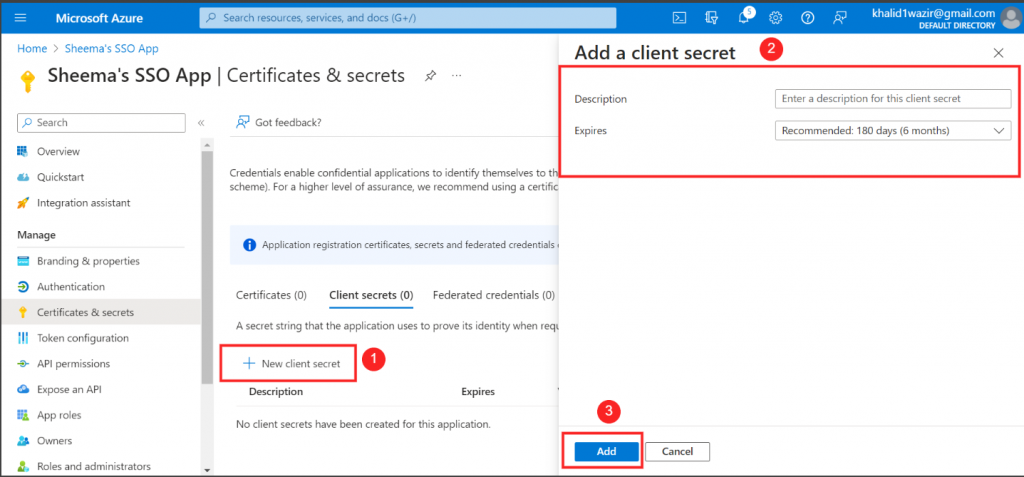
- Go to authentication tab from the right panel and select the “Access token” option
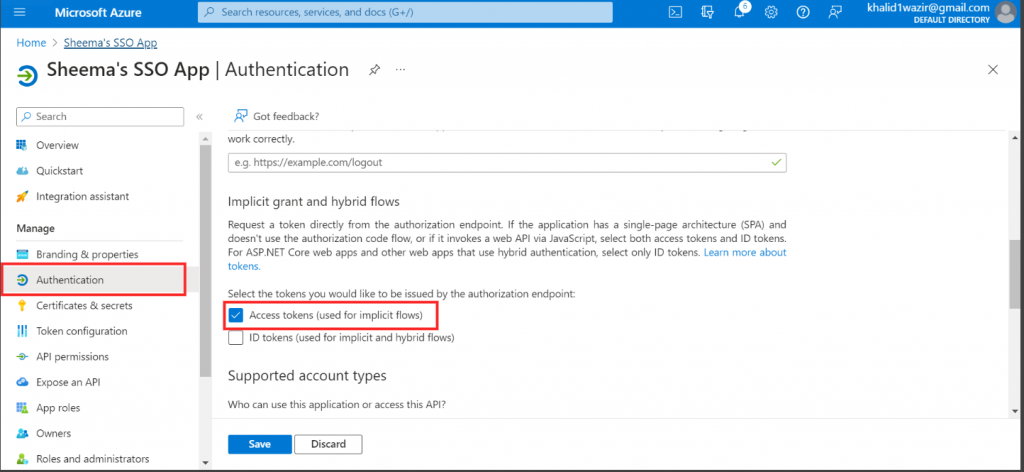
- Click on “Save” button and then click on “disable” button
- Now copy the Application ID, Directory (tenant) ID and secret key
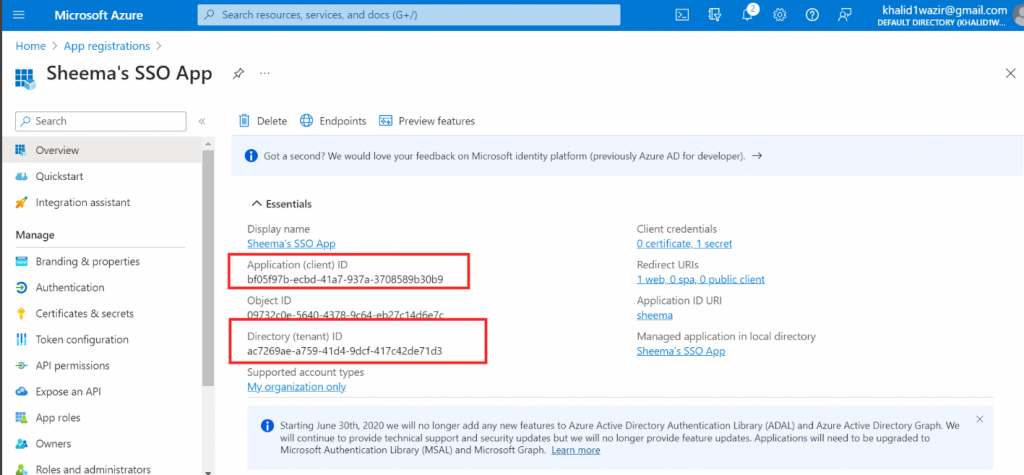
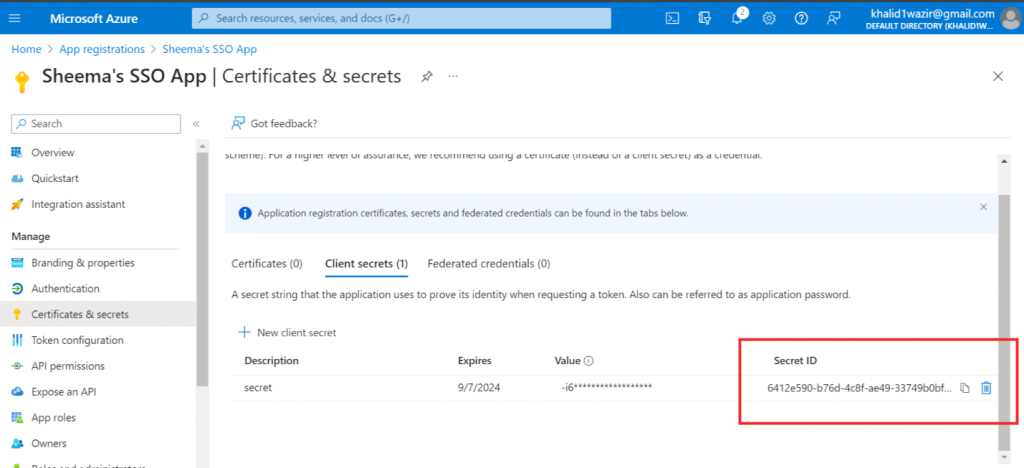
- Go to Kualitee domain. Settings > Authentications tab and select the tool as Azure
- A popup will display, paste the values in the field that we have copied in previous steps.
- Click on “save” button and set up is completed

- Now, logout your Kualitee and click on “Login with Azure” button on the login screen
- Select the account (give the permission if asks)
- You will be redirected to Kualitee dashboard.
Okta
Okta is a customizable, secure, and drop-in solution that helps companies manage and secure user authentication into applications. With the Kualitee-Okta SAML Authentication, Kualitee will be able to authenticate Okta users.
Configuration Steps
Go to ‘Create Authentication’
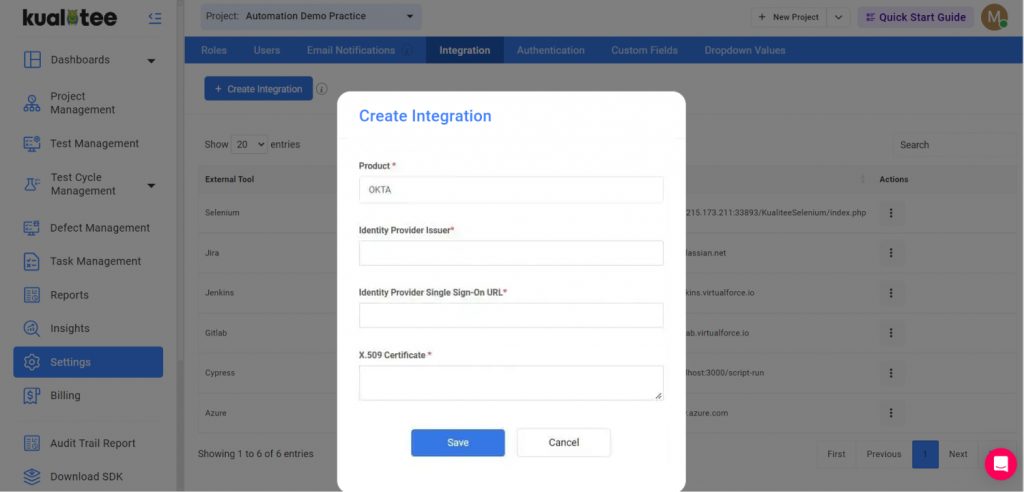
Before doing authentication with Kualitee, please configure the following SAML settings in Okta:
- 1. By creating app on Okta, you need to add this URL in single sign-on URL (https://apiss.kualitee.com/sso/okta/response).
- 2. Then add audience URL (https://apiss.kualitee.com/sso/okta/response).
You need the following information from Okta:
- Identity provider issuer
- Identity provider single sign on URL
- X.509 certificate
Add the above in Kualitee and your authentication will be set up. After saving this, a button with label ‘SAML login with Okta’ will appear on your login screen.
Test Case Library
Paid users can purchase pre-written test cases from Kualitee. This will save time and hassle from writing test cases from scratch.
Users can filter preferred industries and select specific test case types, including sub-categories. This function significantly reduces the time and effort typically required for creating test cases from the ground up. With an extensive library of pre-existing test cases, users can seamlessly integrate them into their testing procedures, eliminating the need for extensive manual test case design.
Steps
1. Go to the Test Case Library tab.
2. Subscribe to the repository to view all test cases and modules.
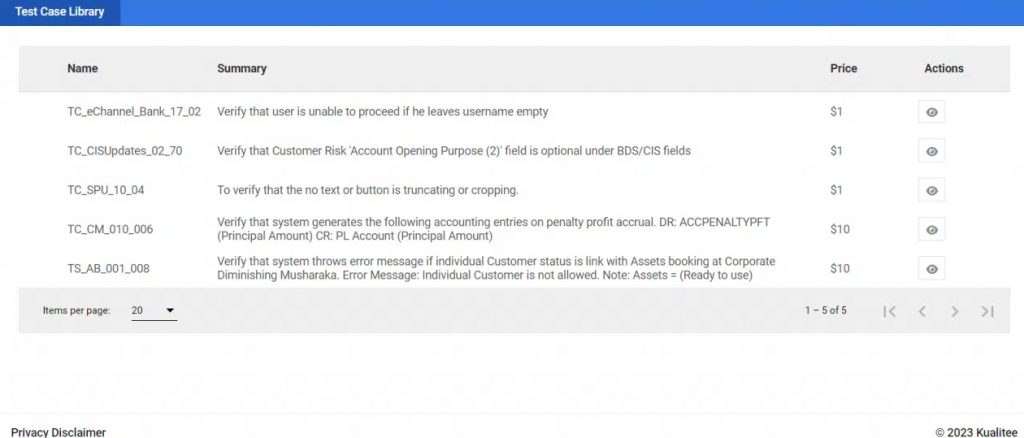
3. From the ‘Industries’ section, you have the option to choose the type of test cases you want, and then select your sub-category/categories of the selected type of test cases.
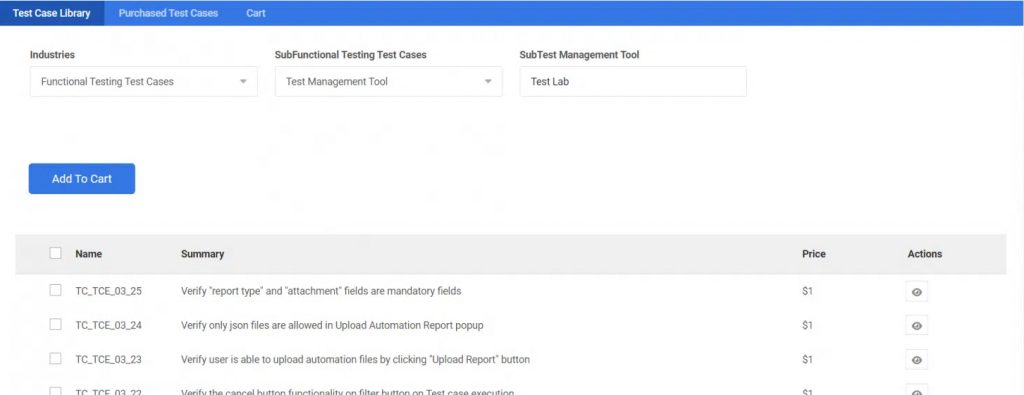
4. Add to cart once done.
5. You can review your selected items in the Cart and proceed to checkout to purchase your chosen test cases.
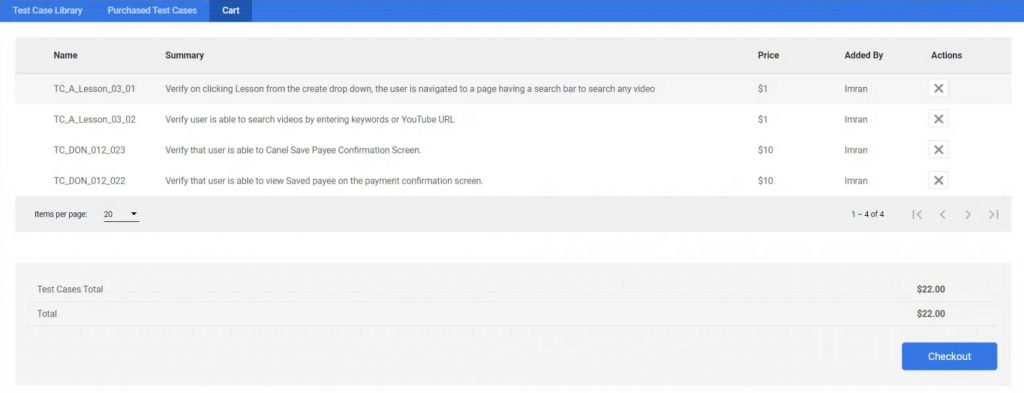
6. In the Purchased Test Cases tab, you can view the list/summaries of the test cases you have purchased and import the select test case(s) to your project.
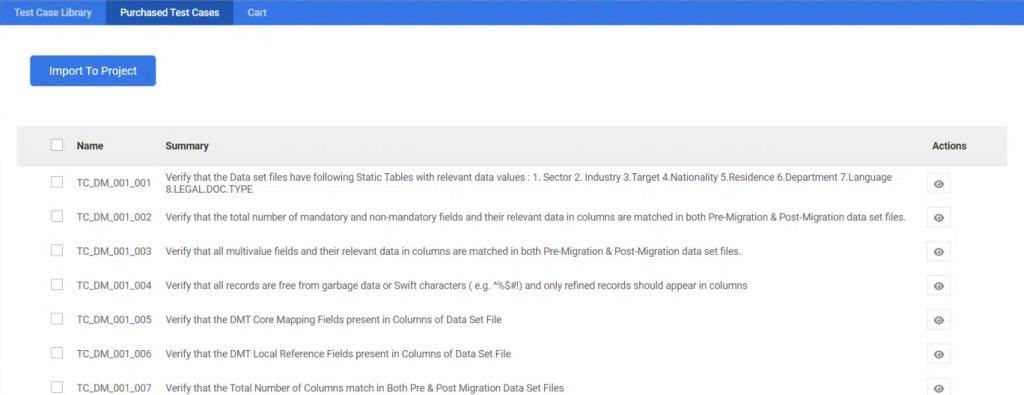
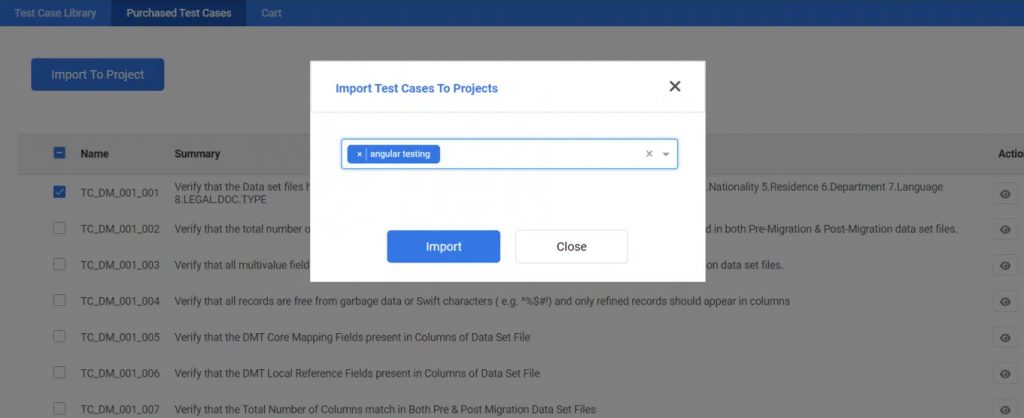
Custom Labels
The Custom Labels feature allows users to create and assign personalized labels to Requirements, Test Cases, and Defects for better organization and tracking. Labels can be created directly from their respective screens or from the settings menu.
How to Use Custom Labels
Creating a Custom Label from a Requirement, Test Case, or Defect Screen
1. Navigate to the Requirement, Test Case, or Defect where you want to create a label.
2. Expand the Additional details dropdown
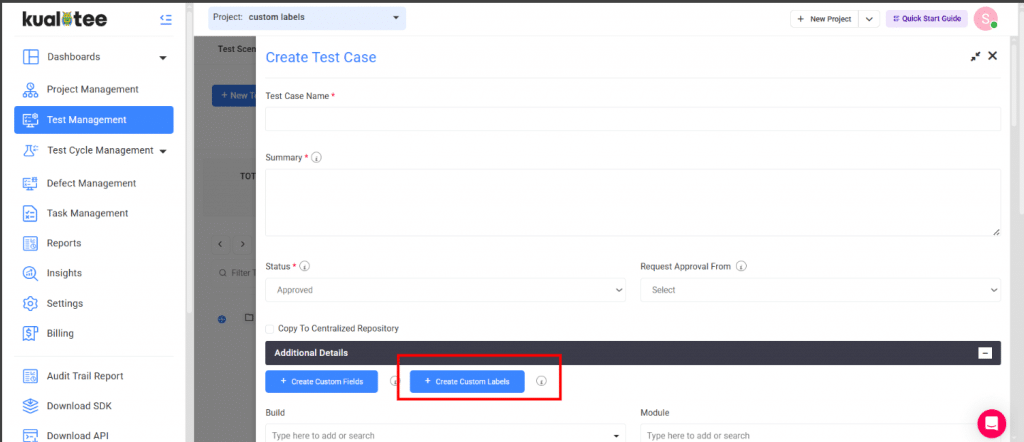
3. Click on the Create Custom Labels button
4. Enter a Label Title.
5. Choose a Color for the label.
6. Click Save.
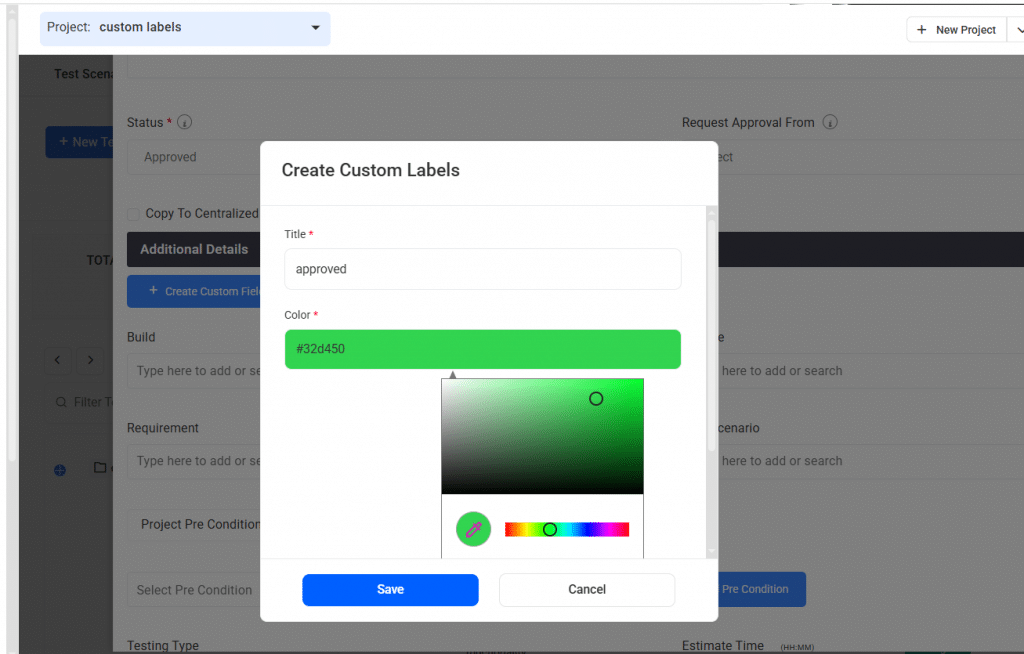
Custom label field will be available in the module where you can select your labels.
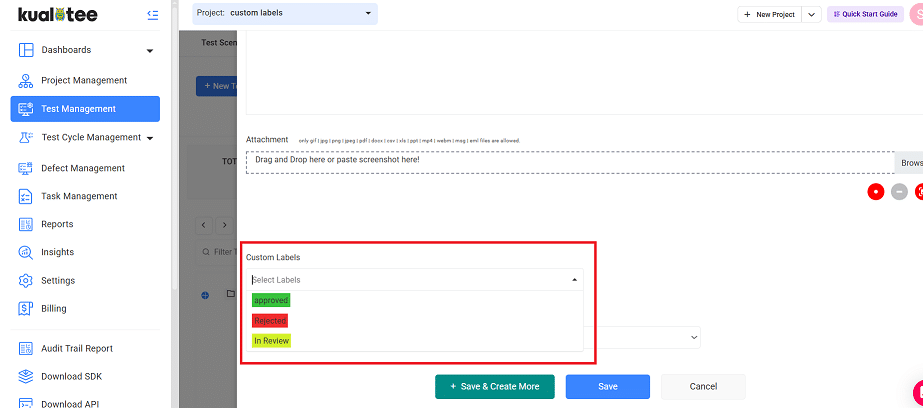
Creating a Custom Label from Settings
1. Go to Settings.
2. Click on Configurations > Custom Labels.
3. Click on Create Custom Labels button
4. Select the project in which you want to add custom labels
5. Select module in which you want to add custom labels
6. Enter a Label Name.
7. Choose a Color.
8. Click Save.
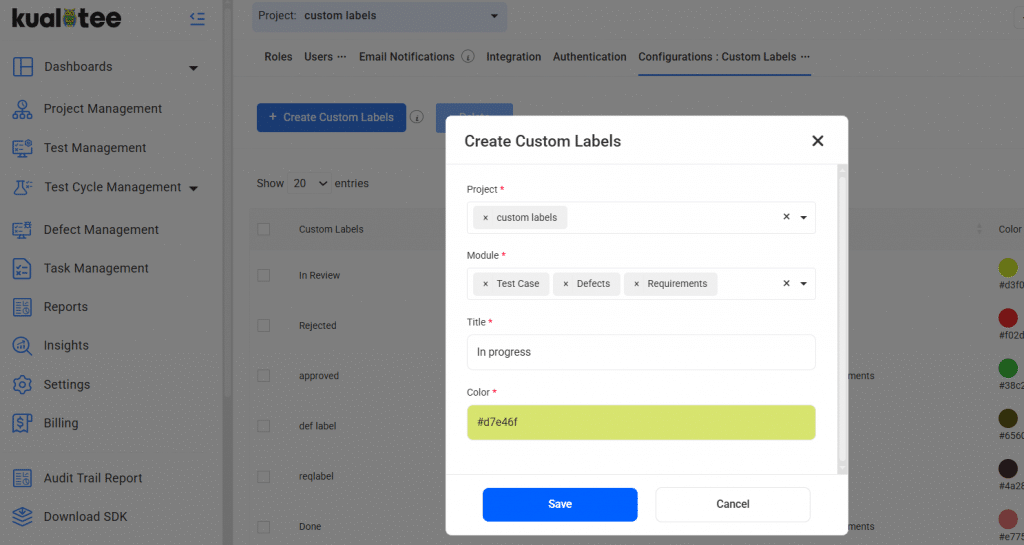
Labels created from settings will be available for use in Requirements, Test Cases, and Defects.
Managing Custom Labels
- To edit a label, go to Settings >Configurations > Custom Labels, click on the label, update the module or color, and save.
- To delete a label, click on the delete icon next to it in the Actions column





















